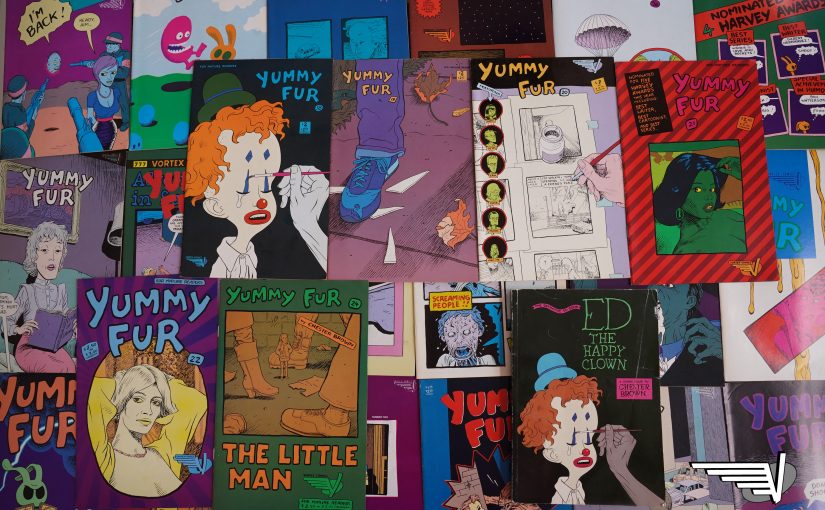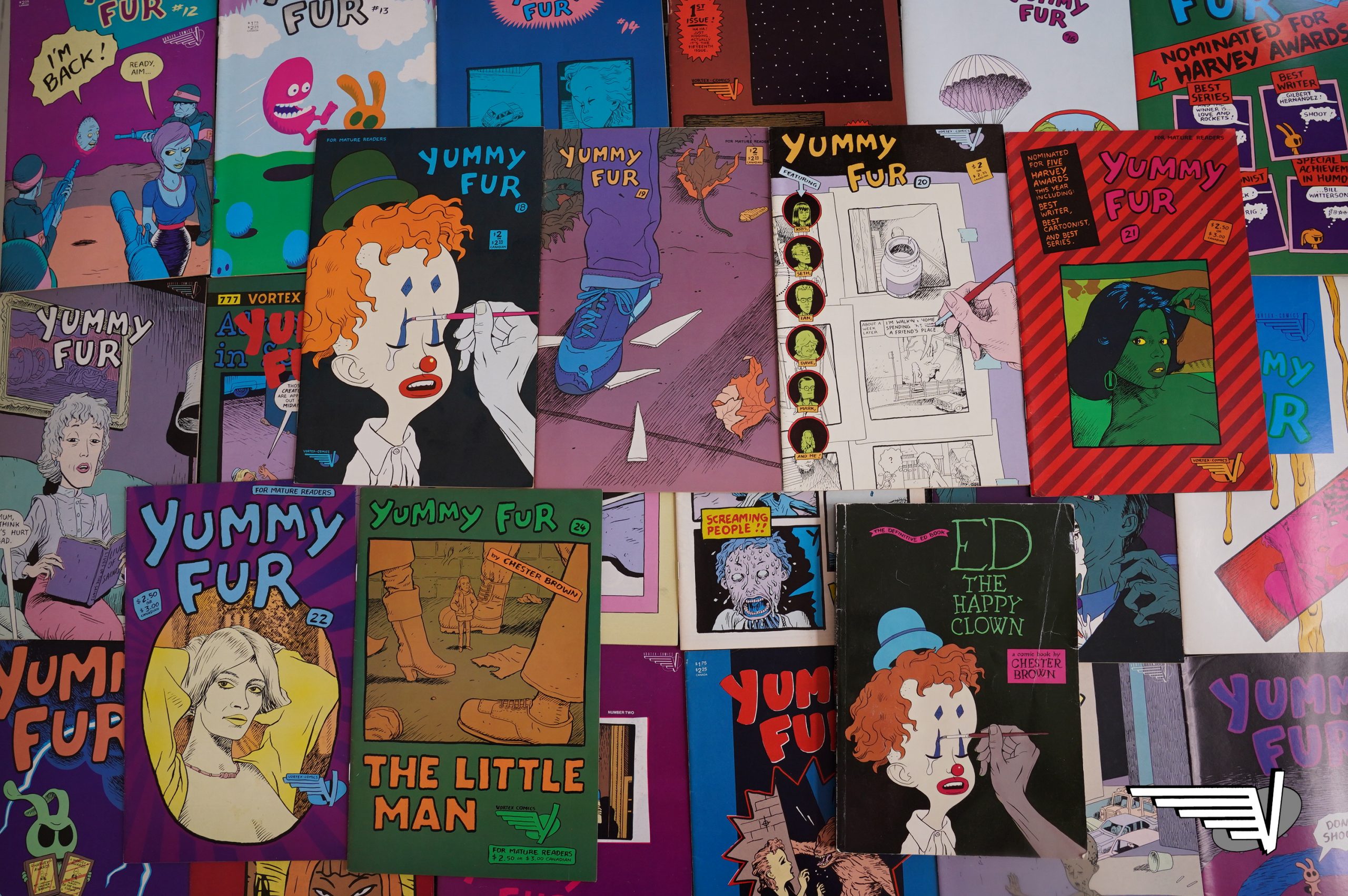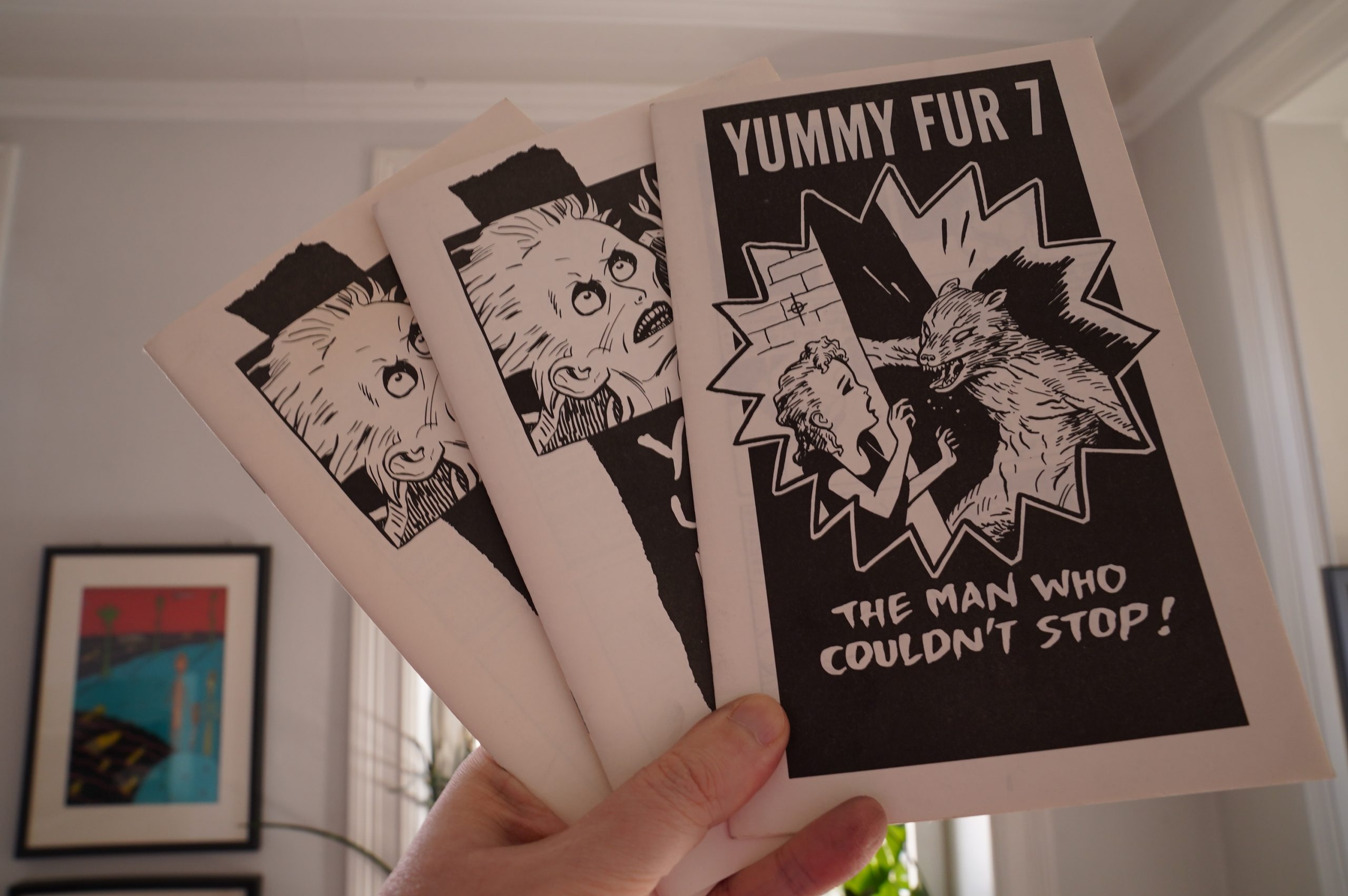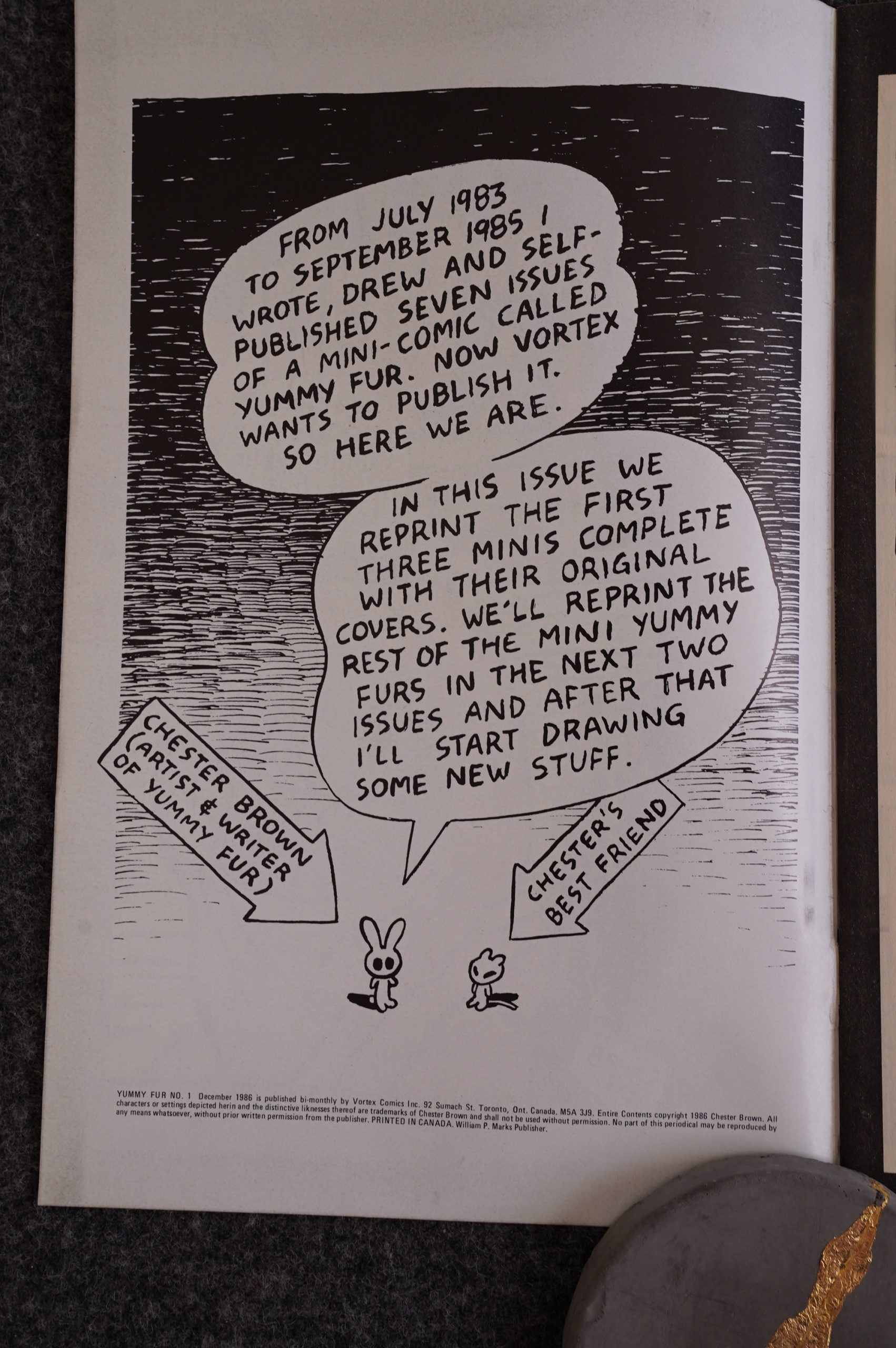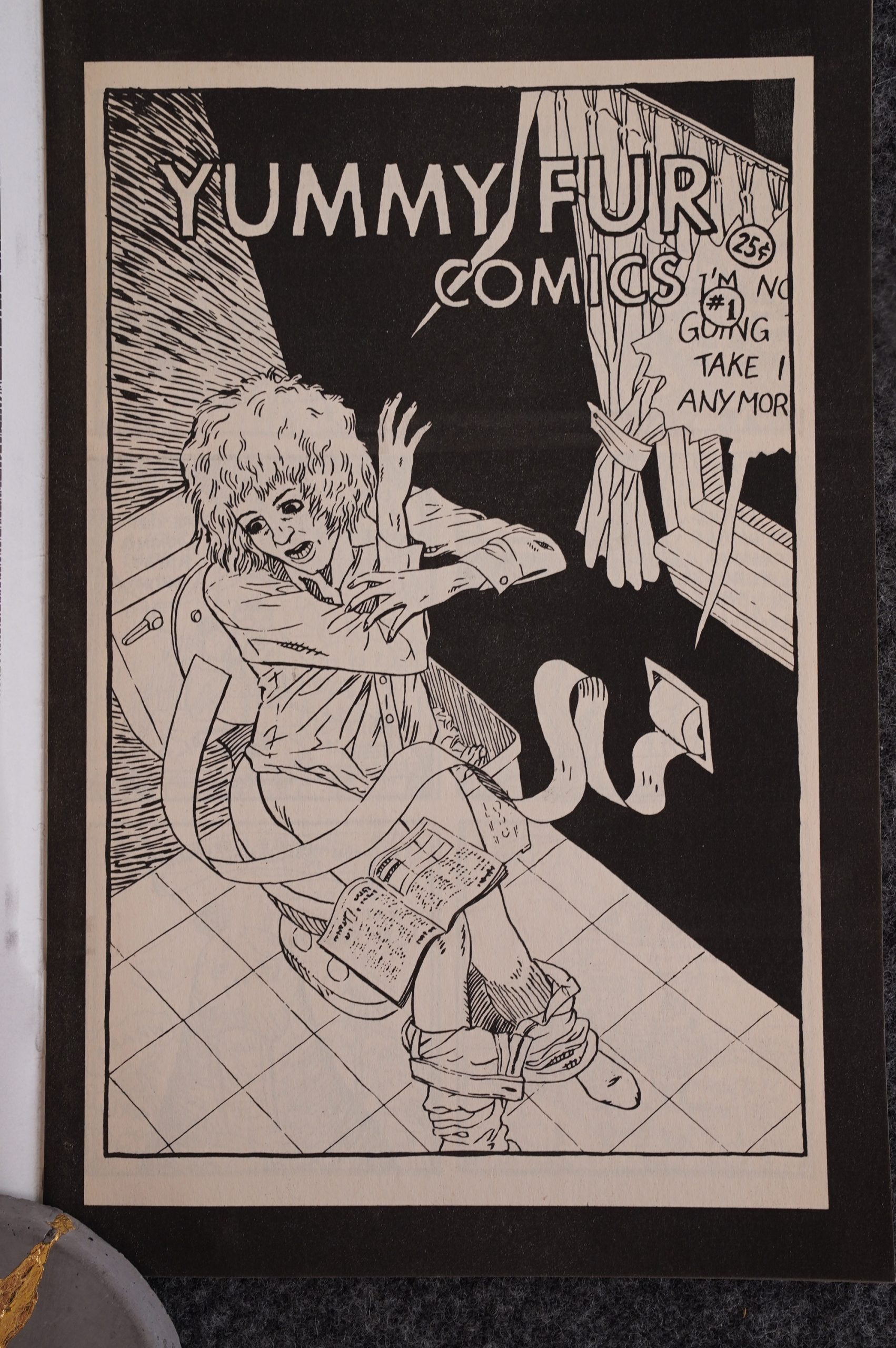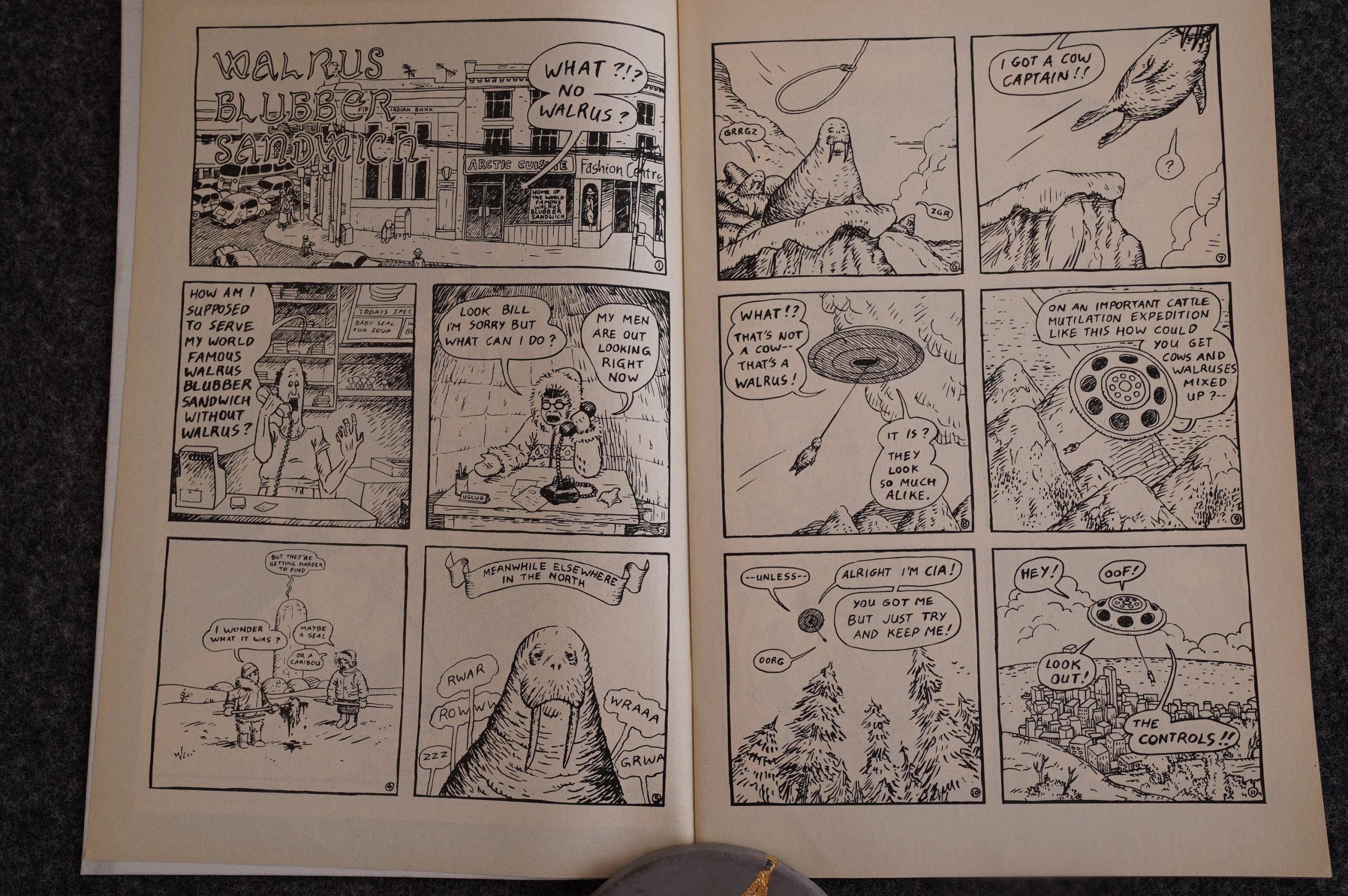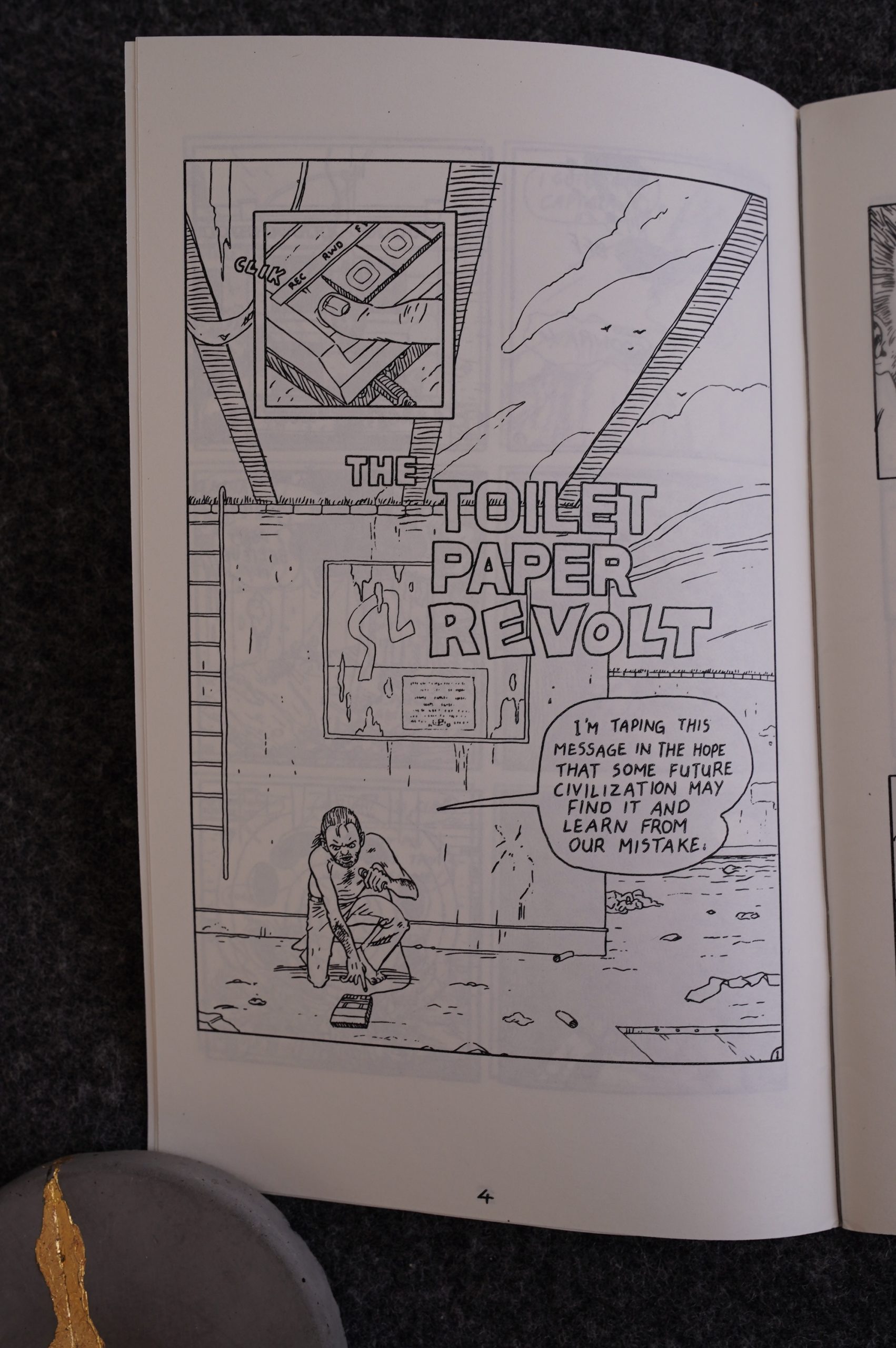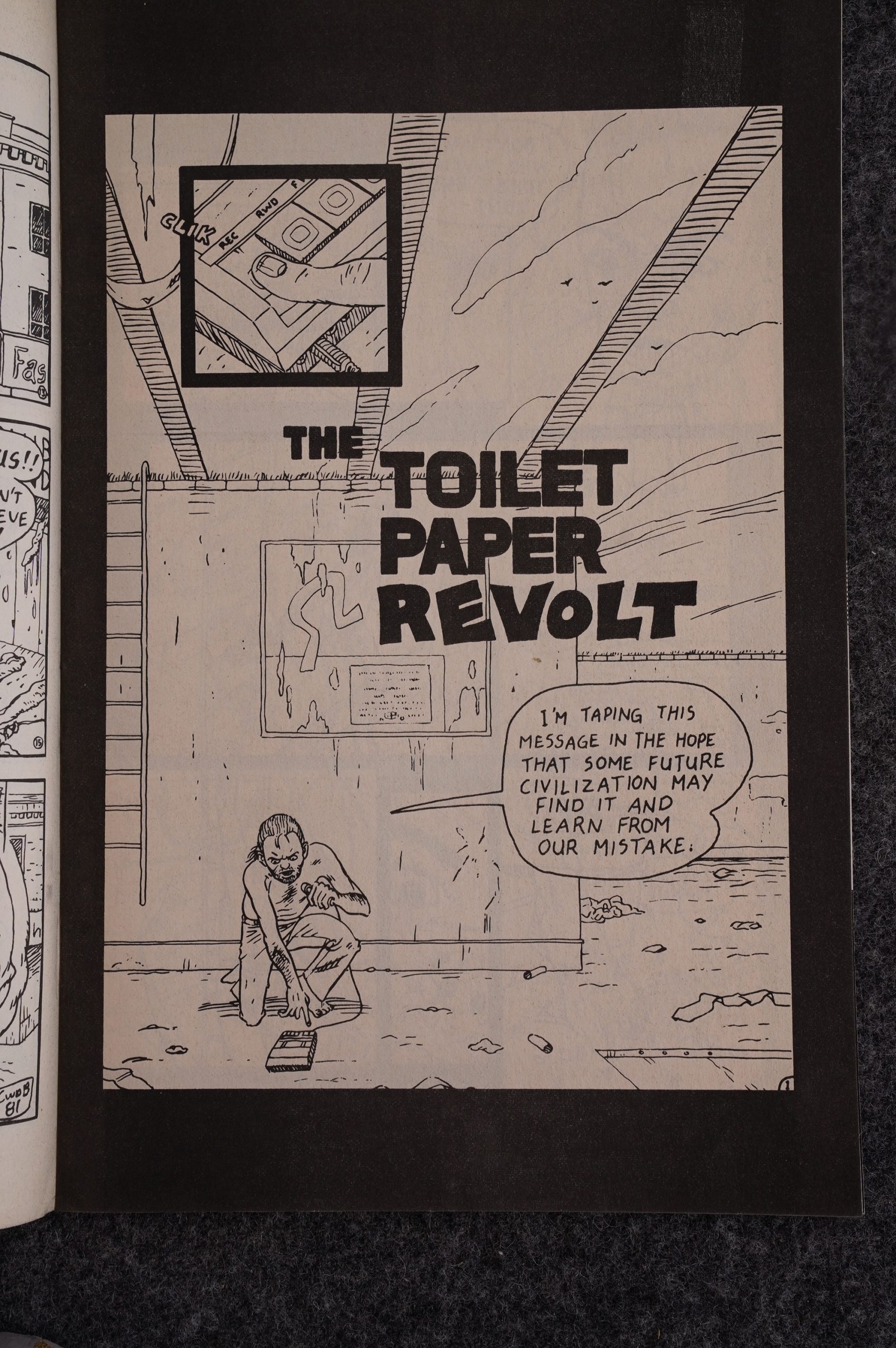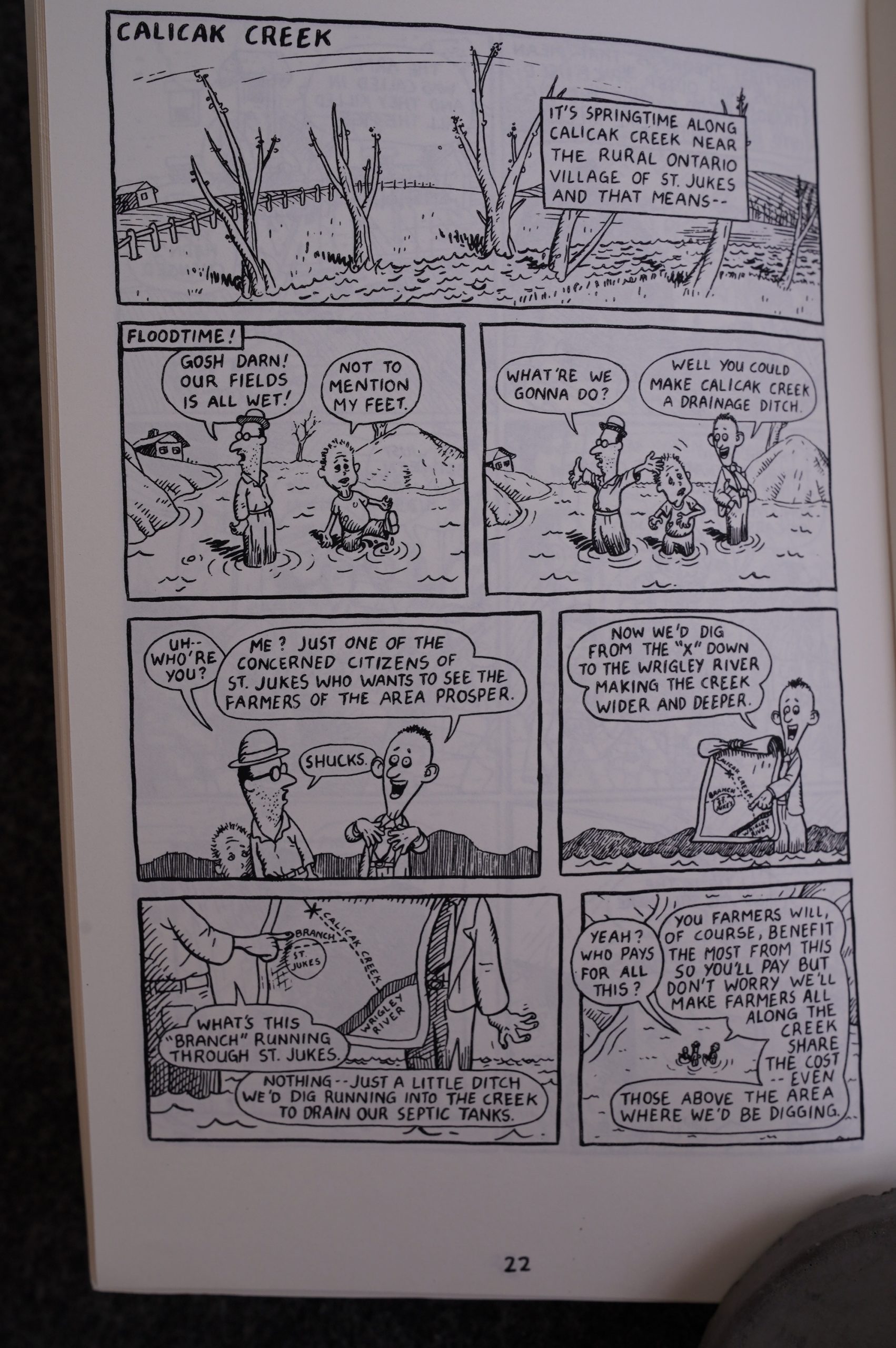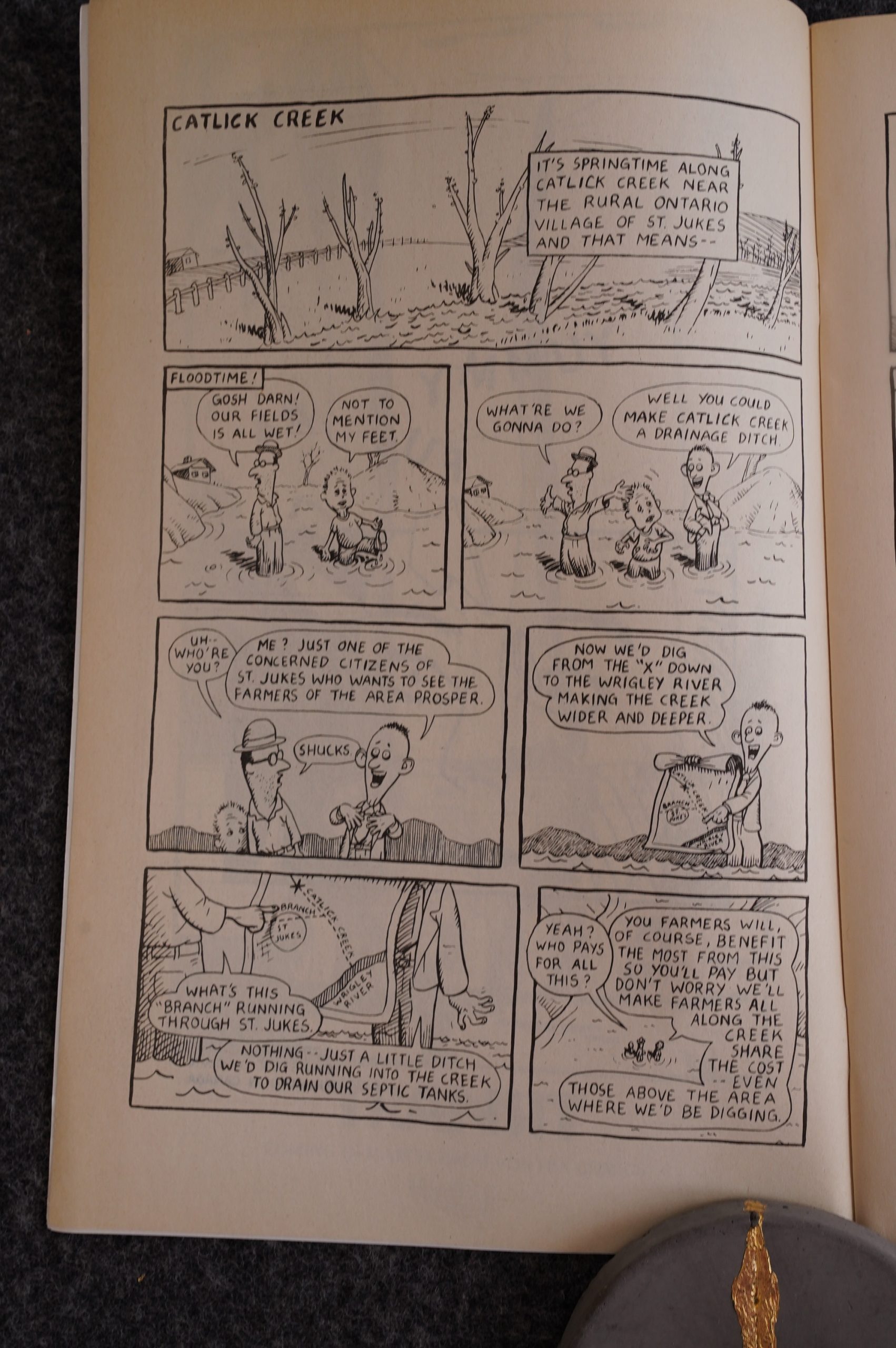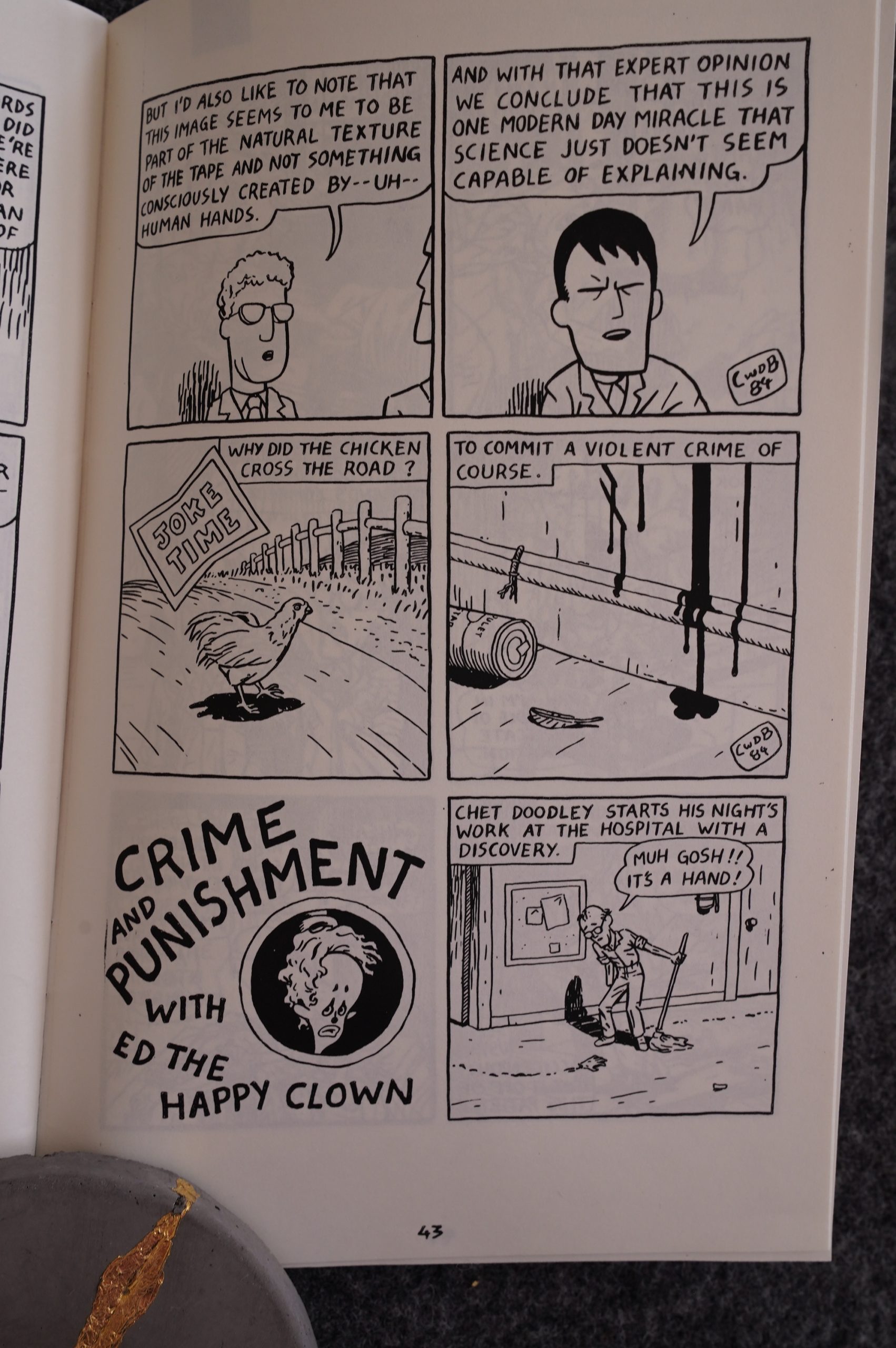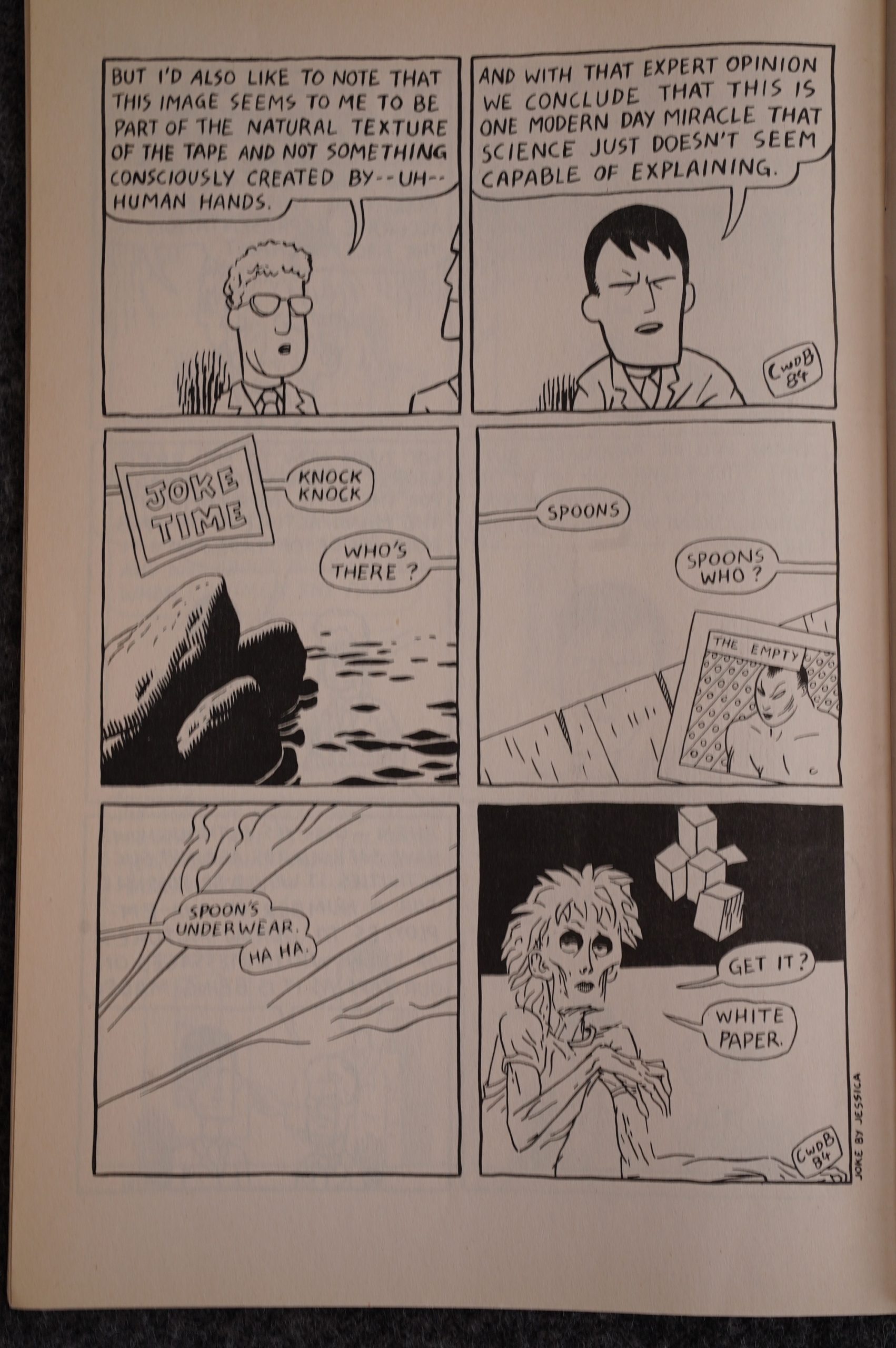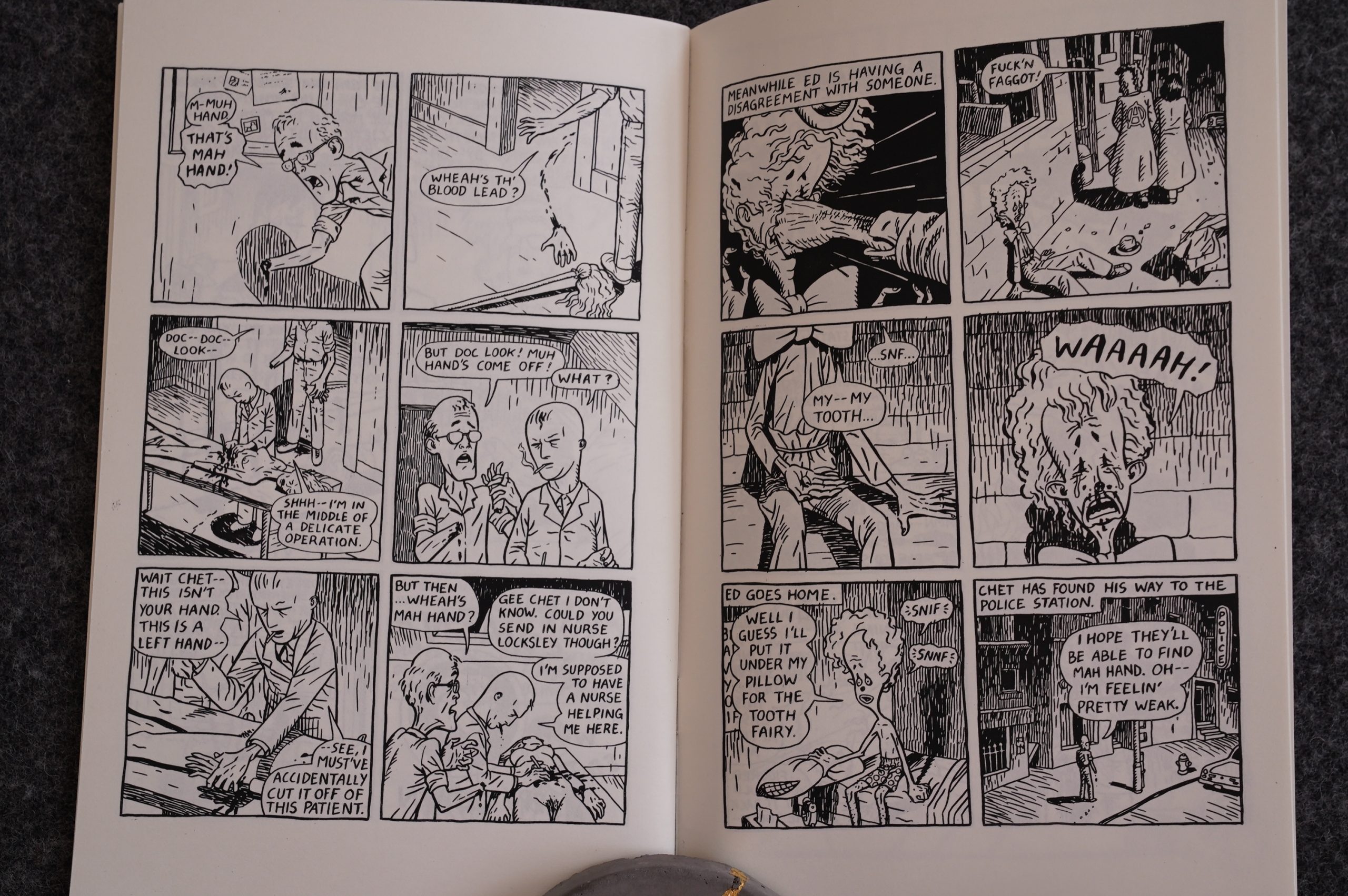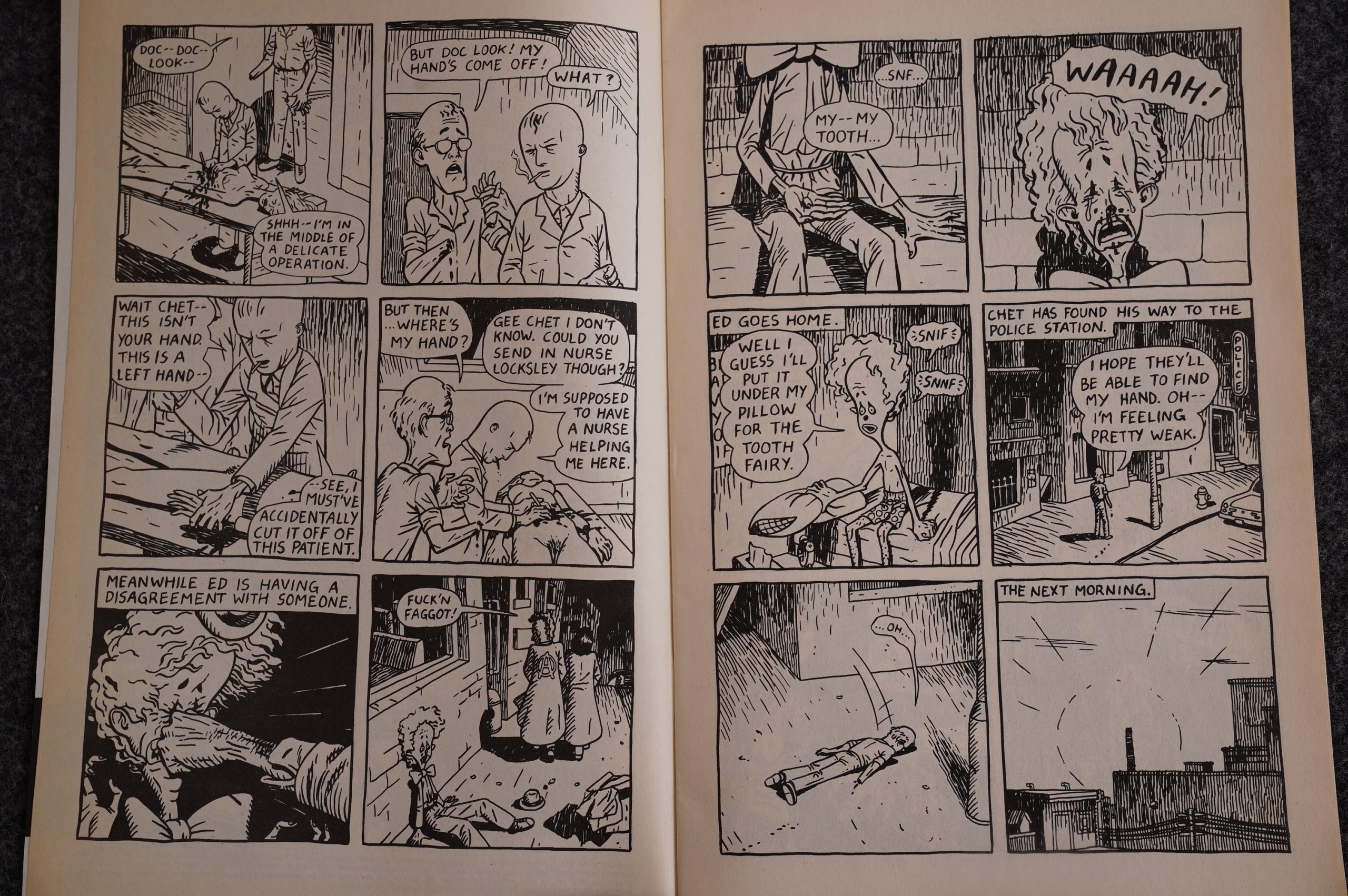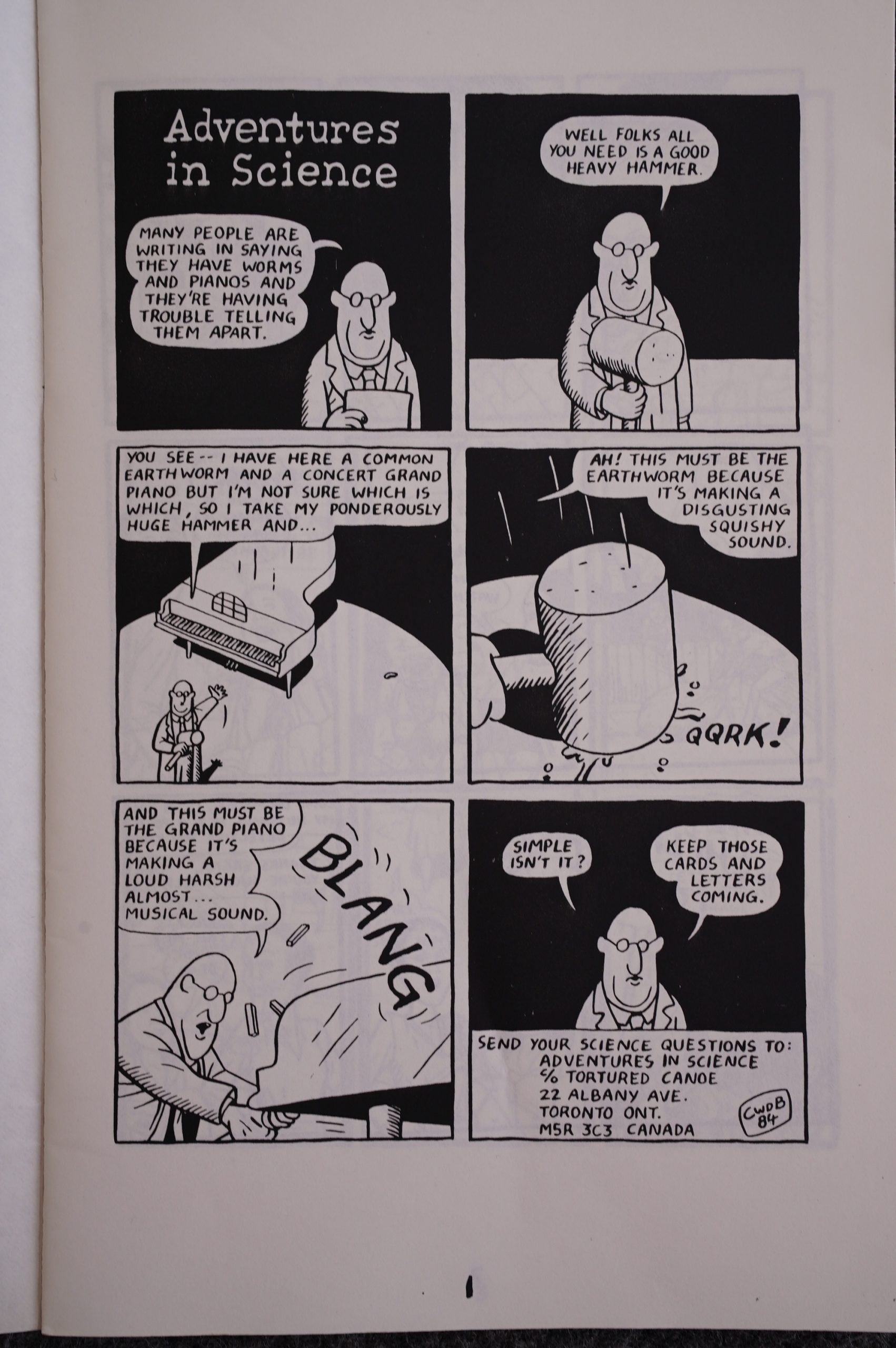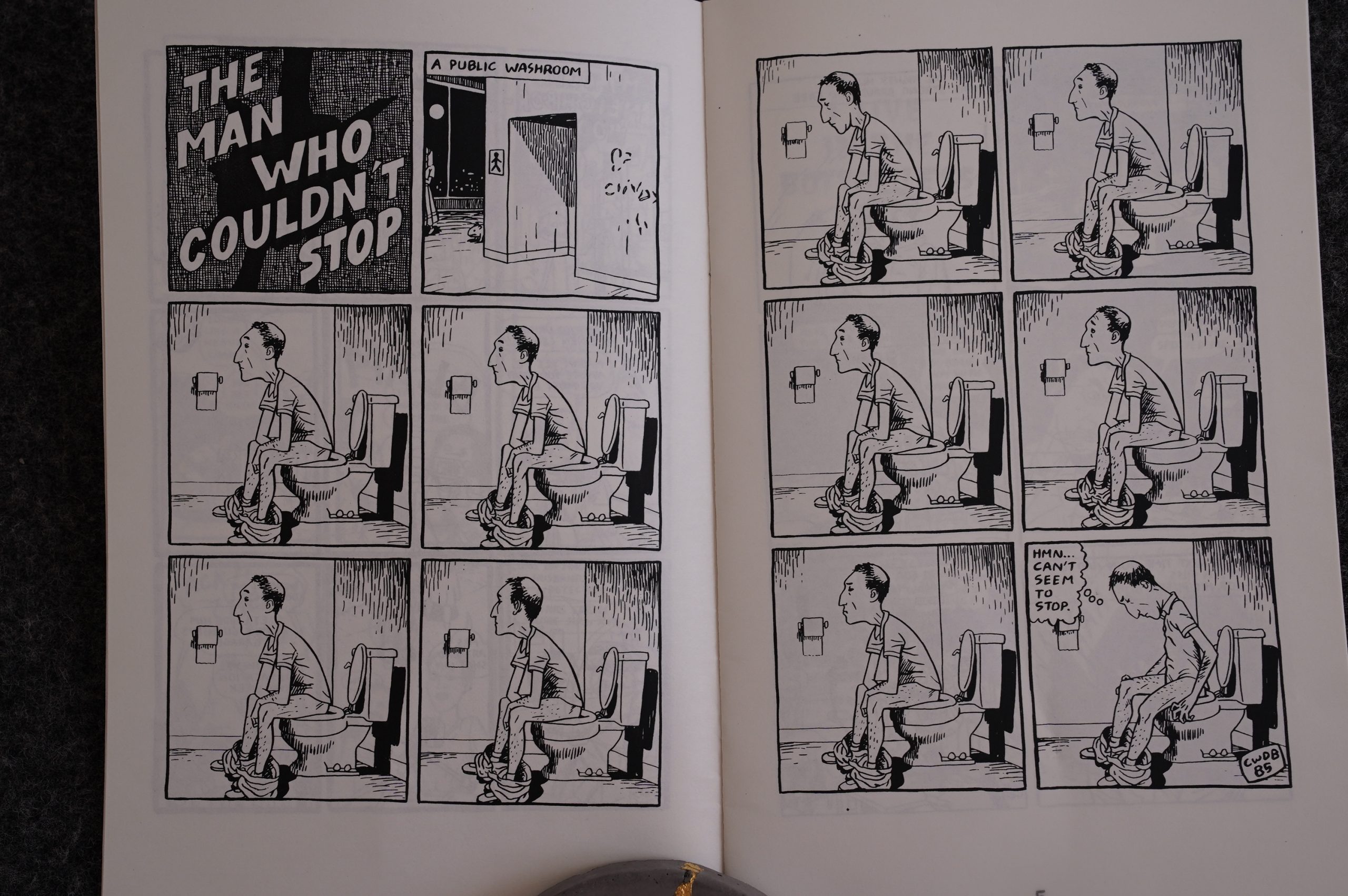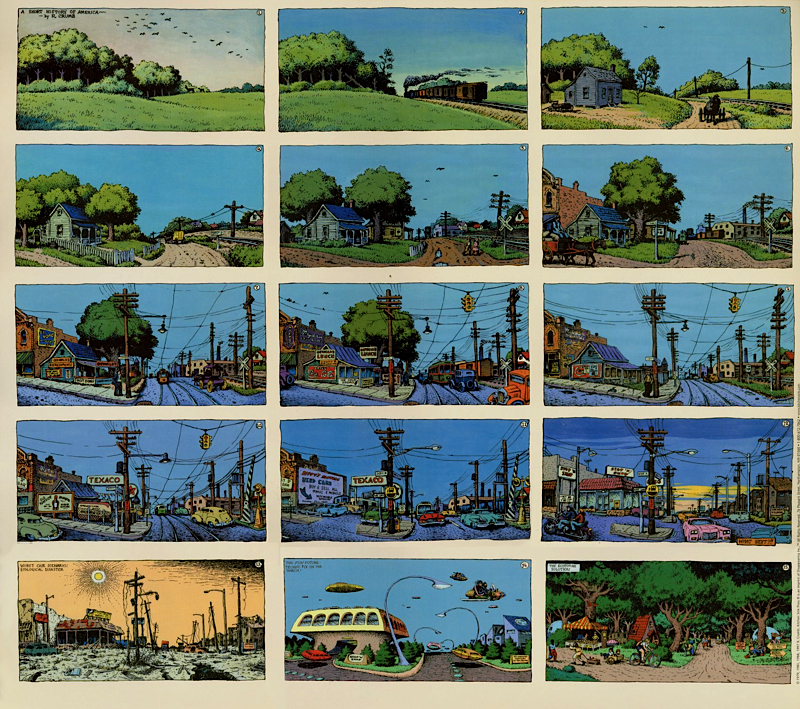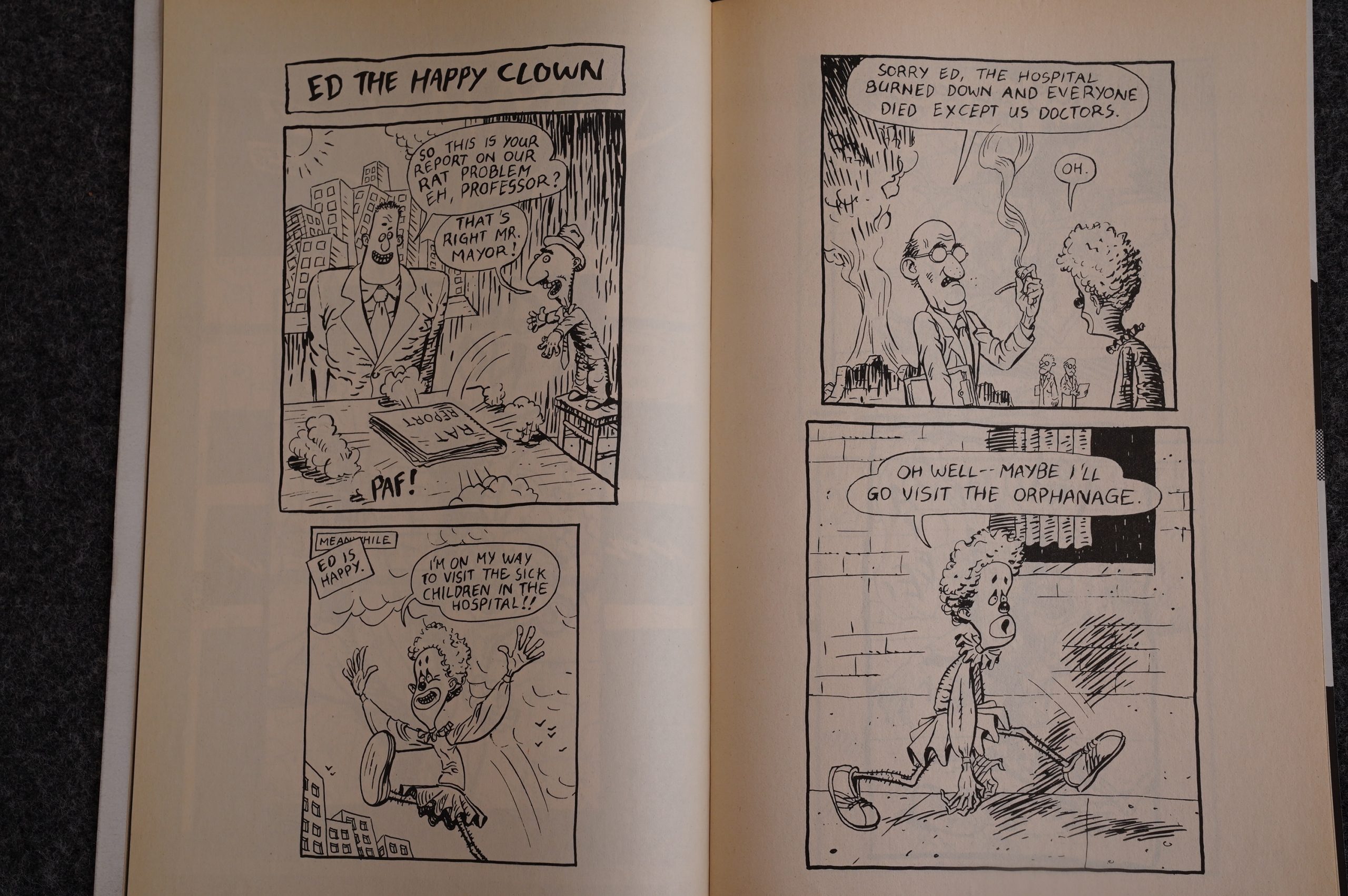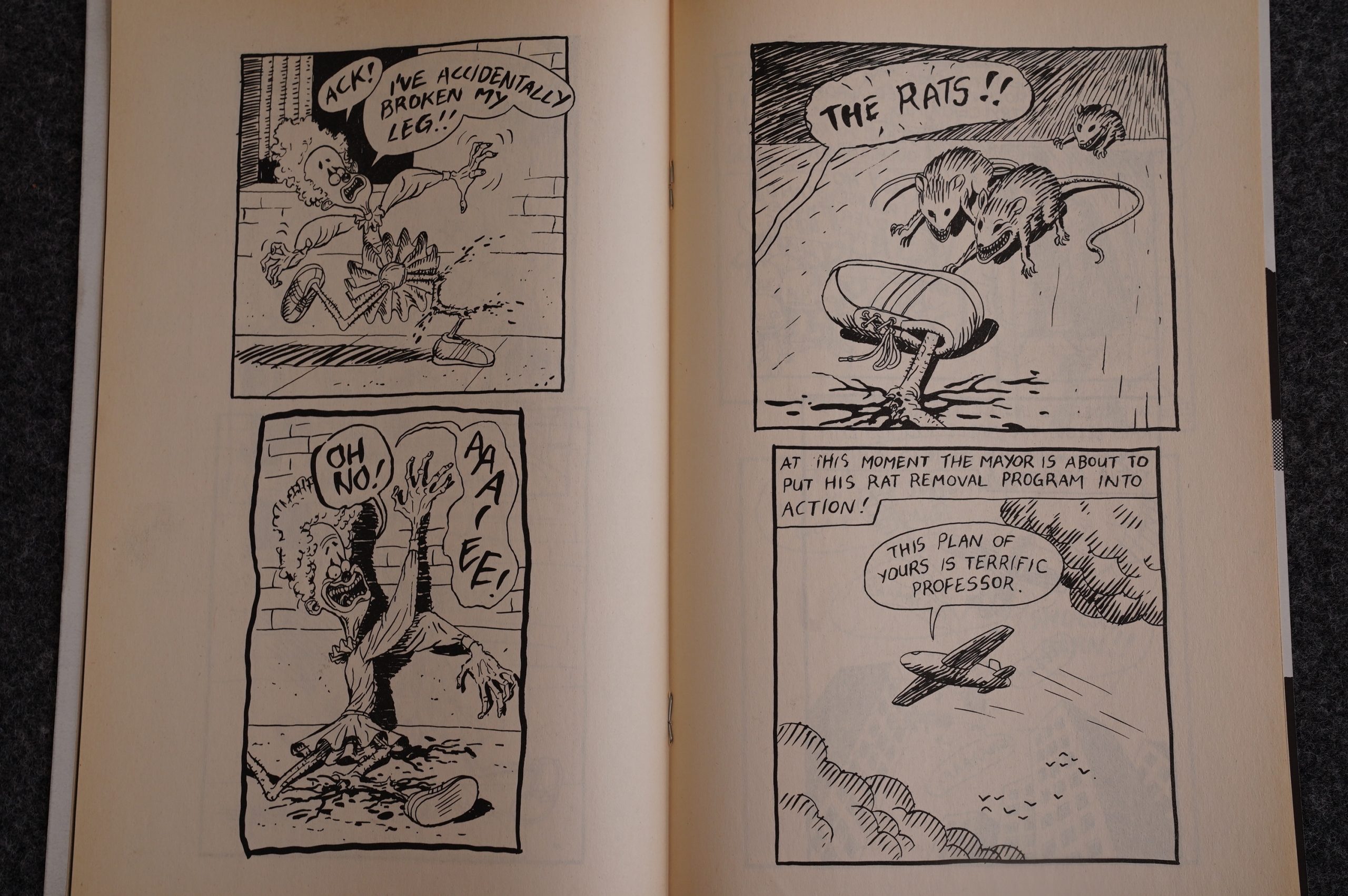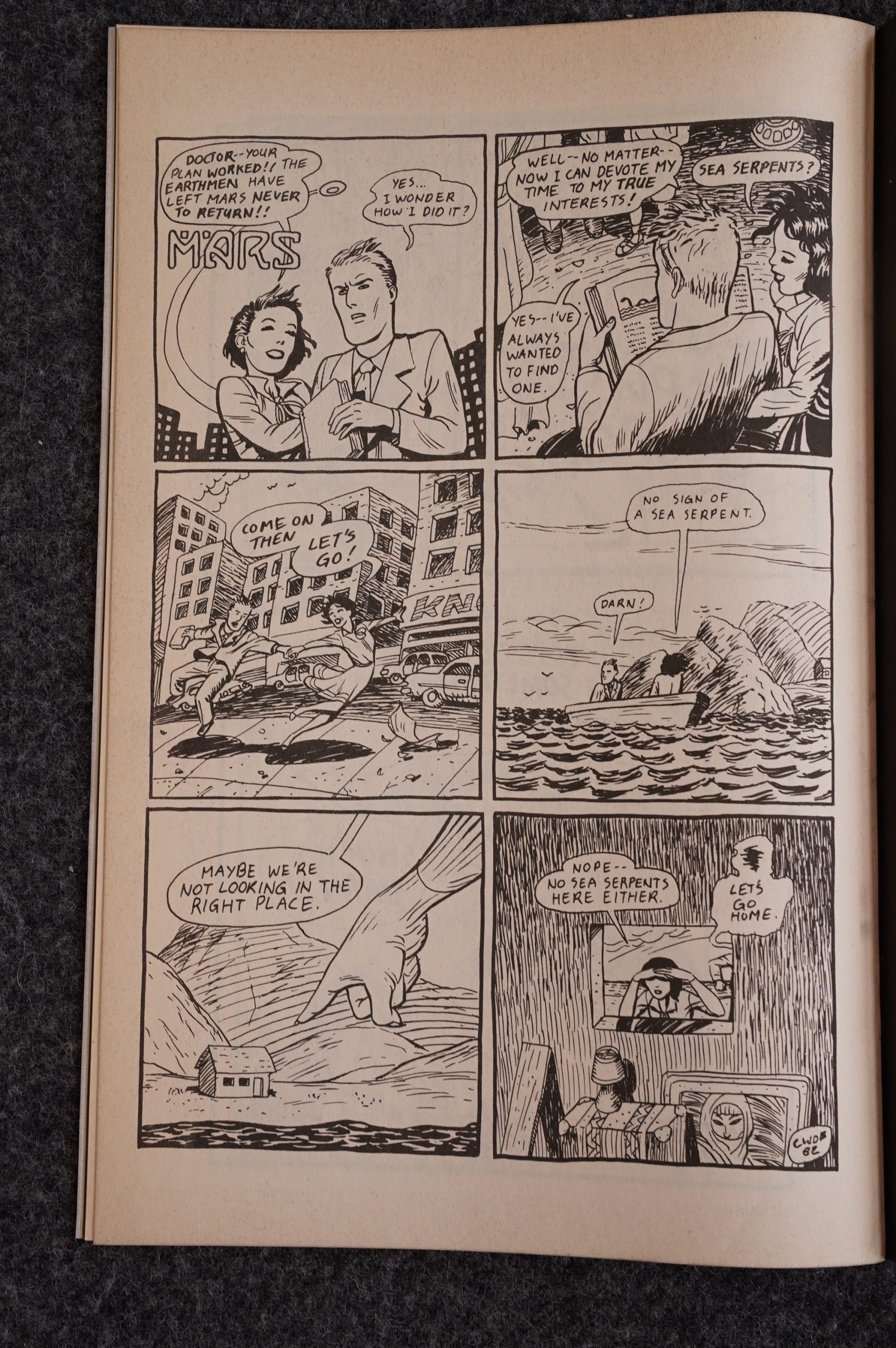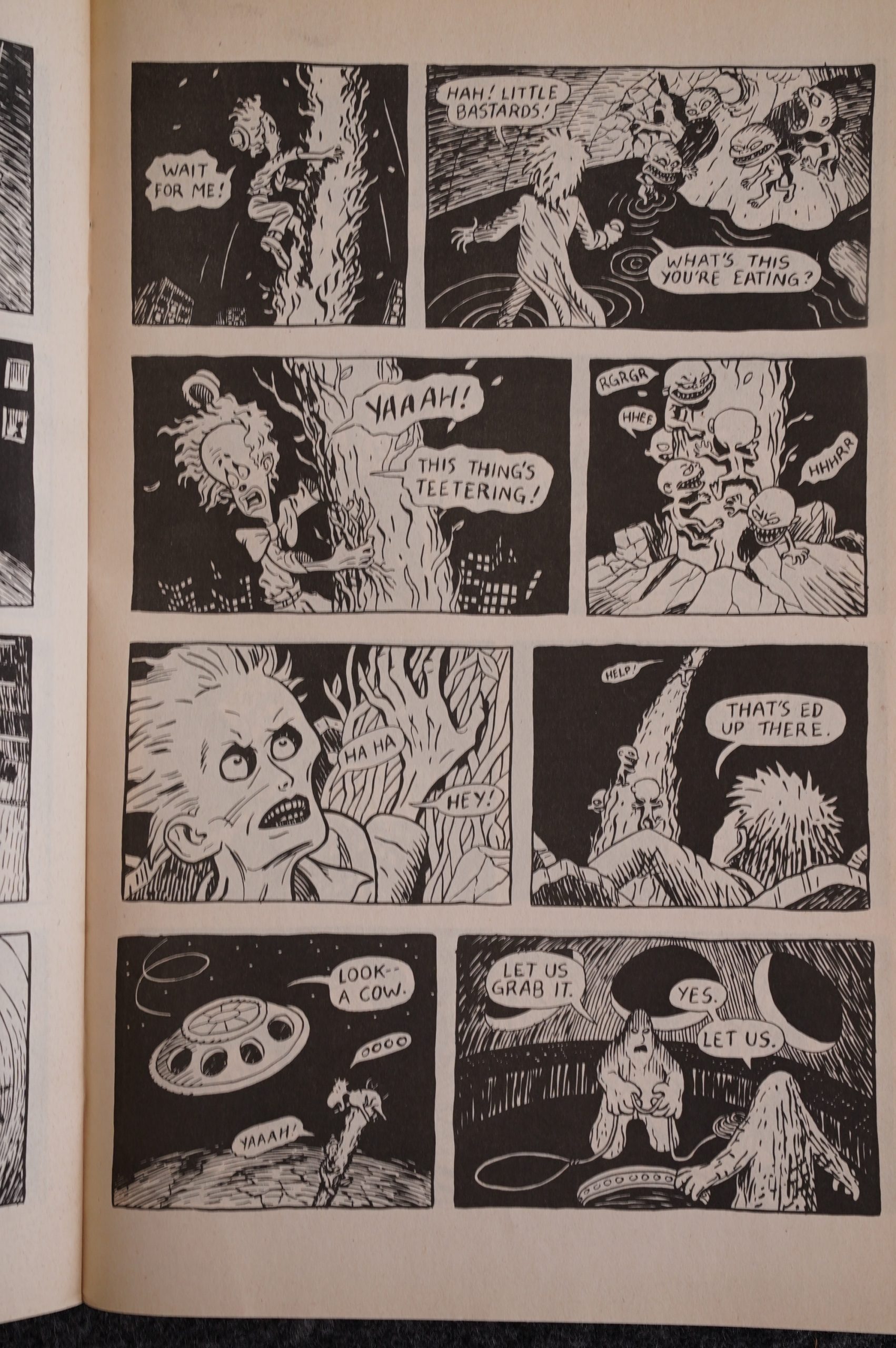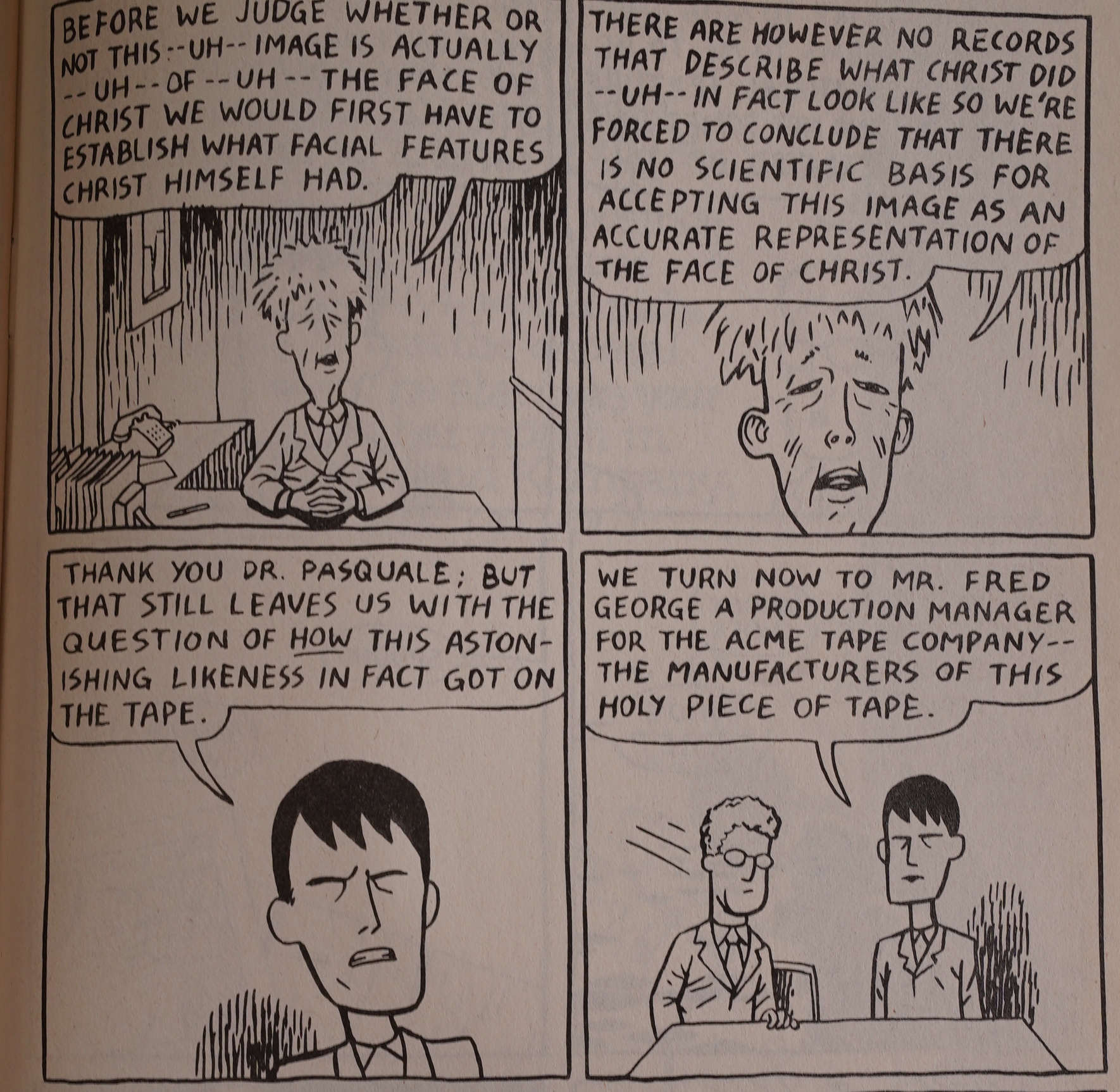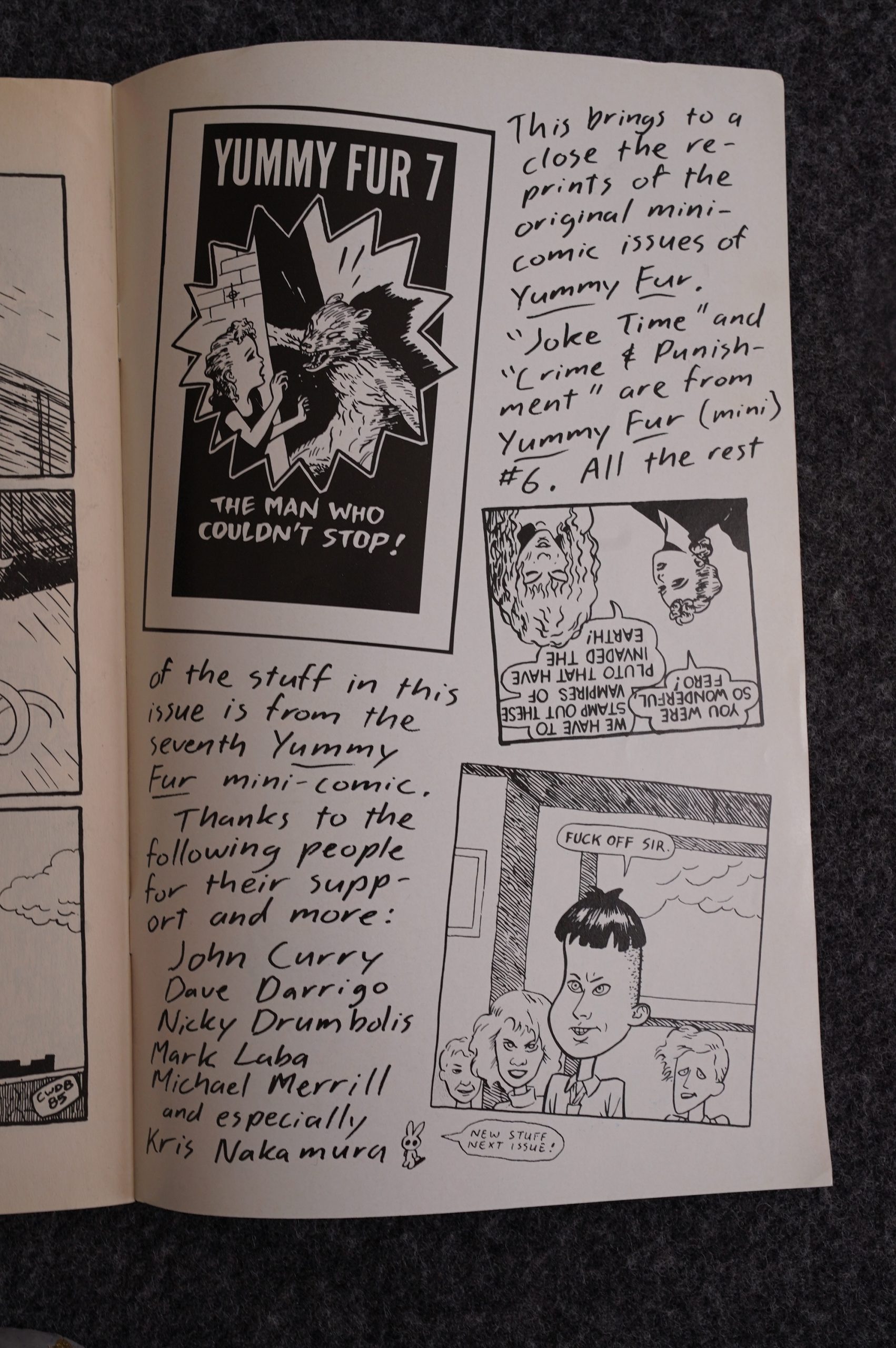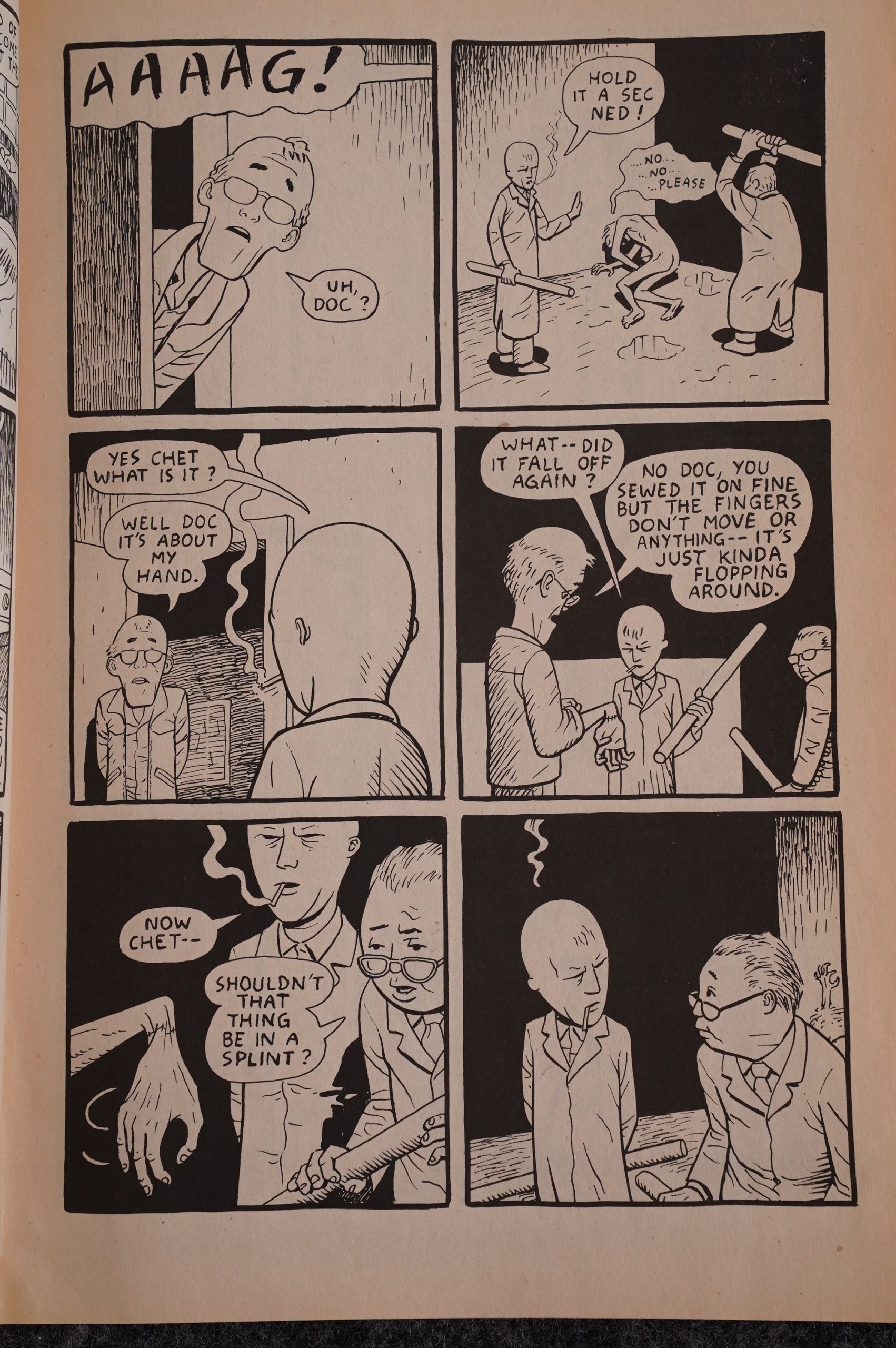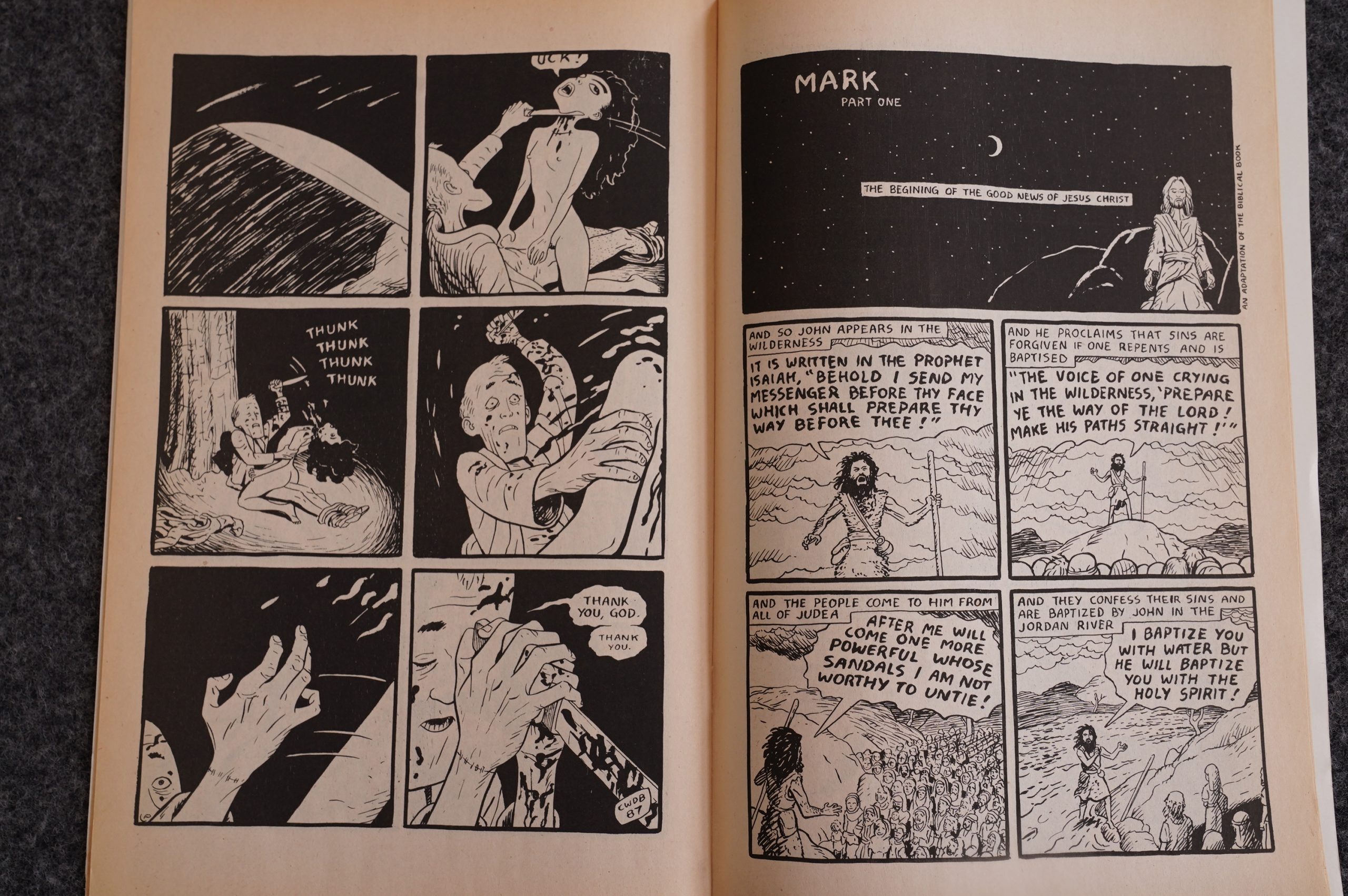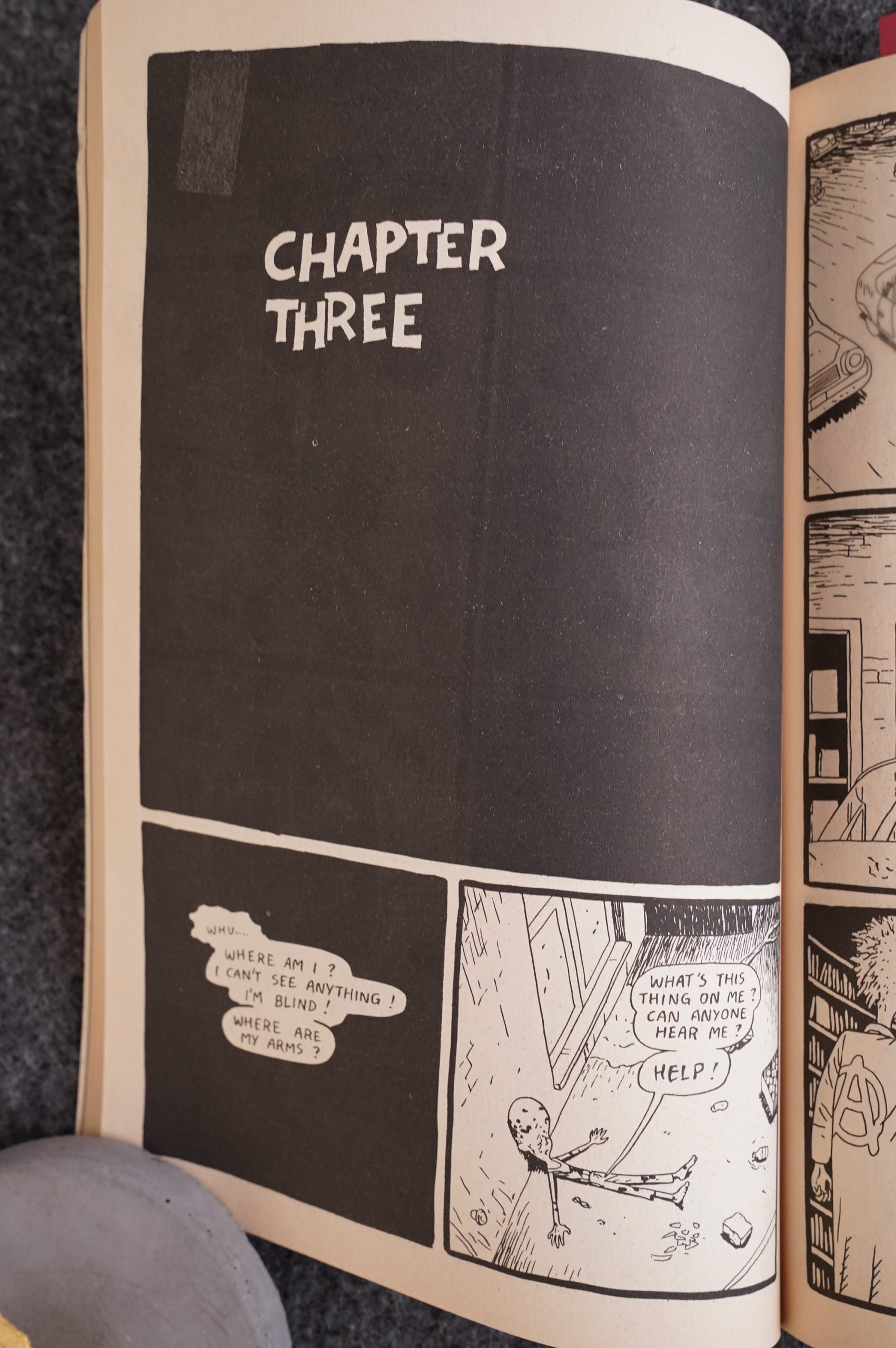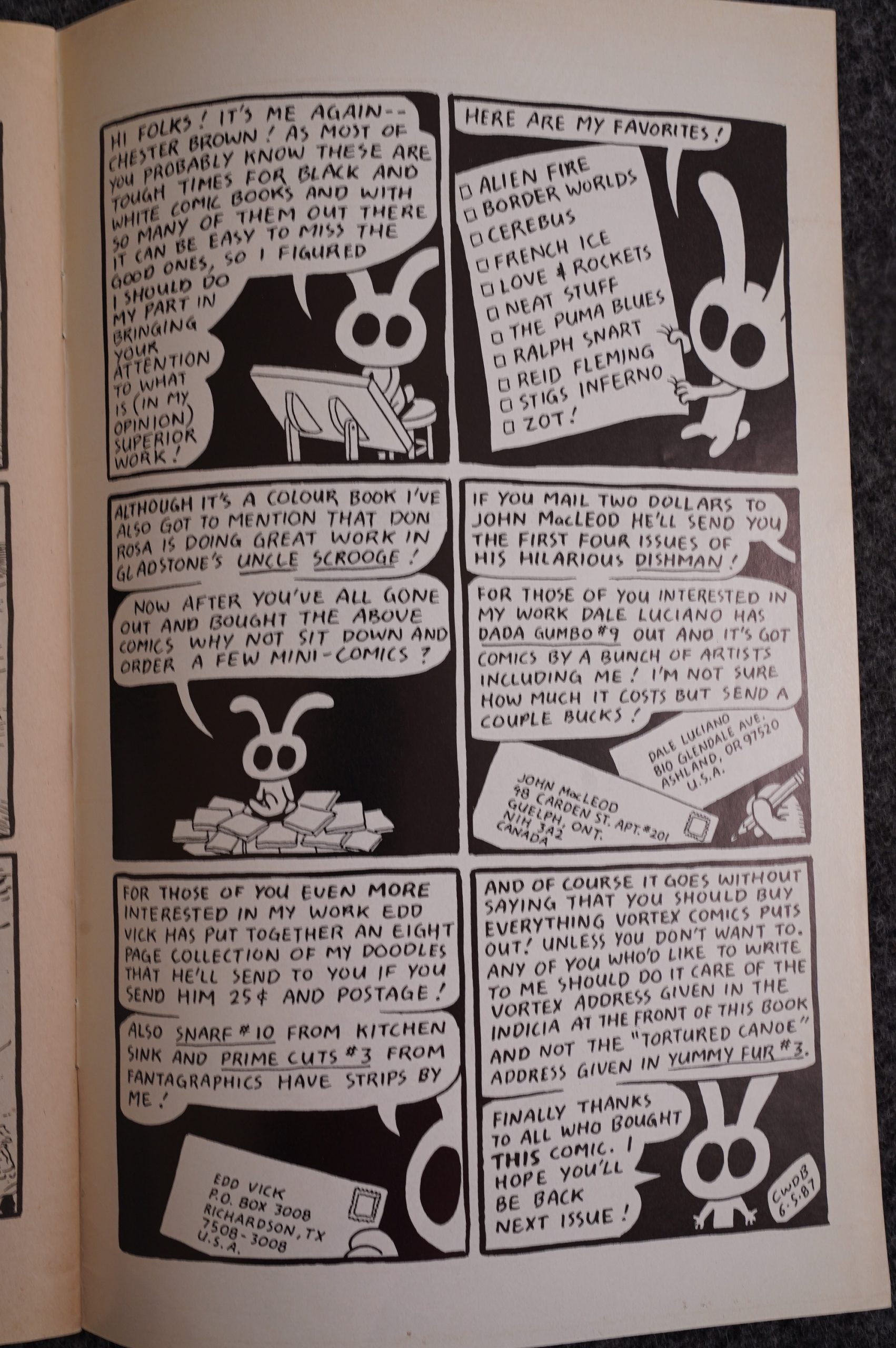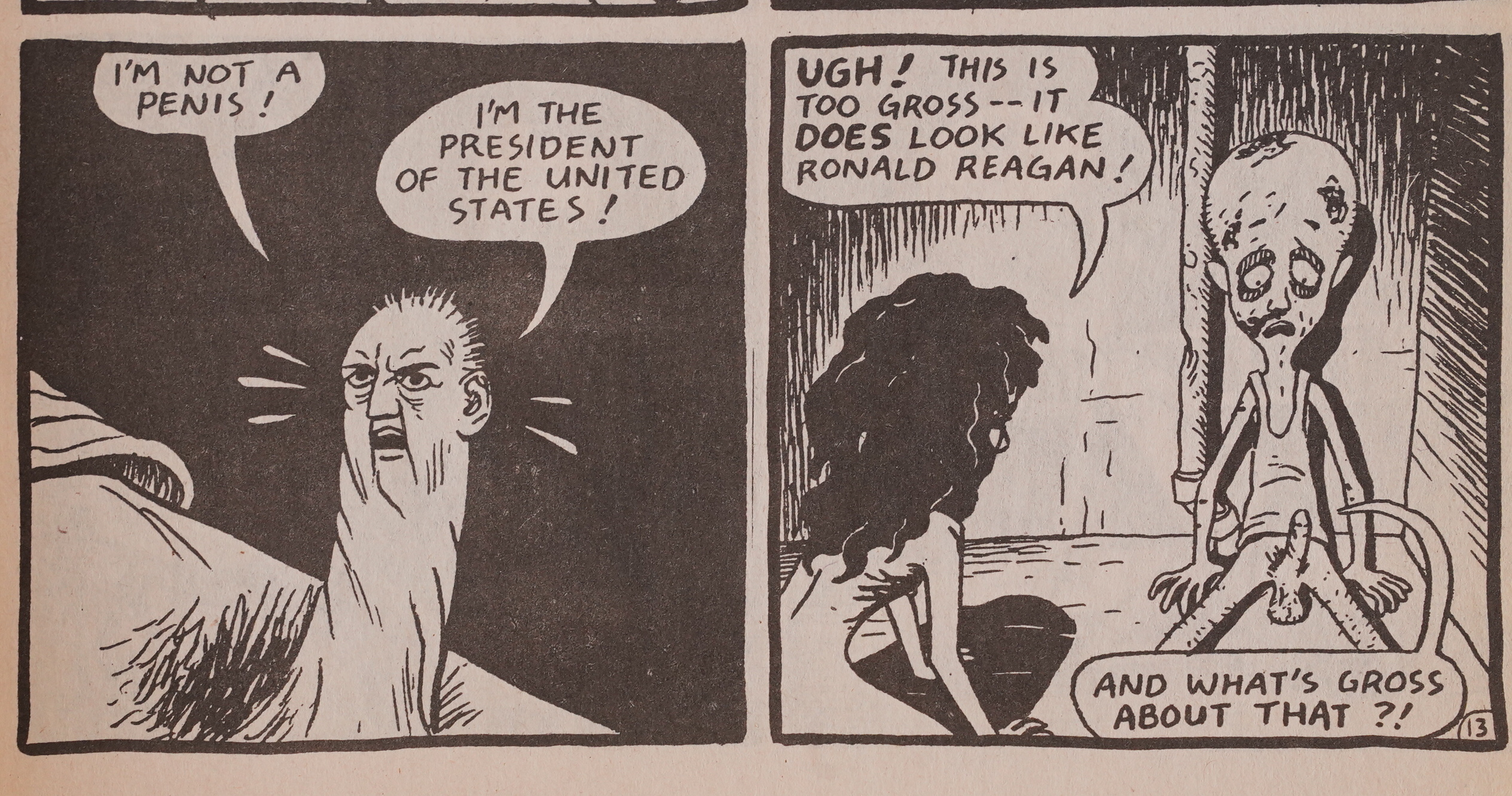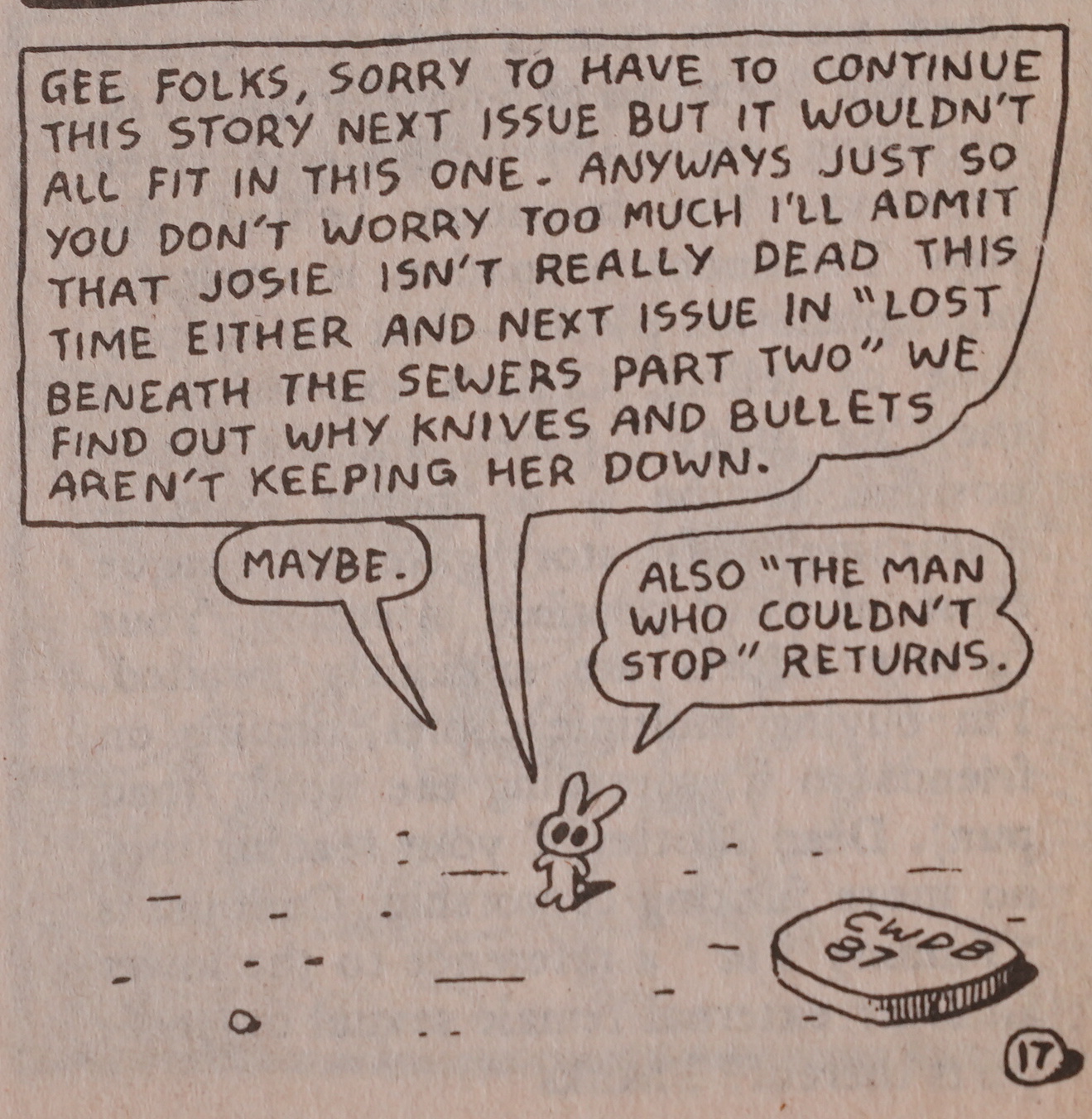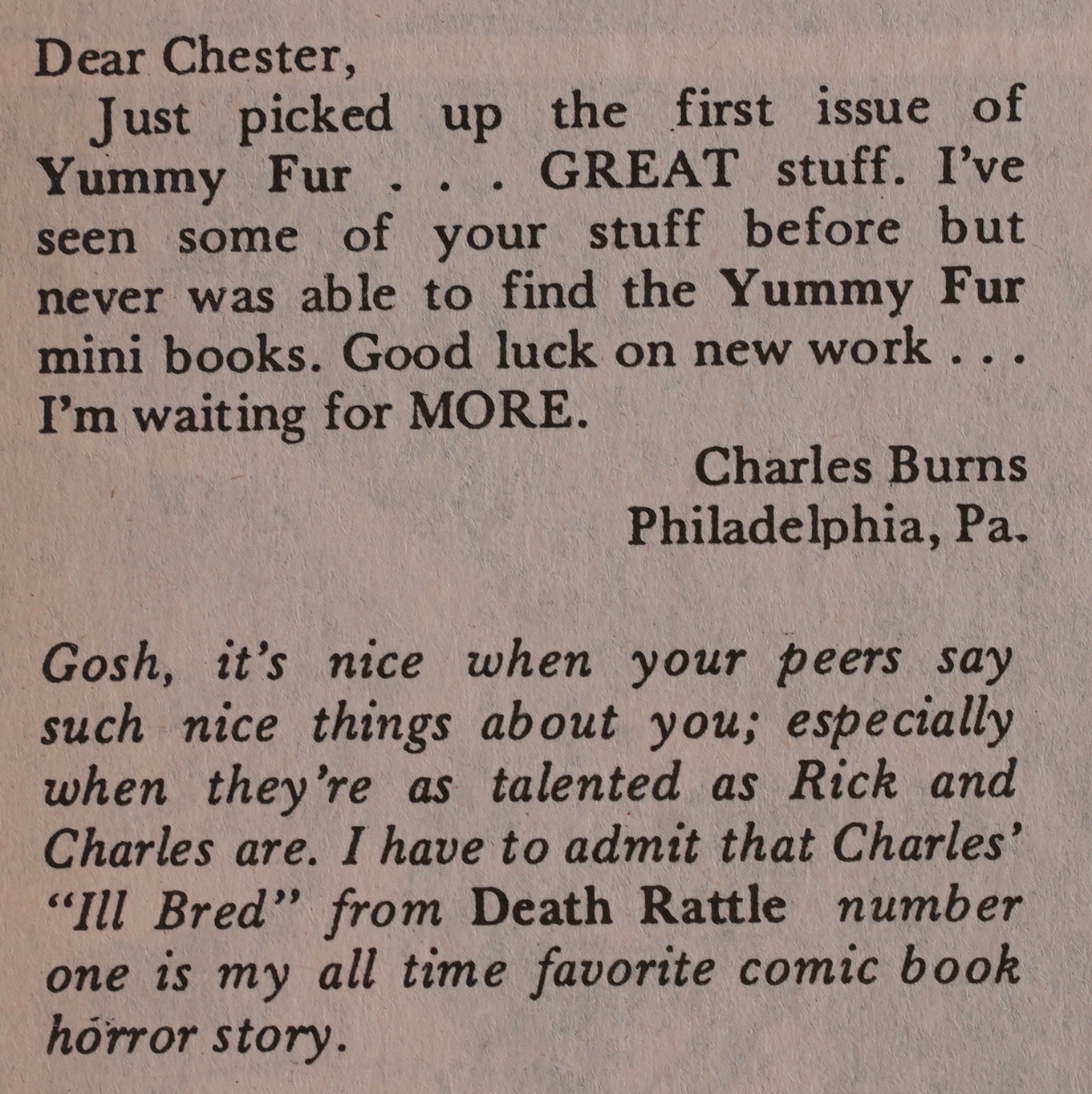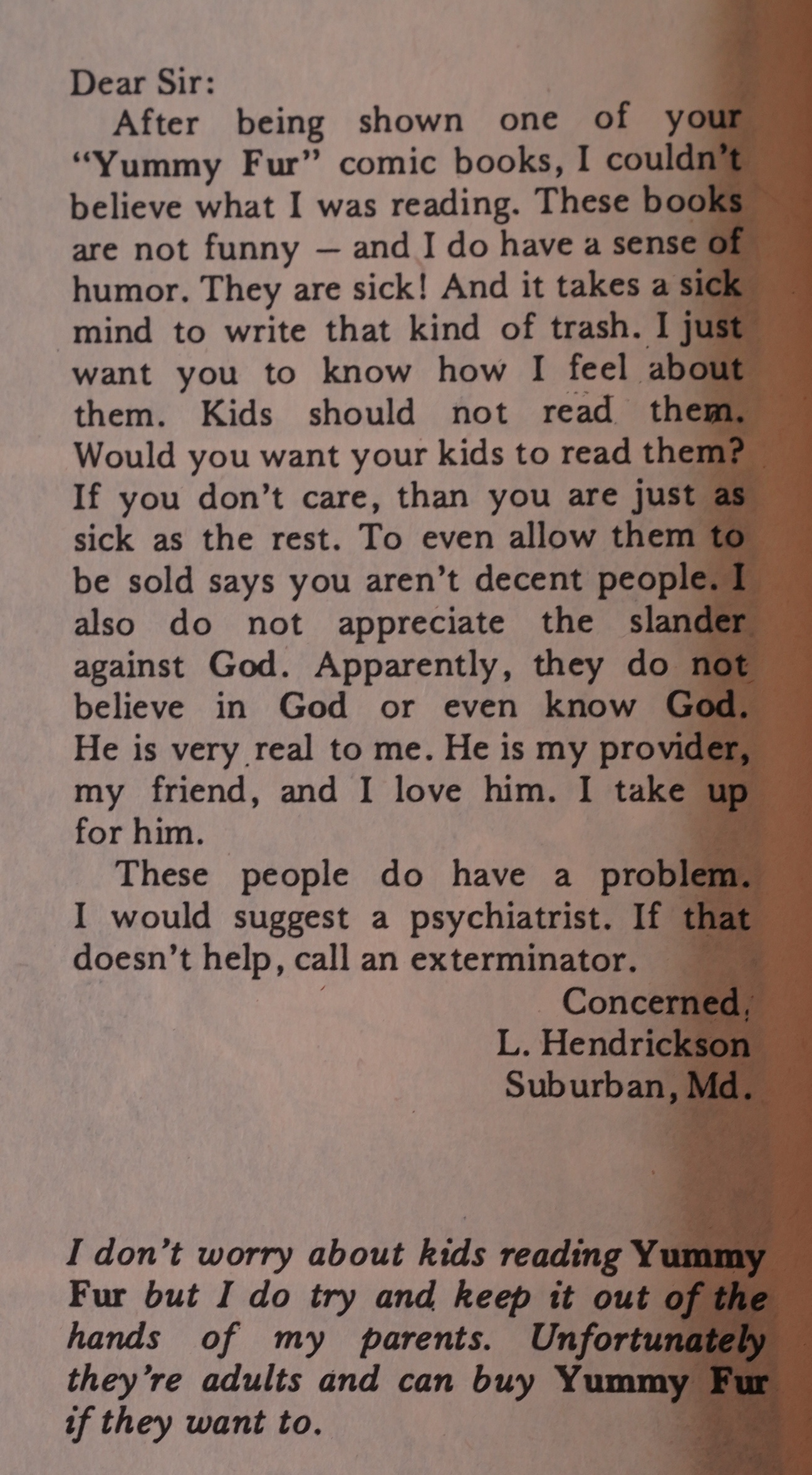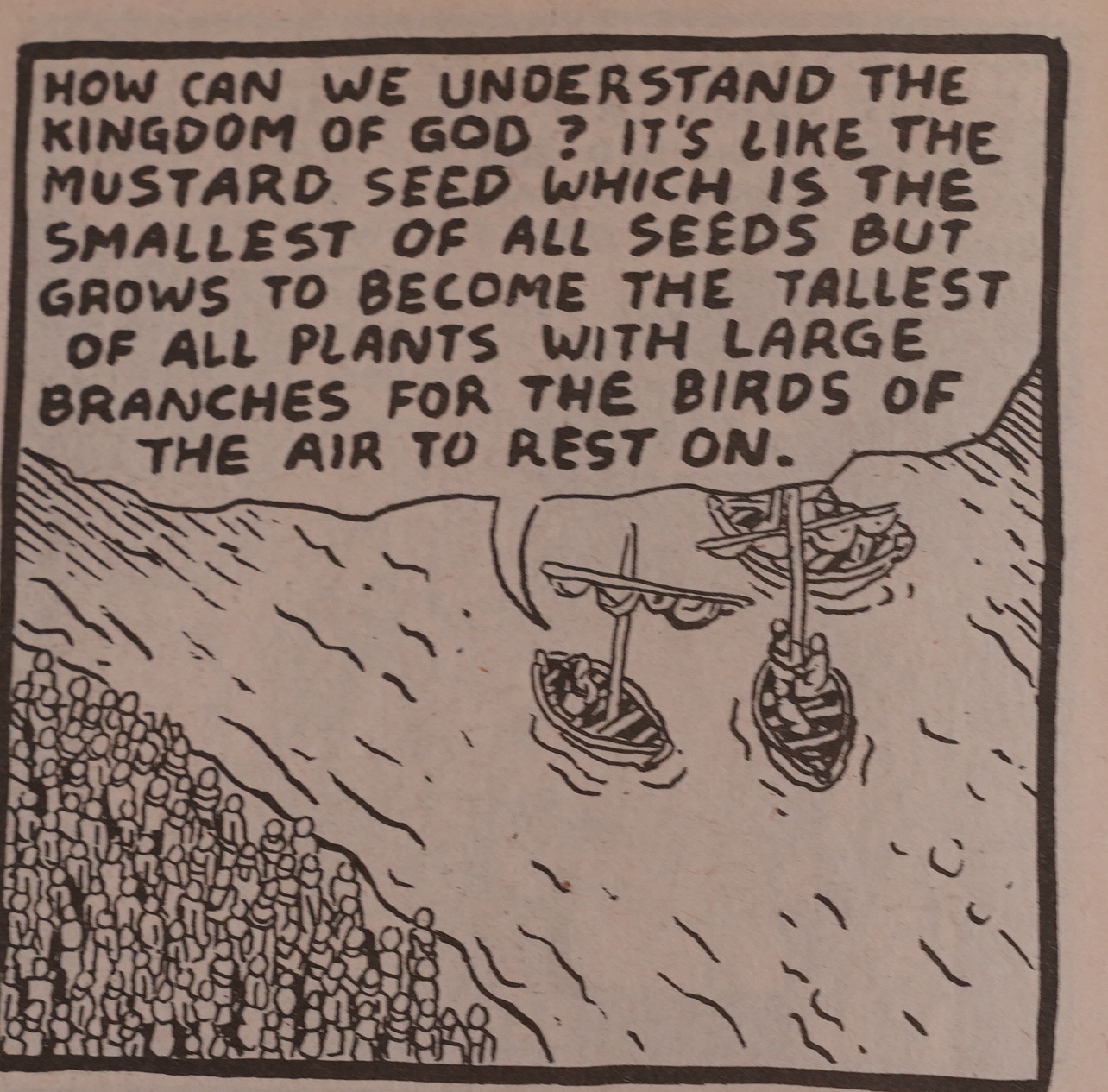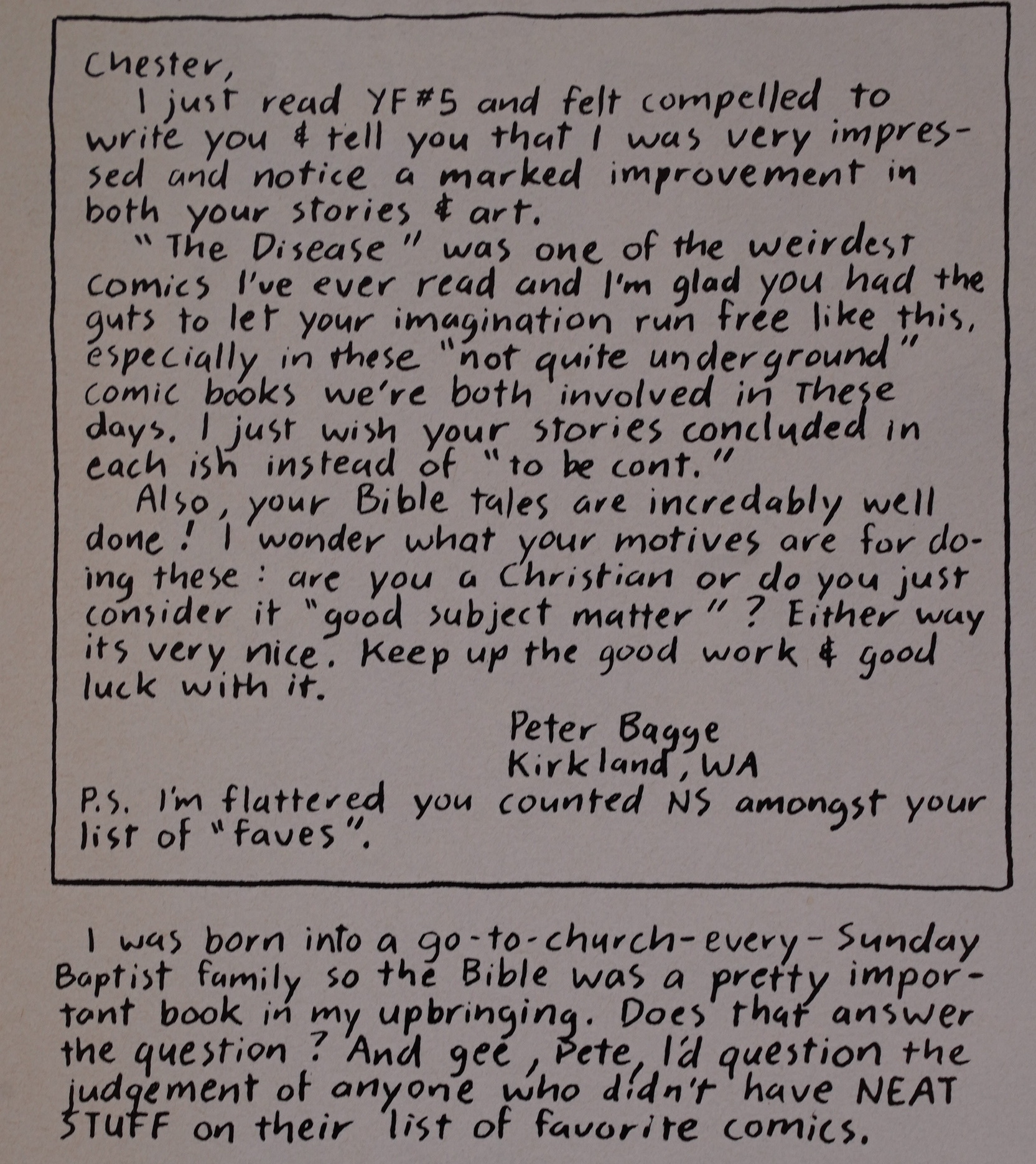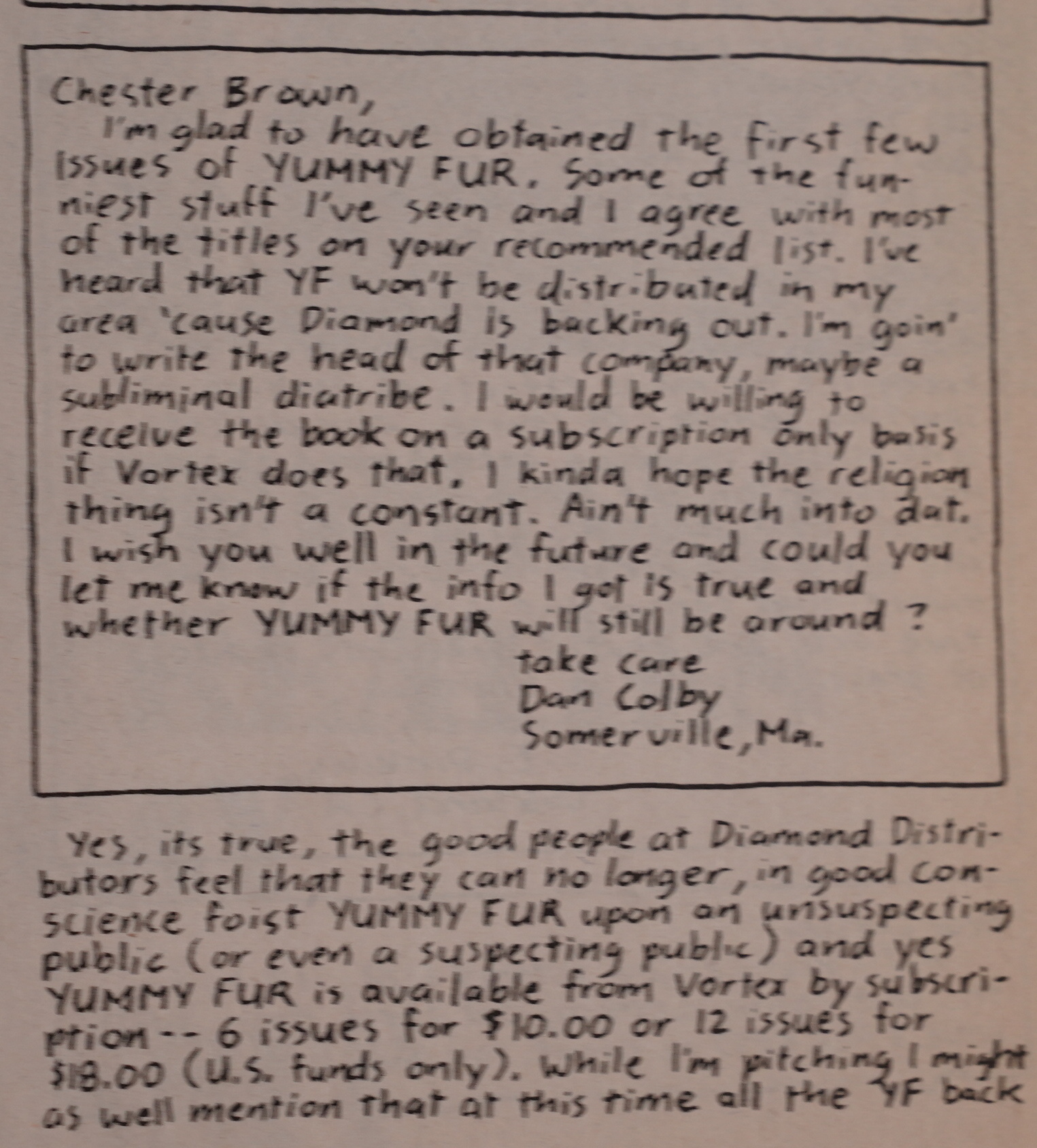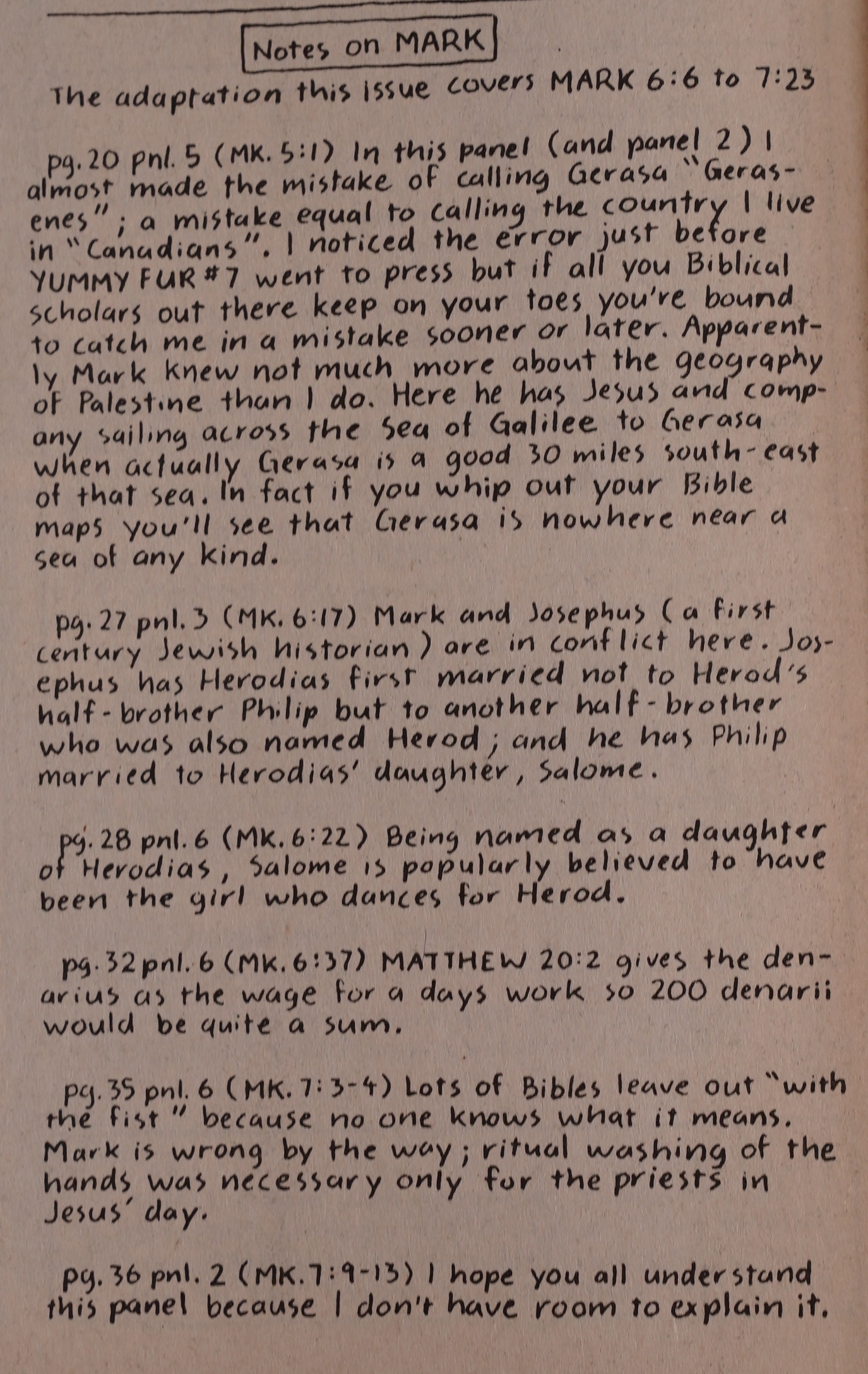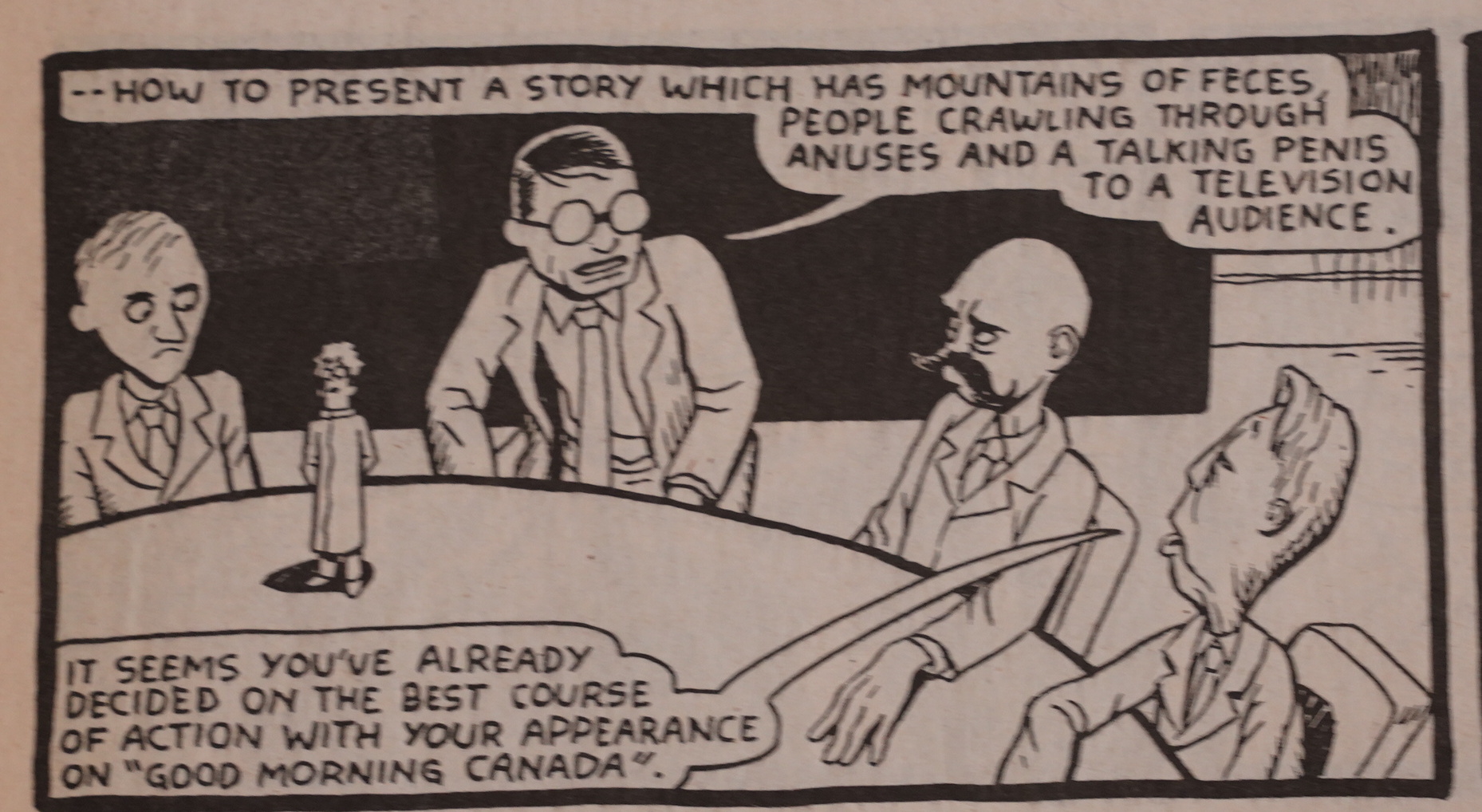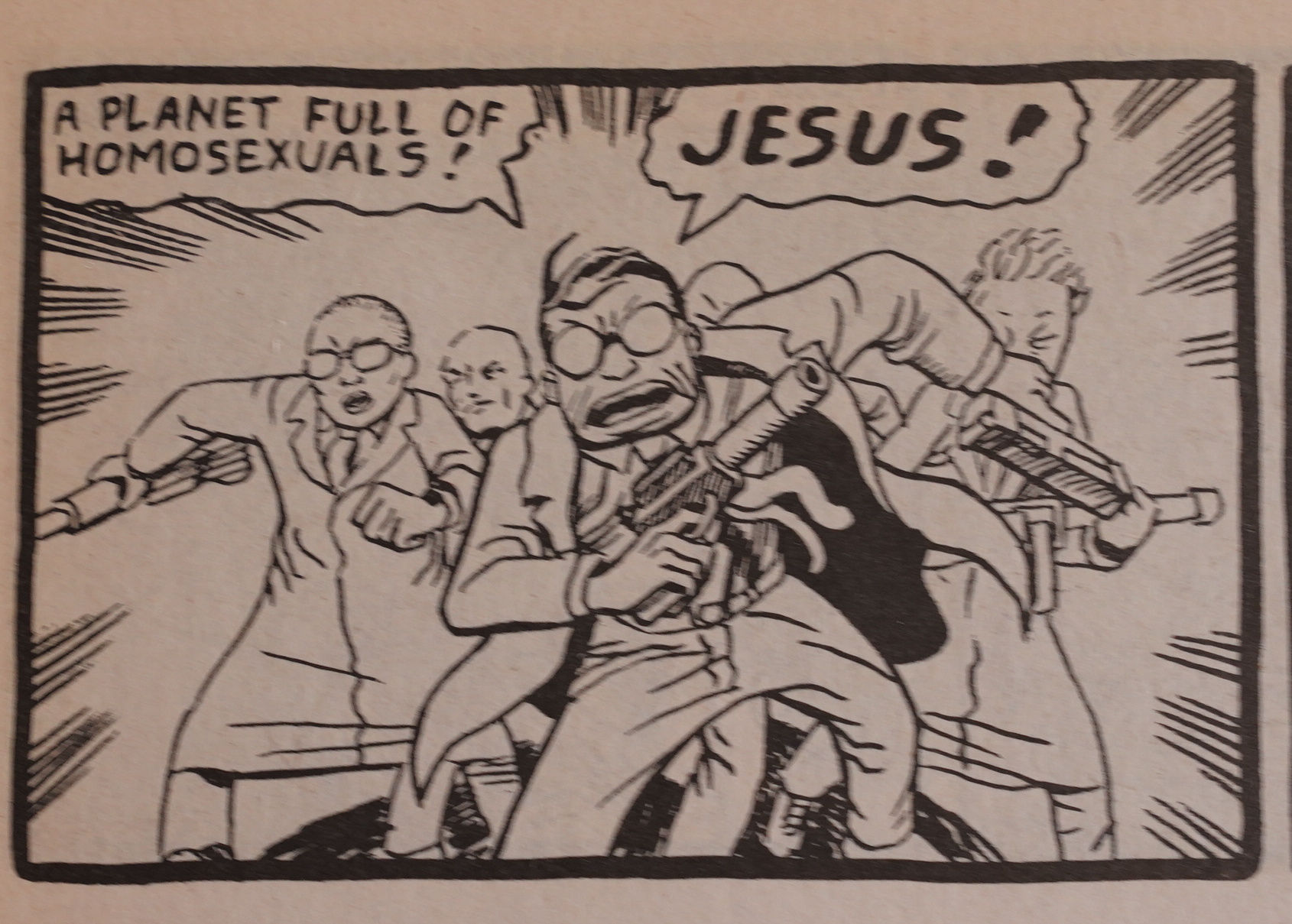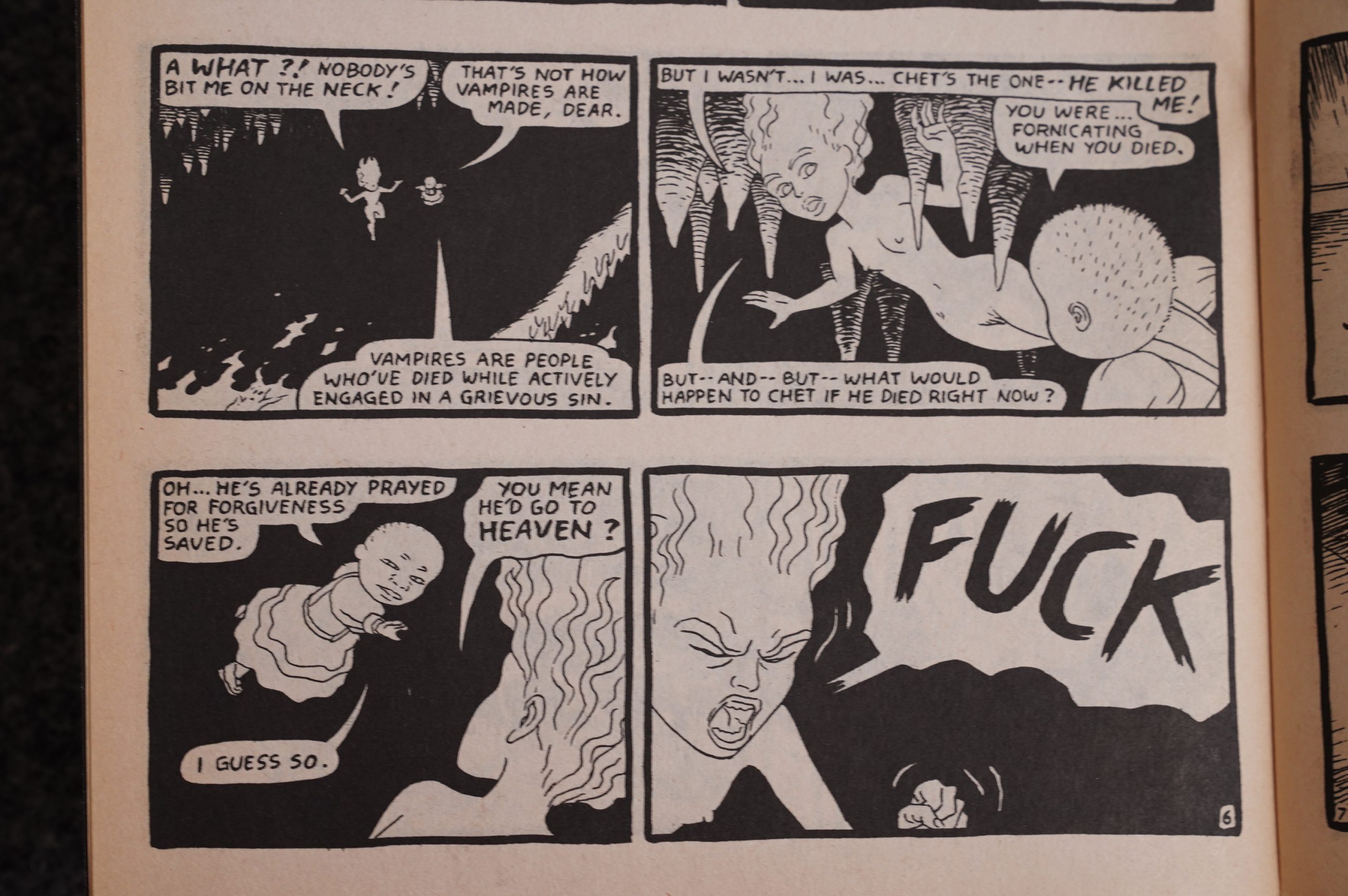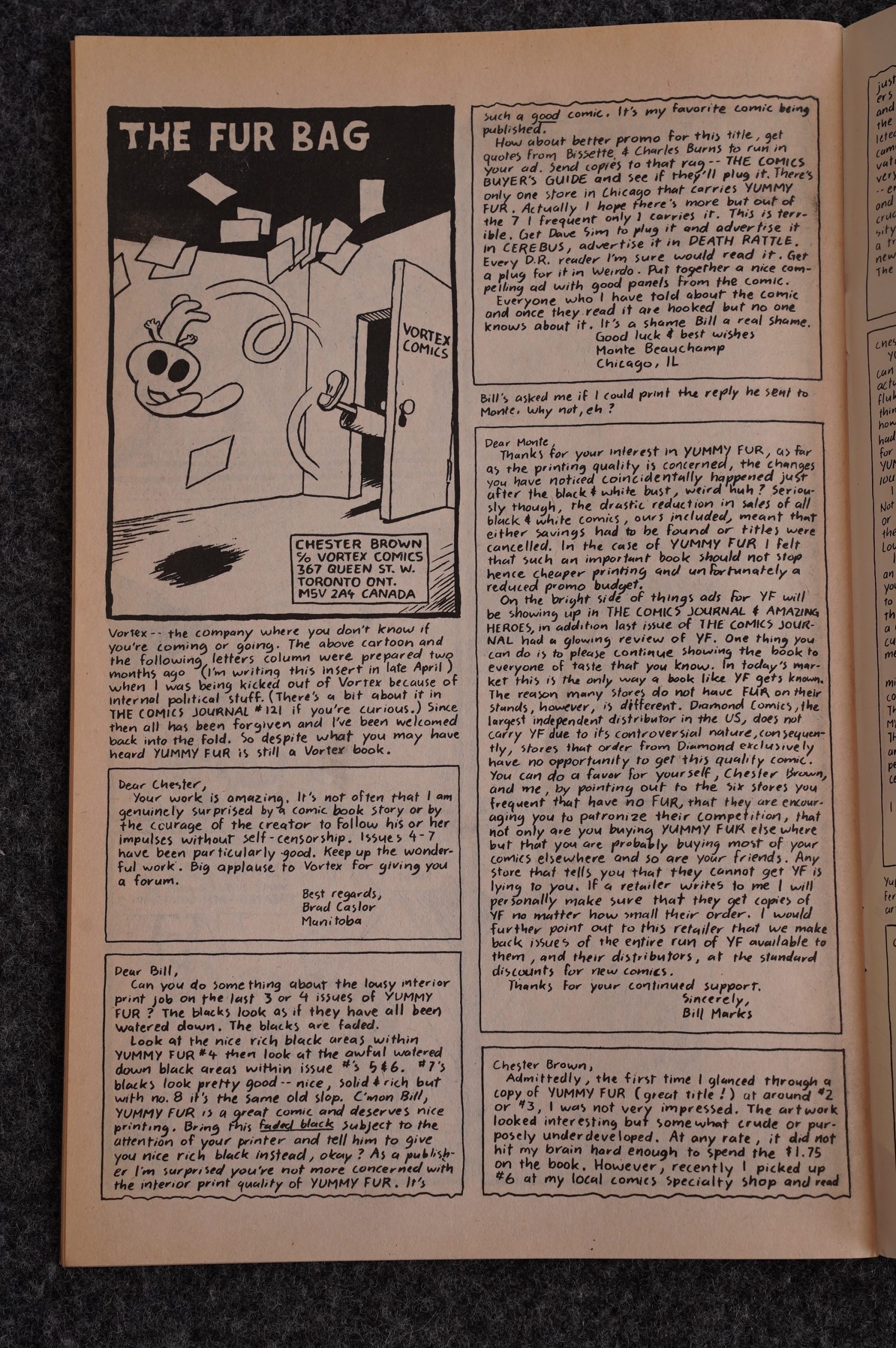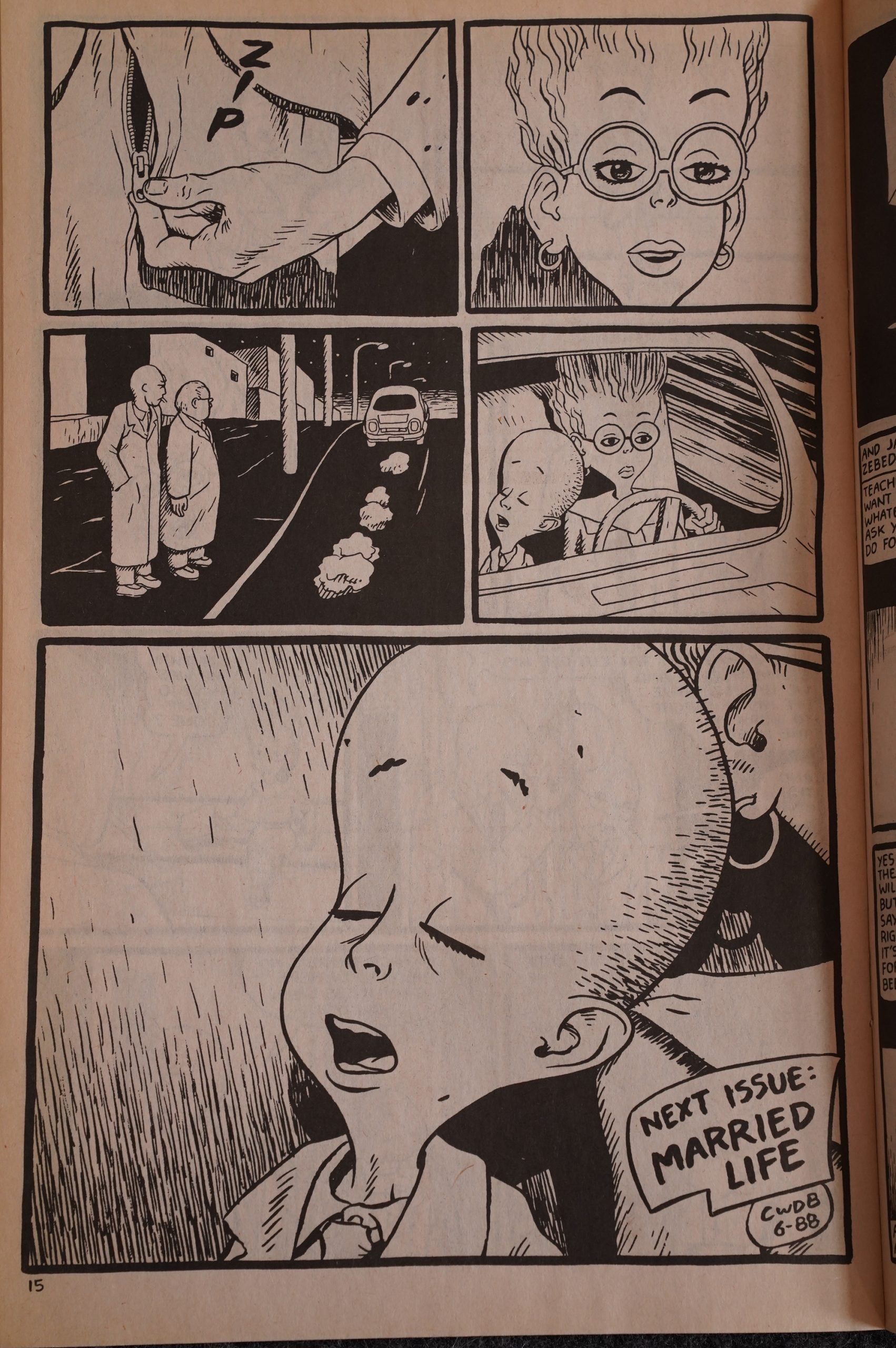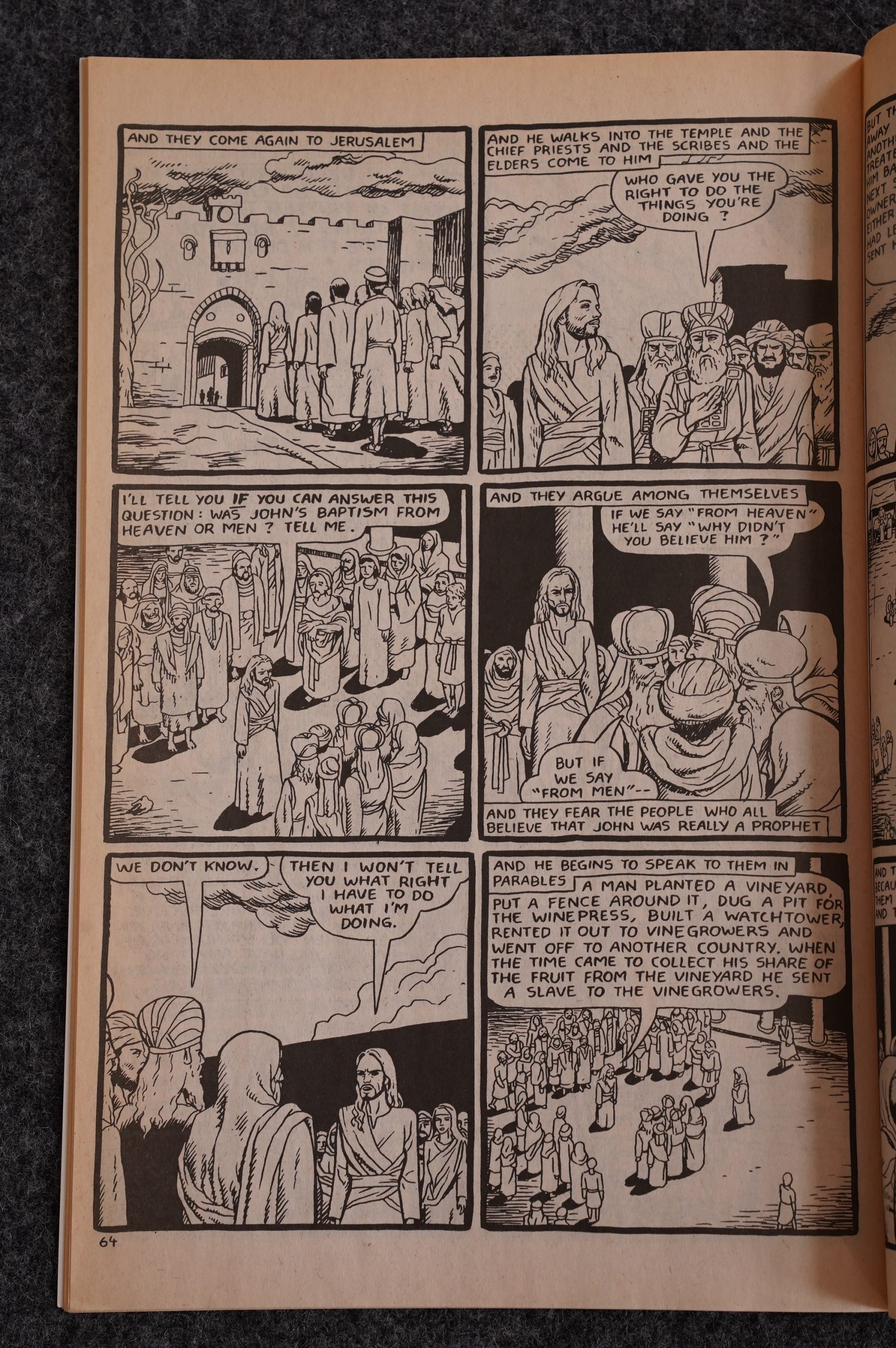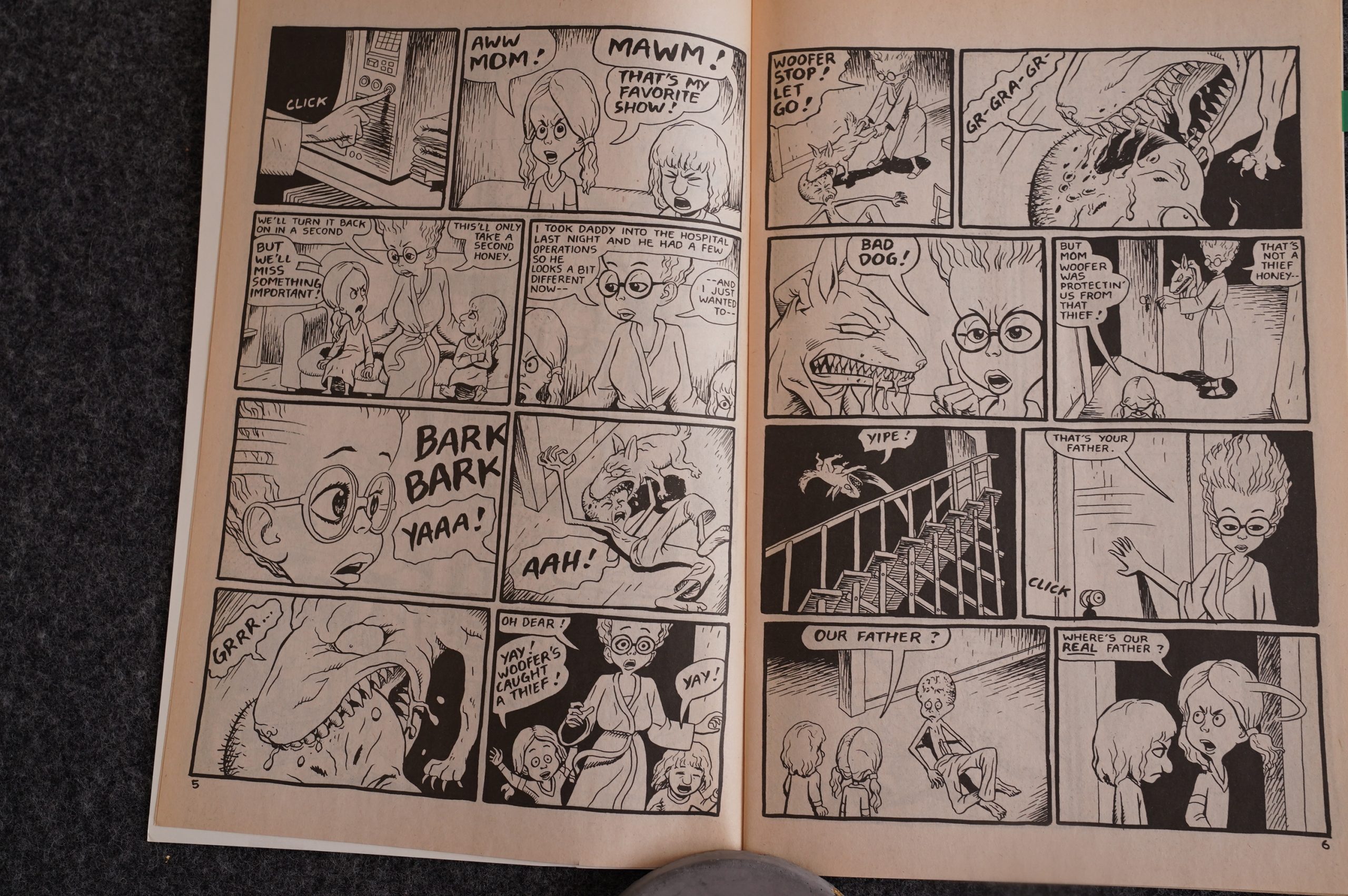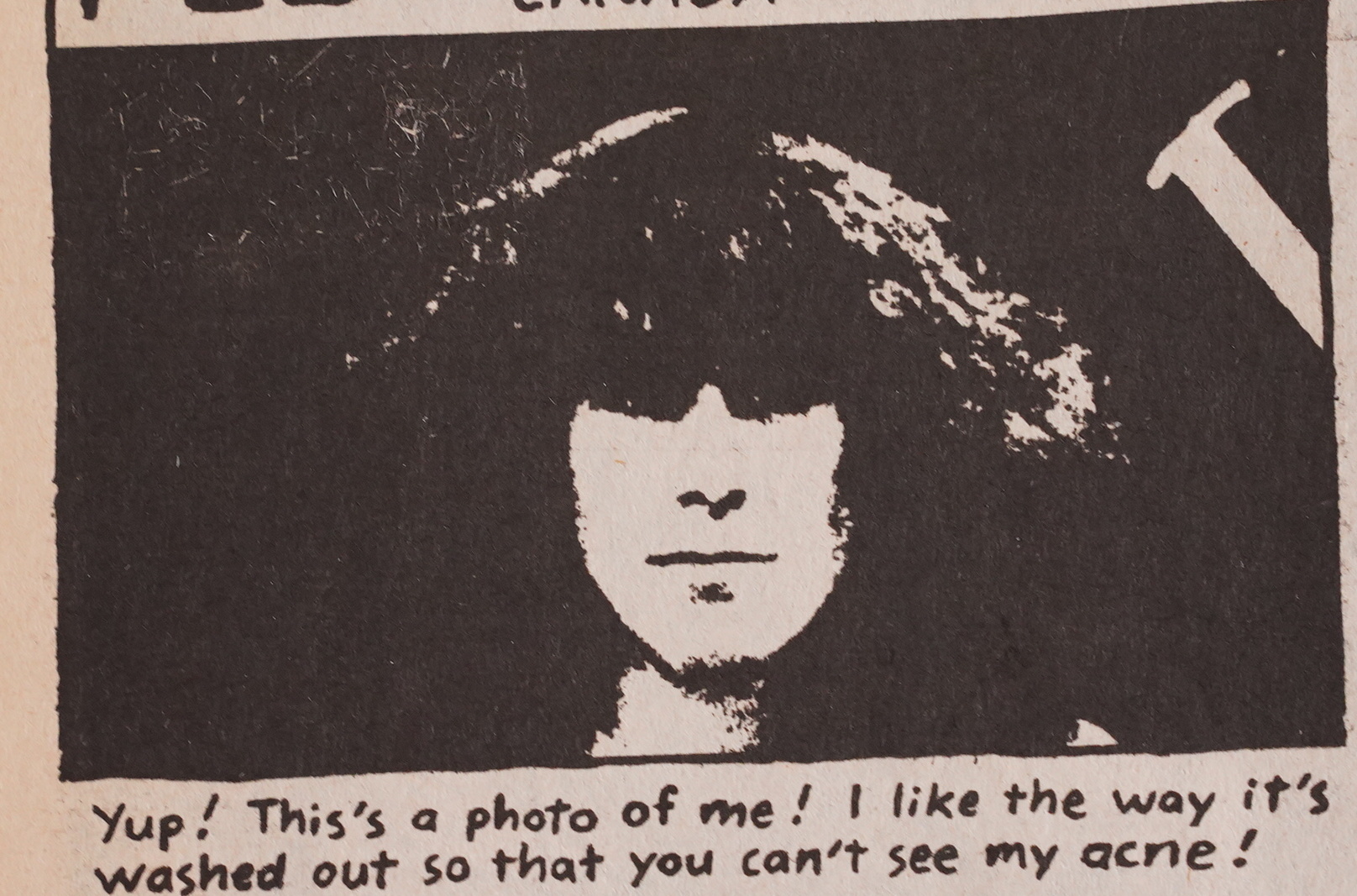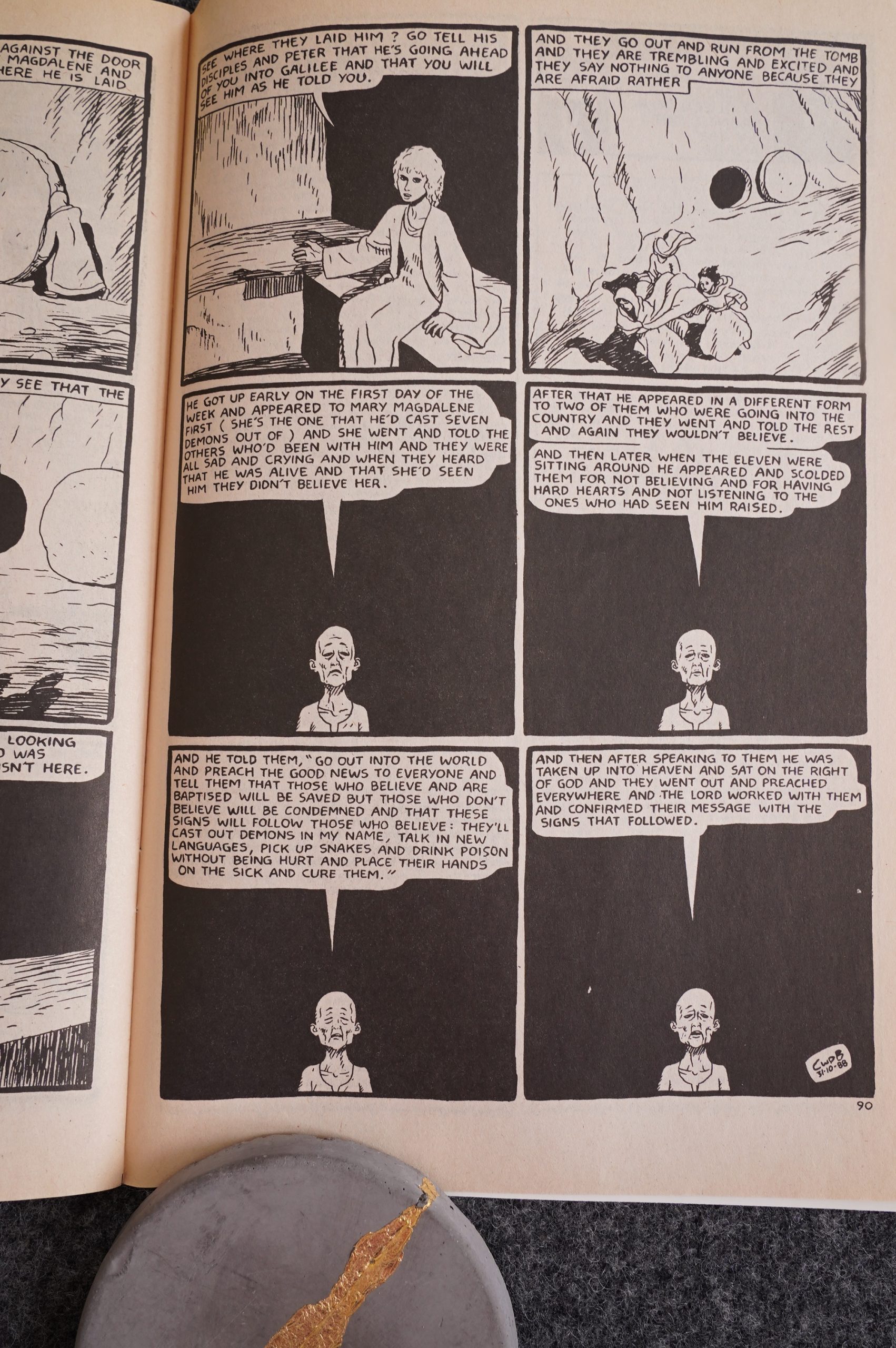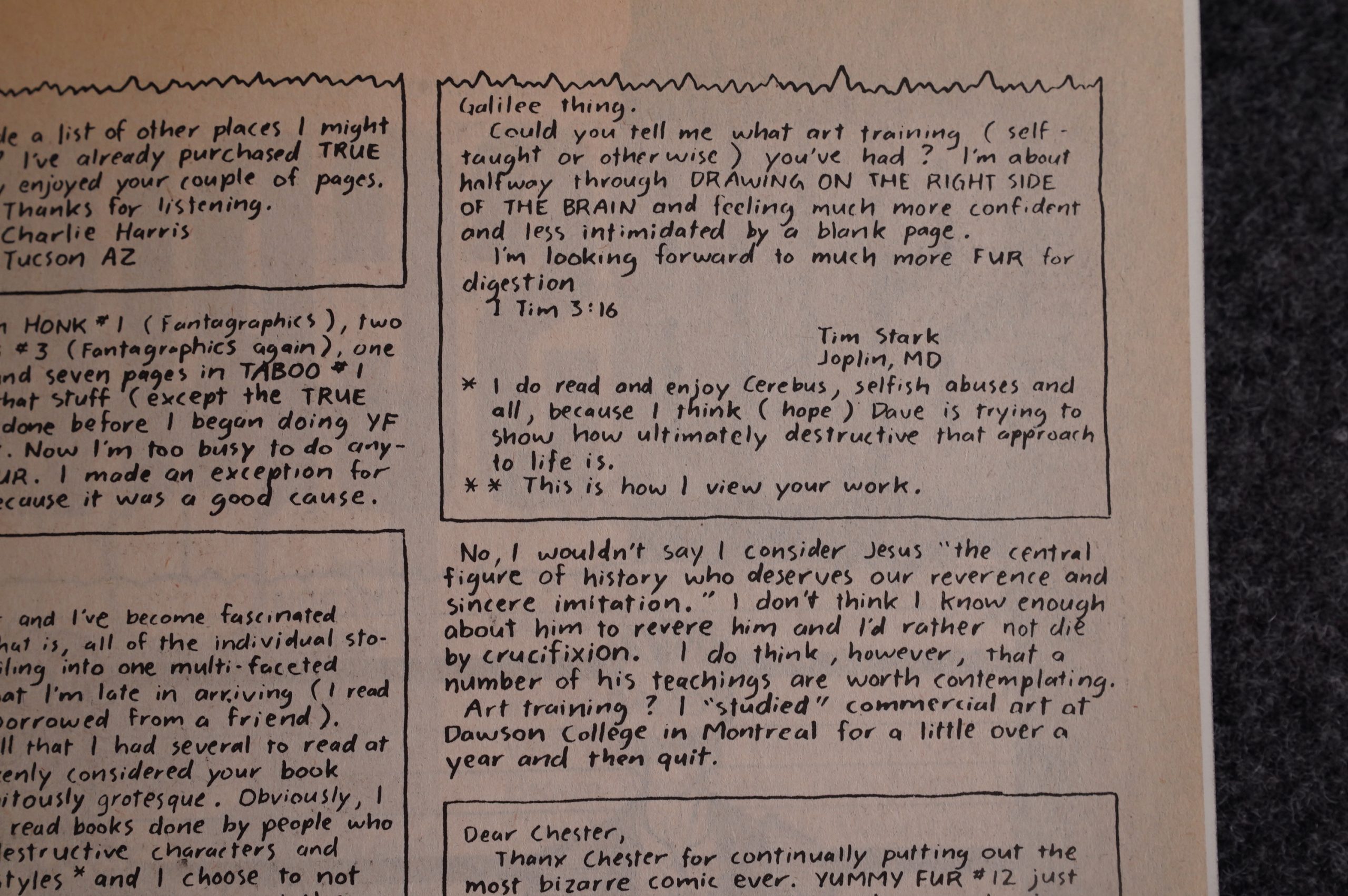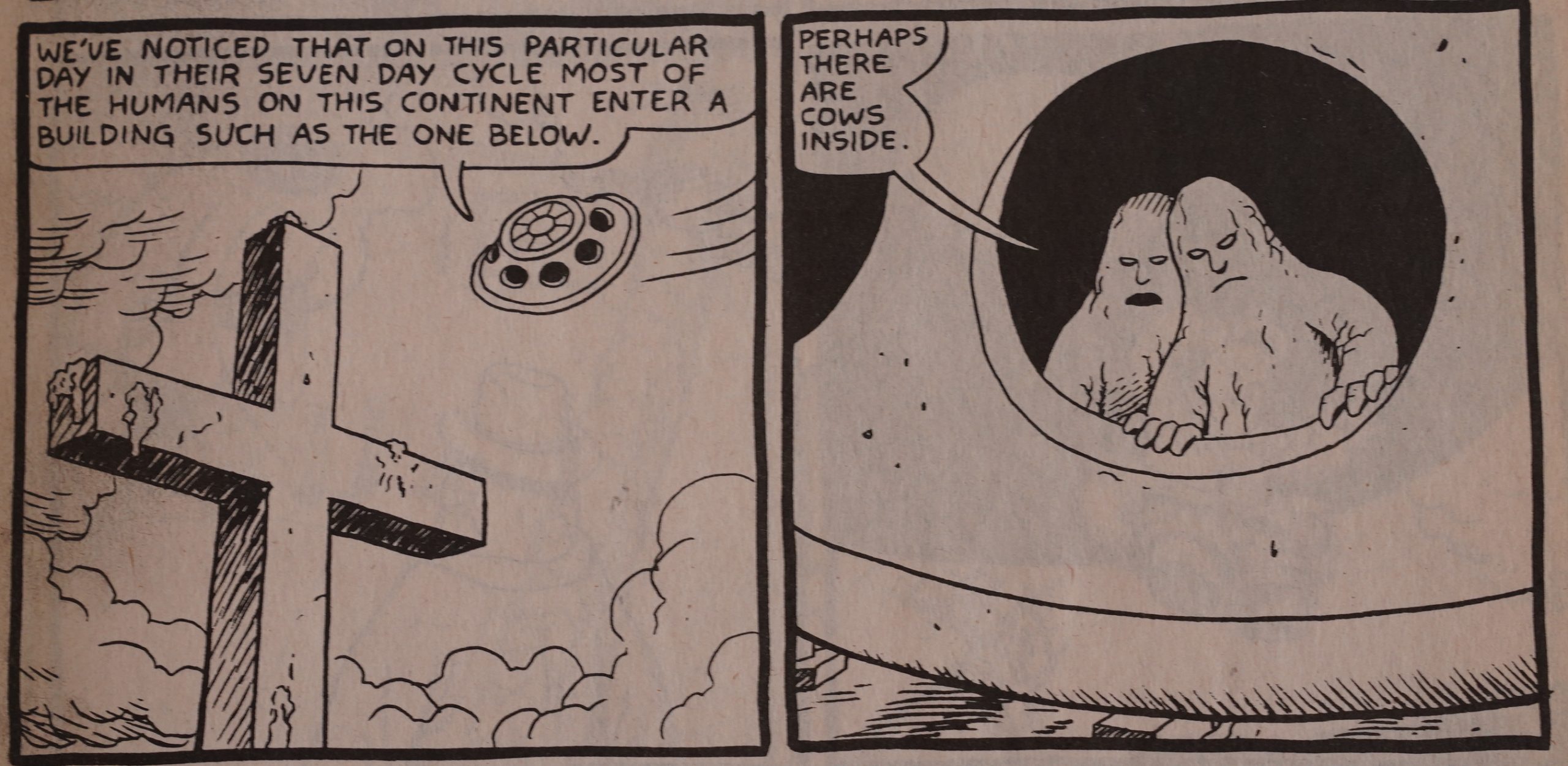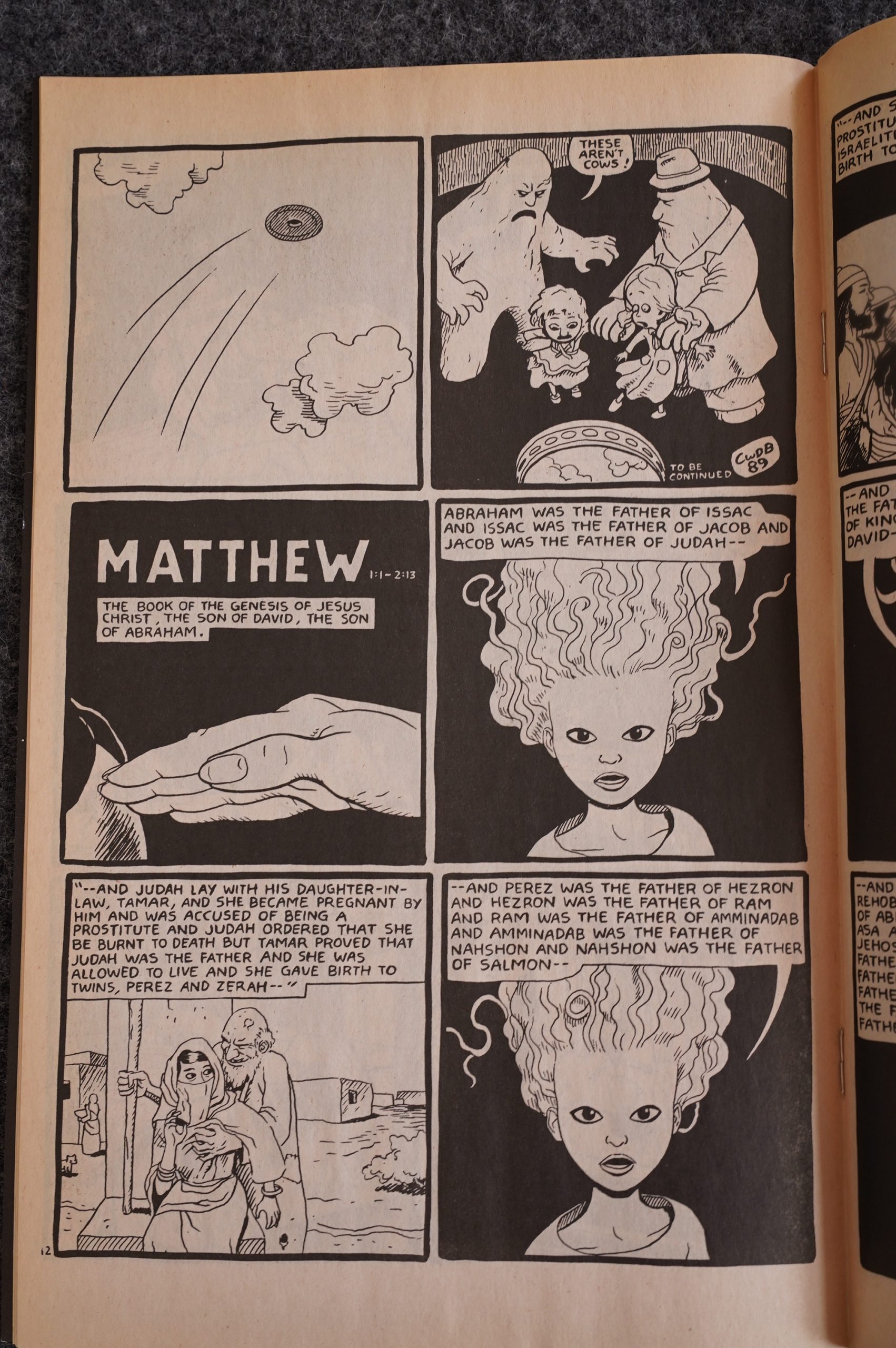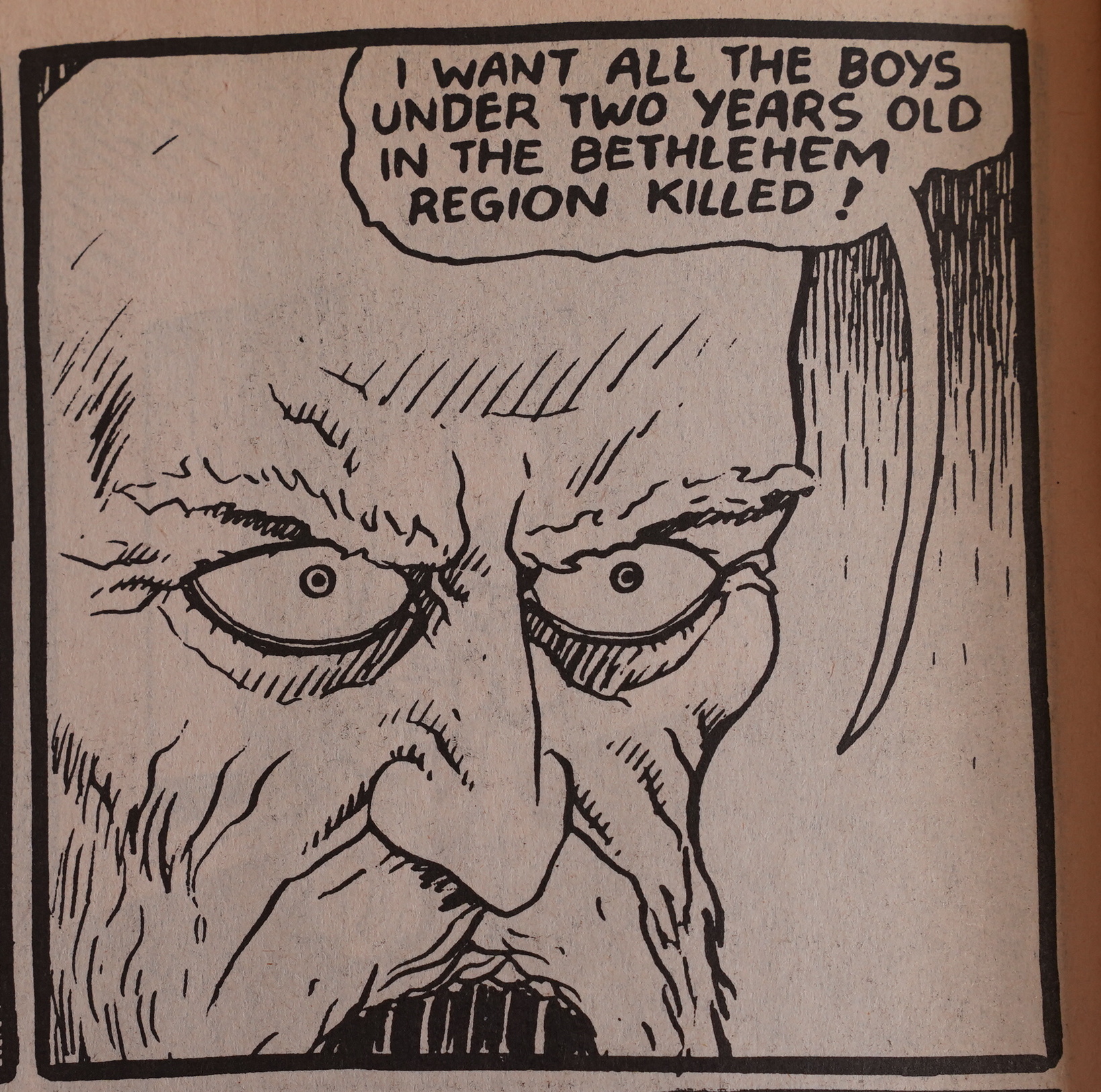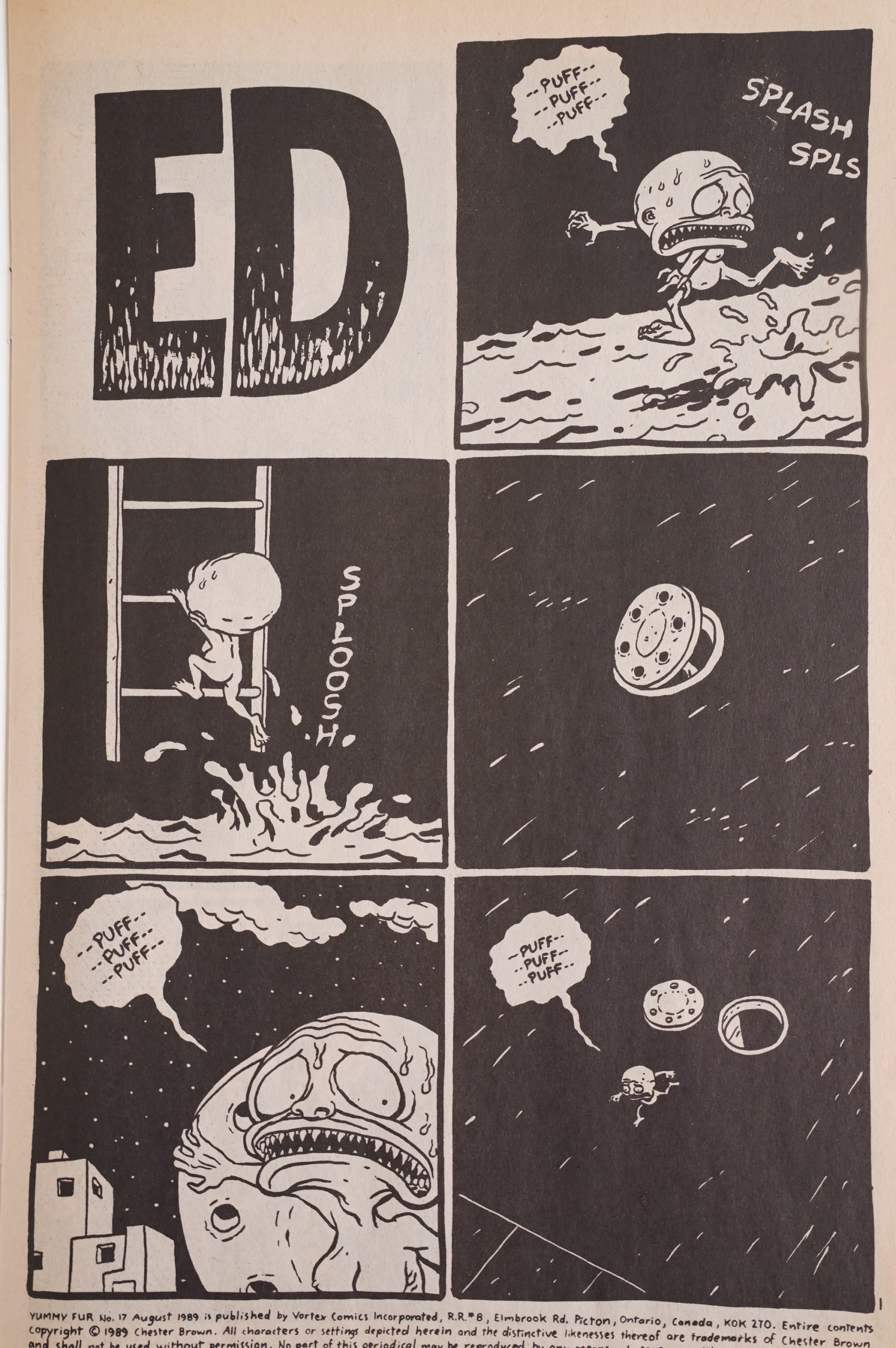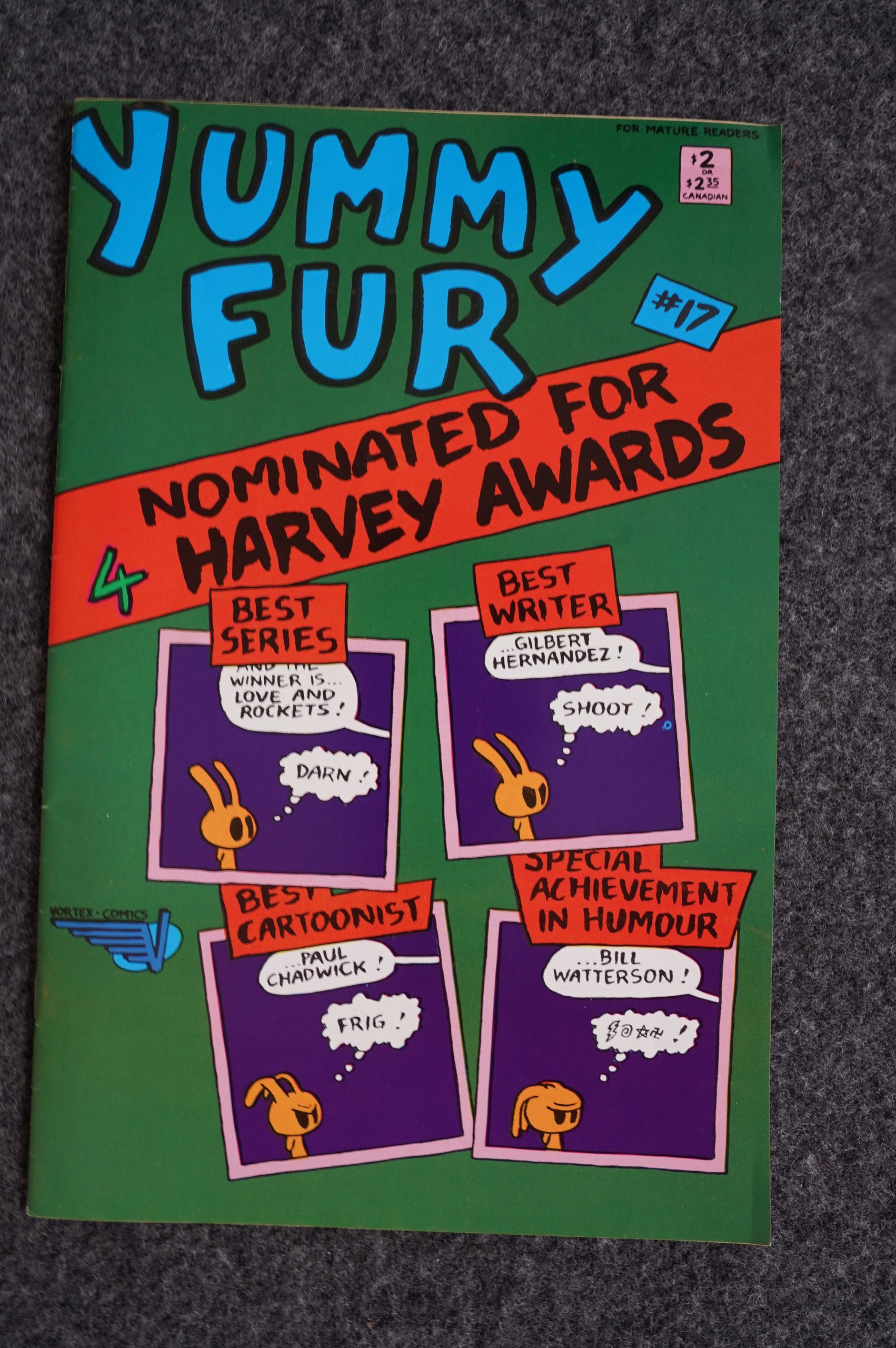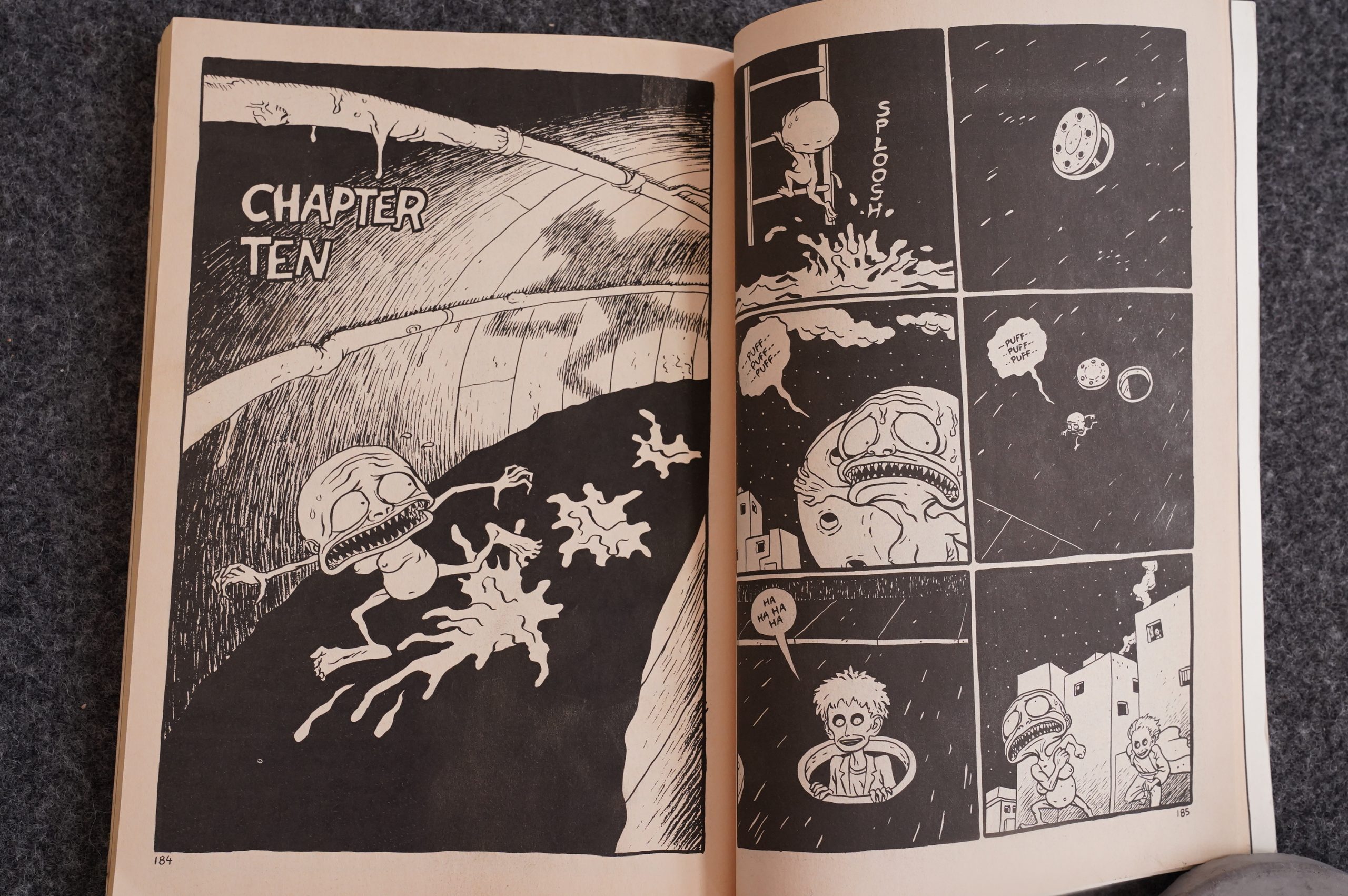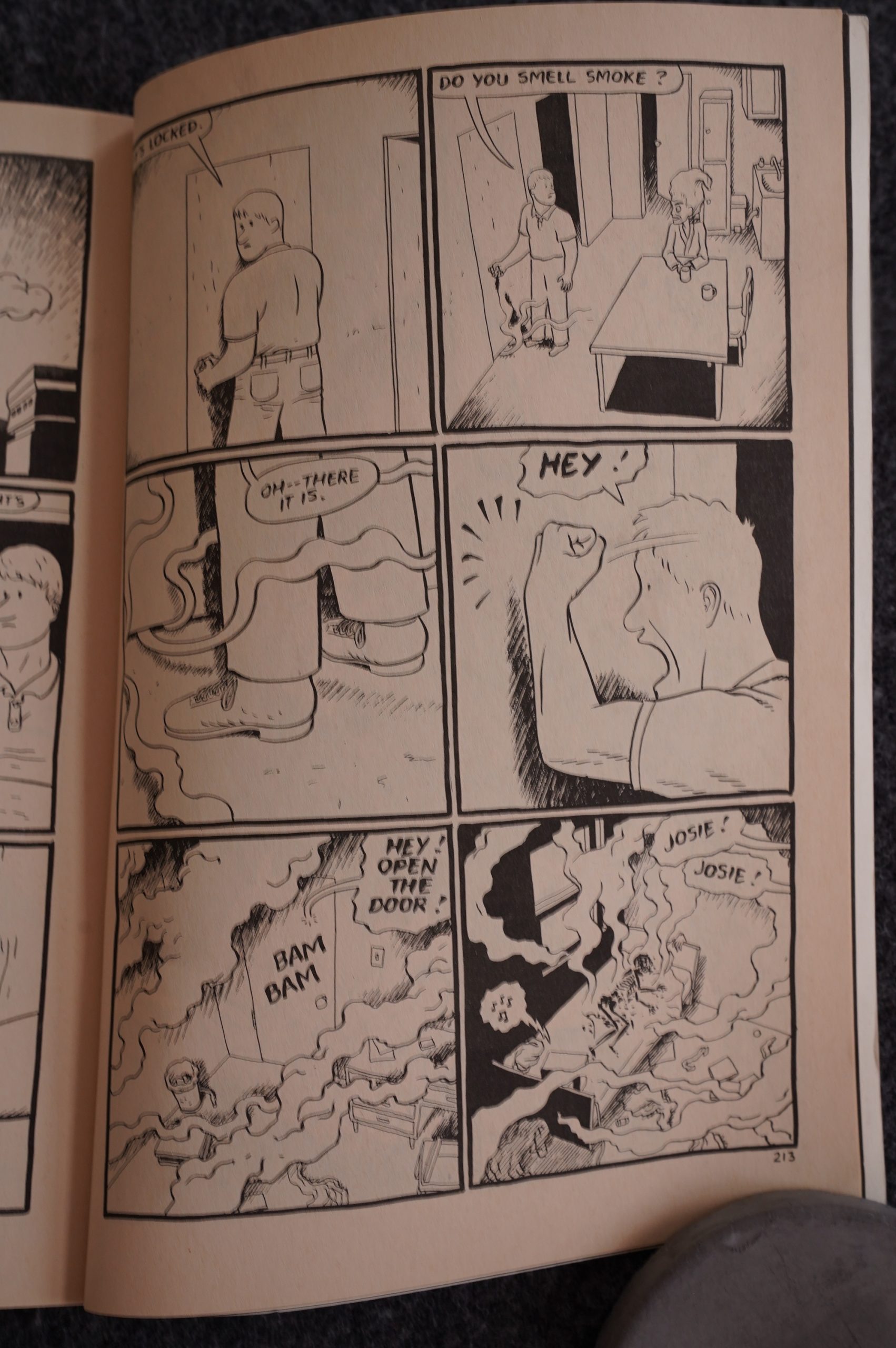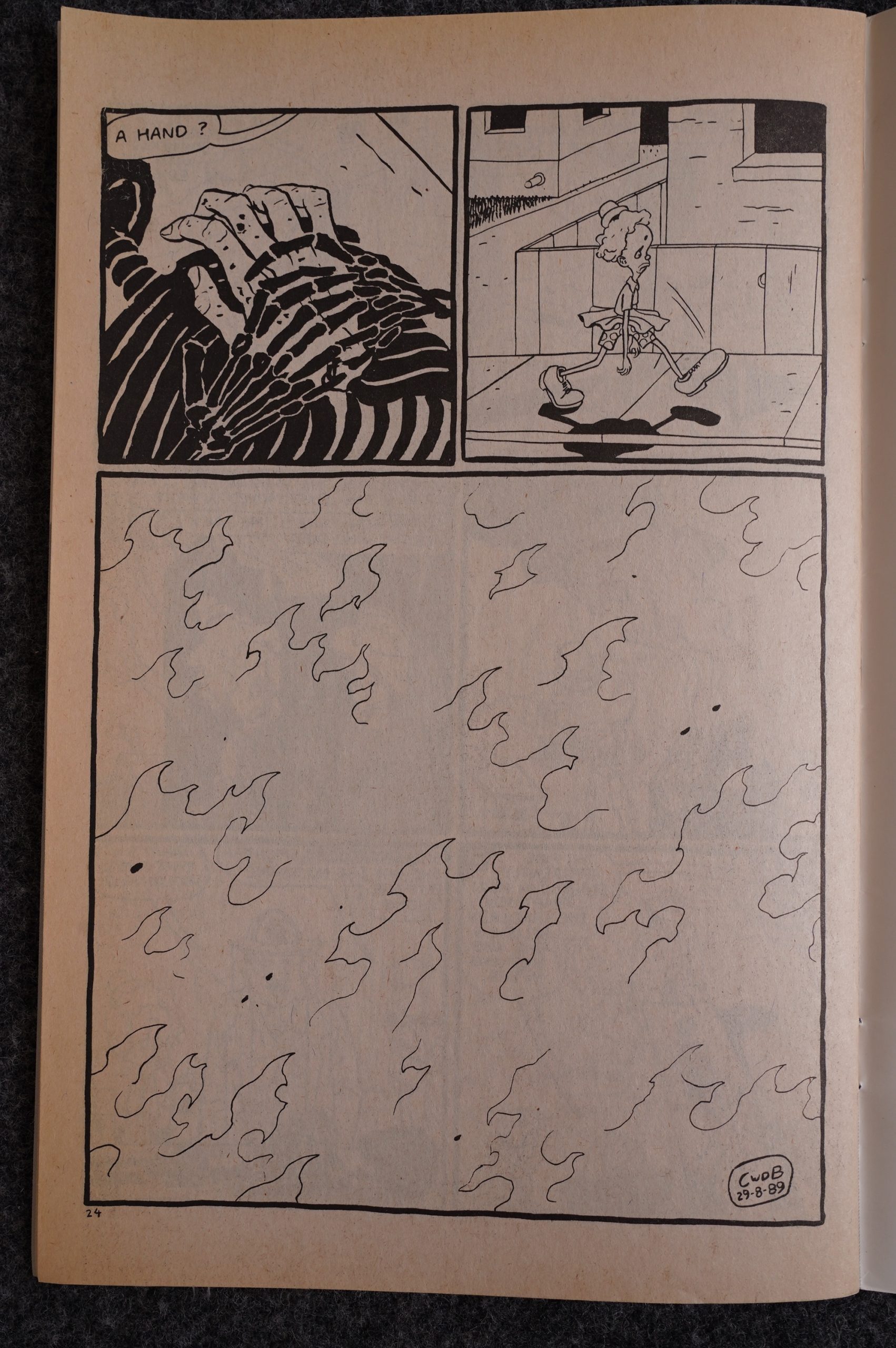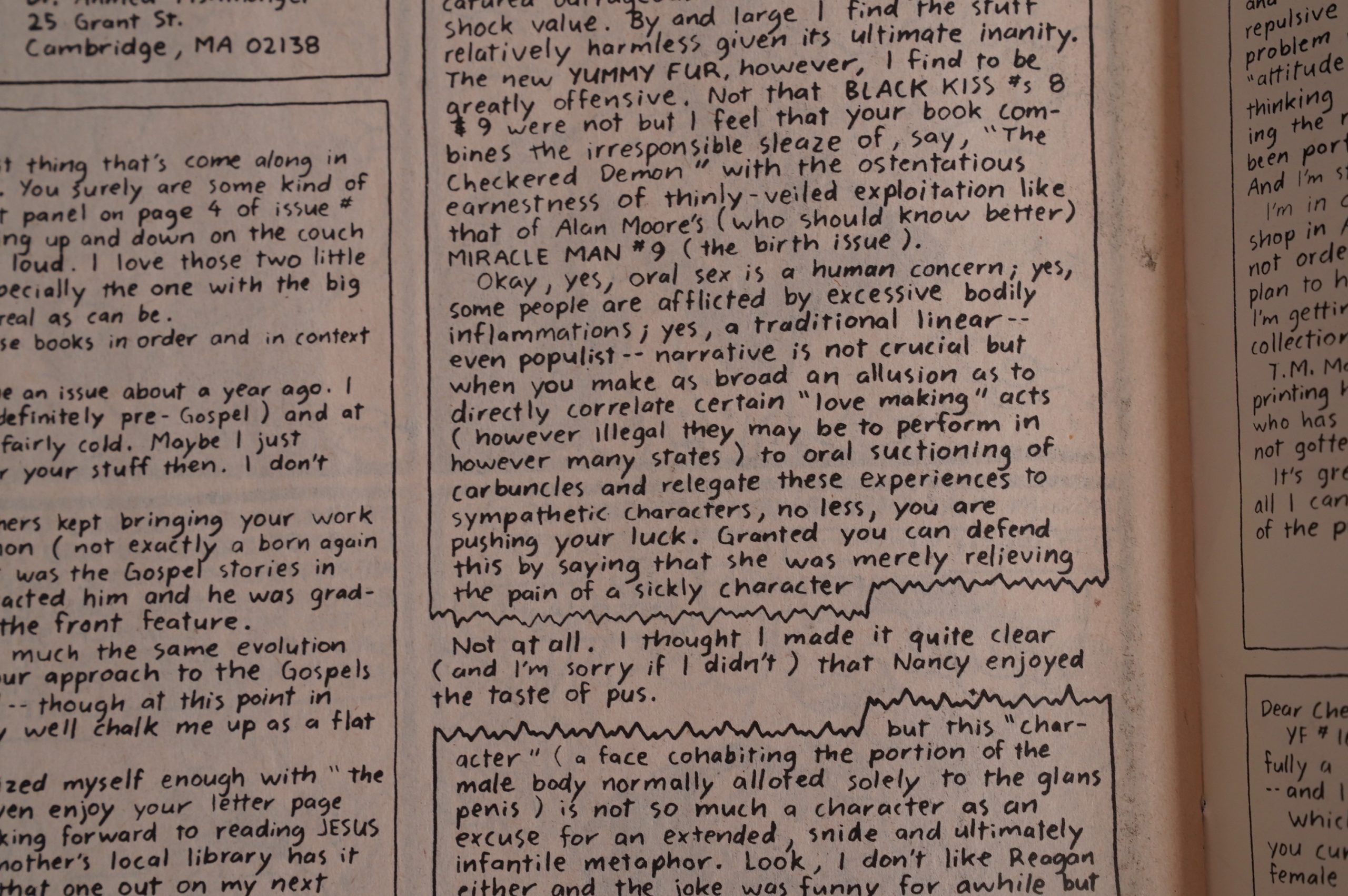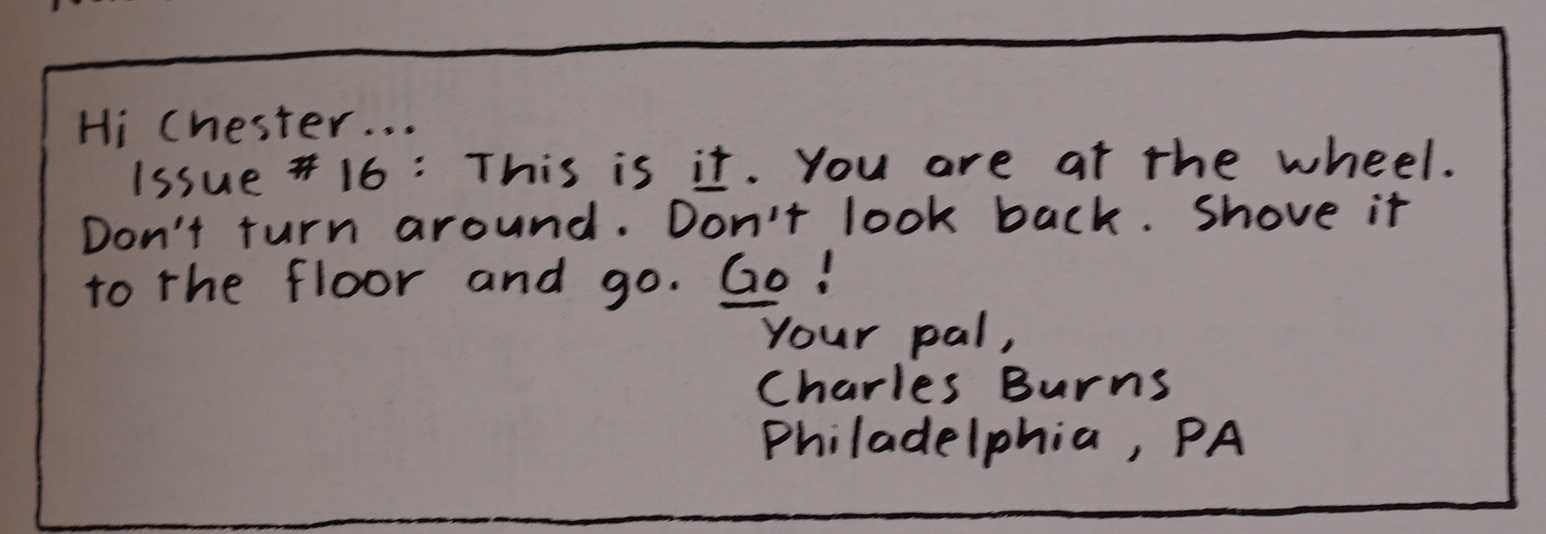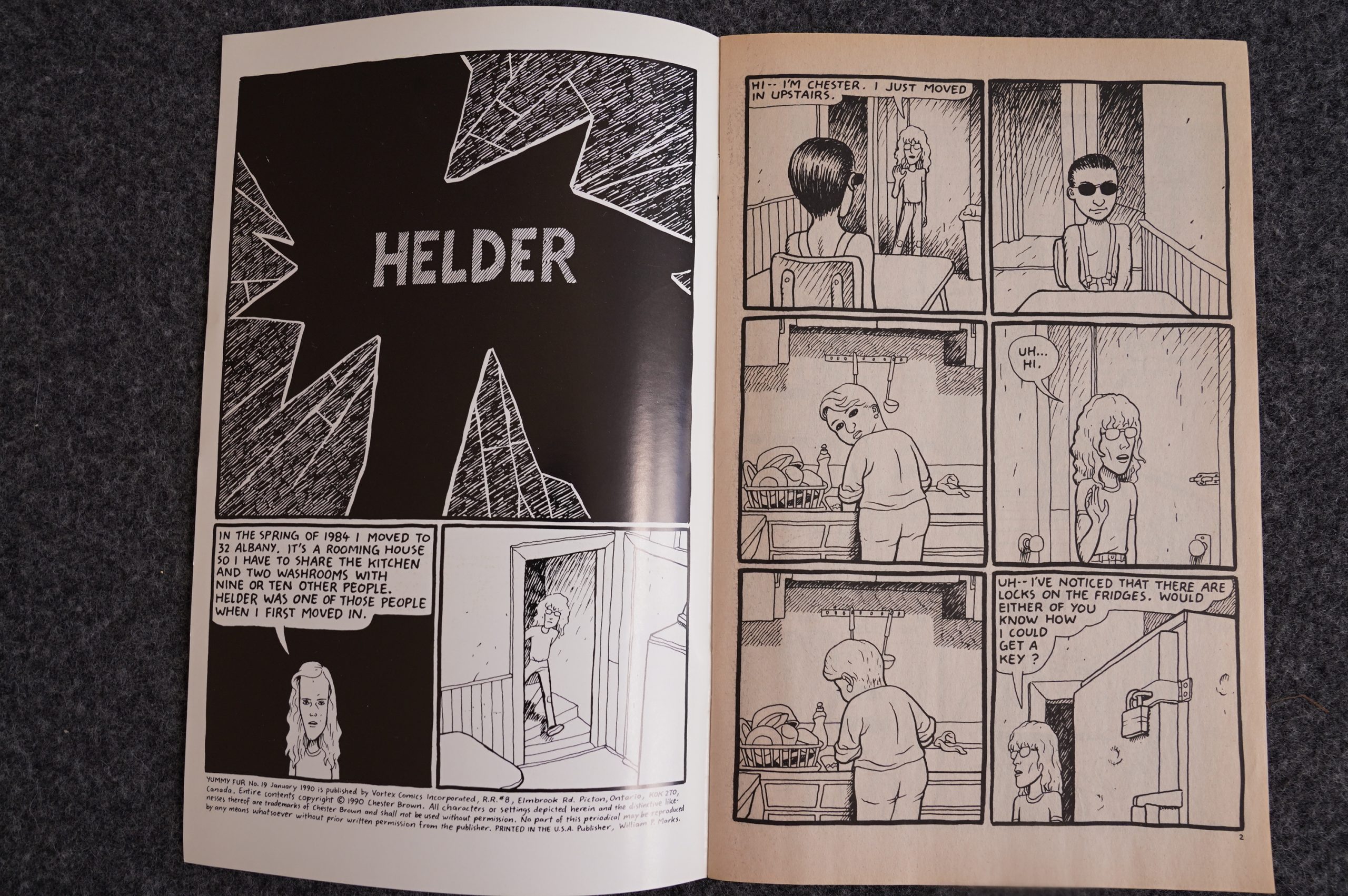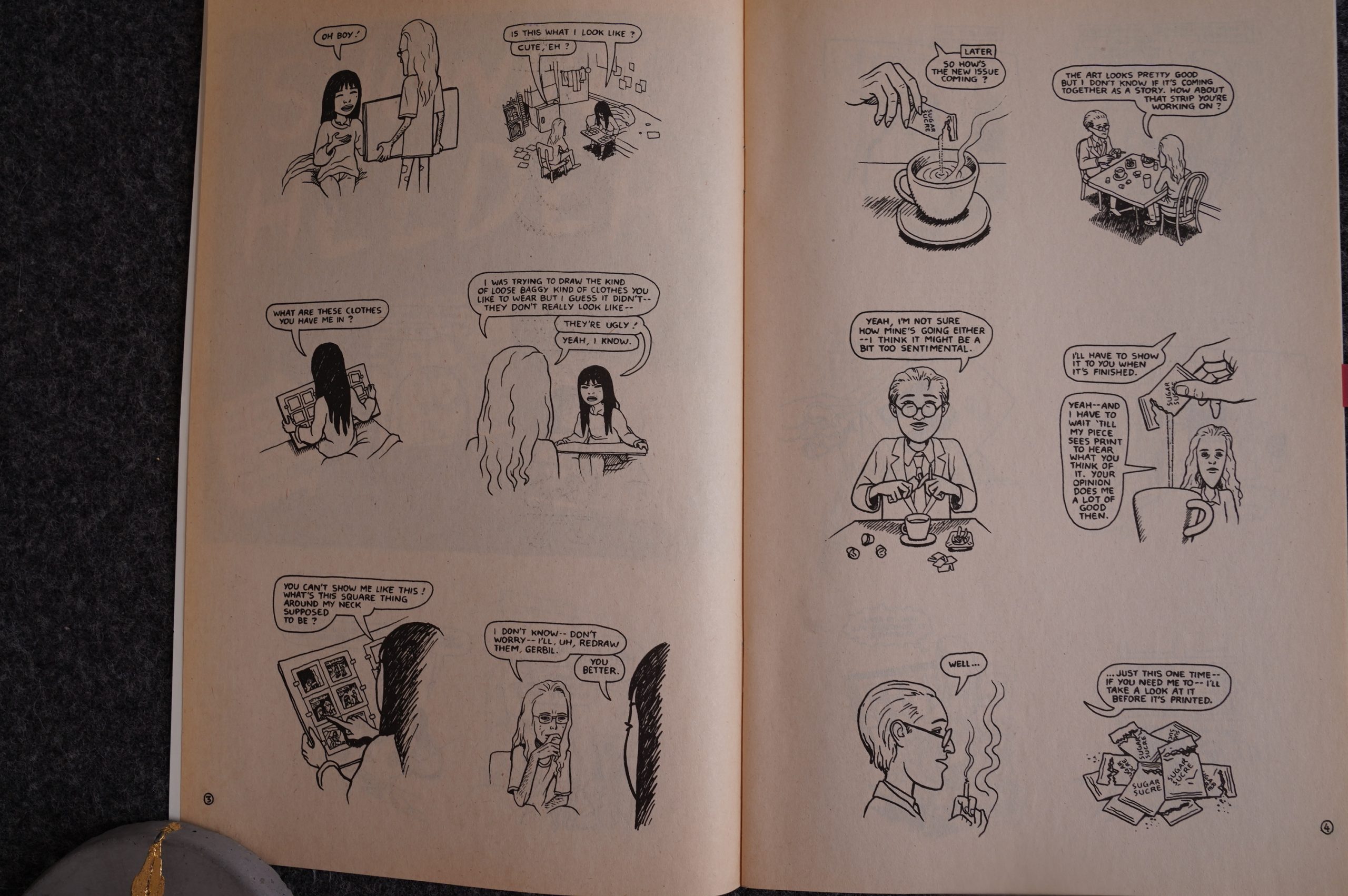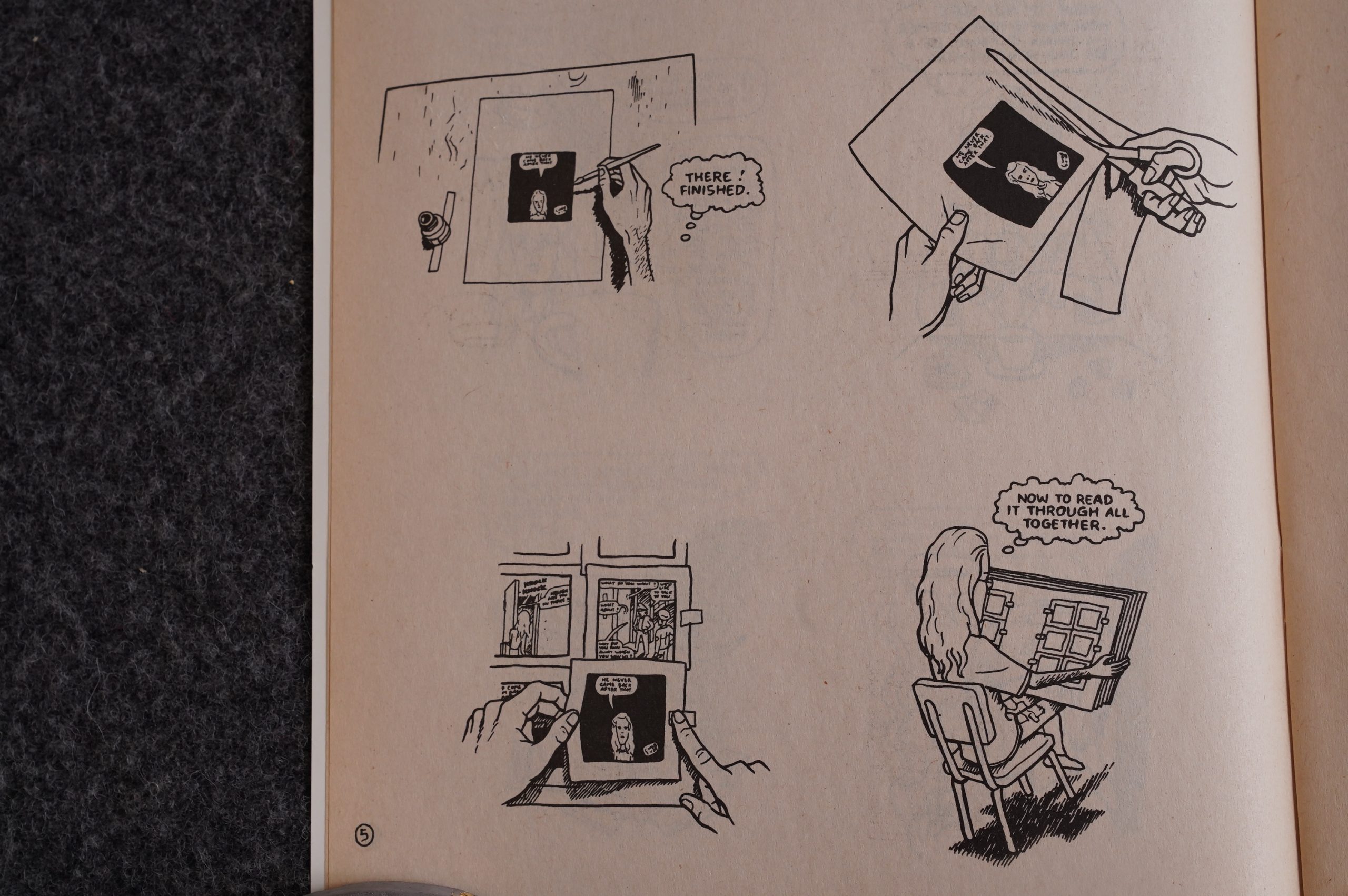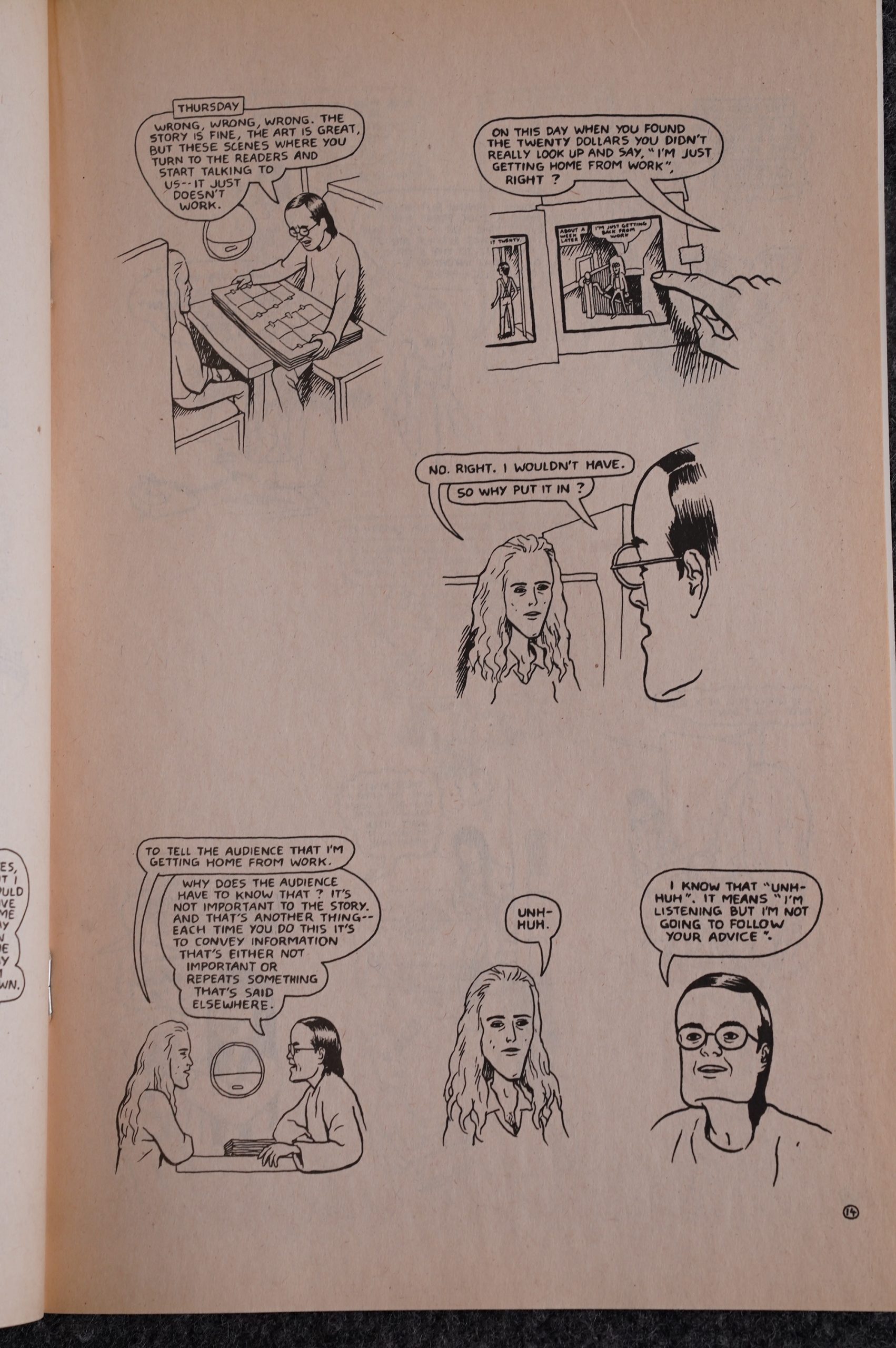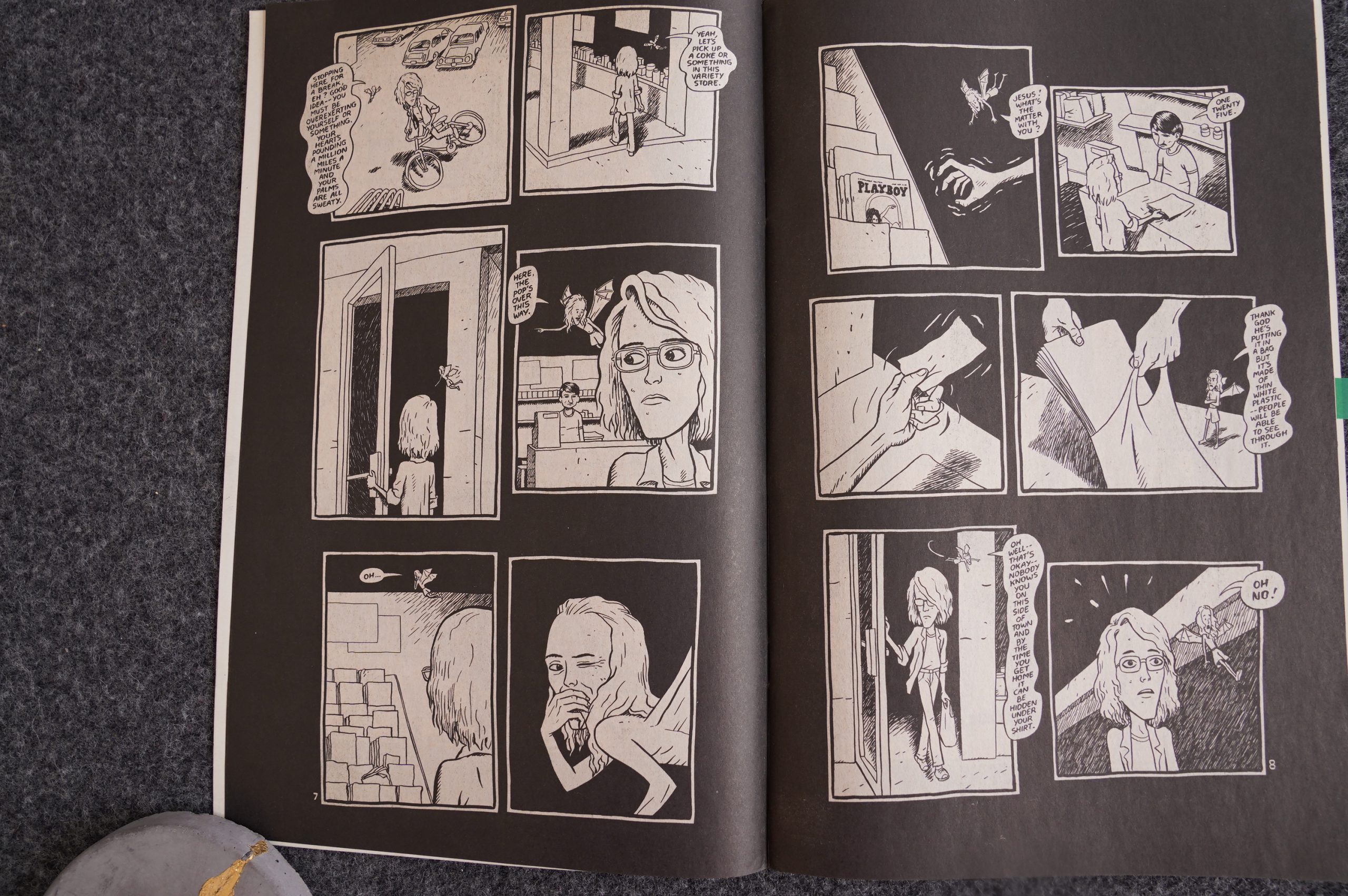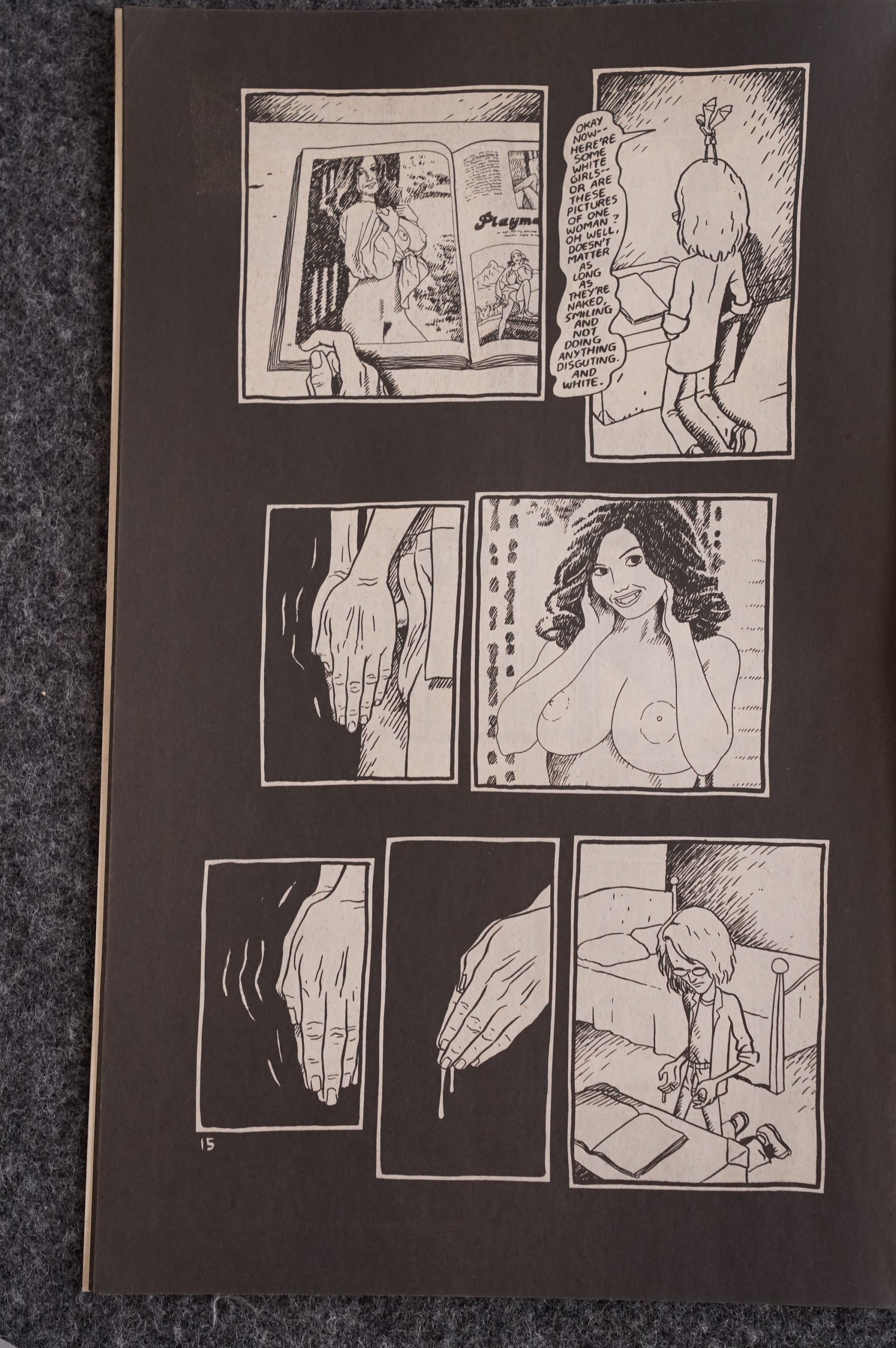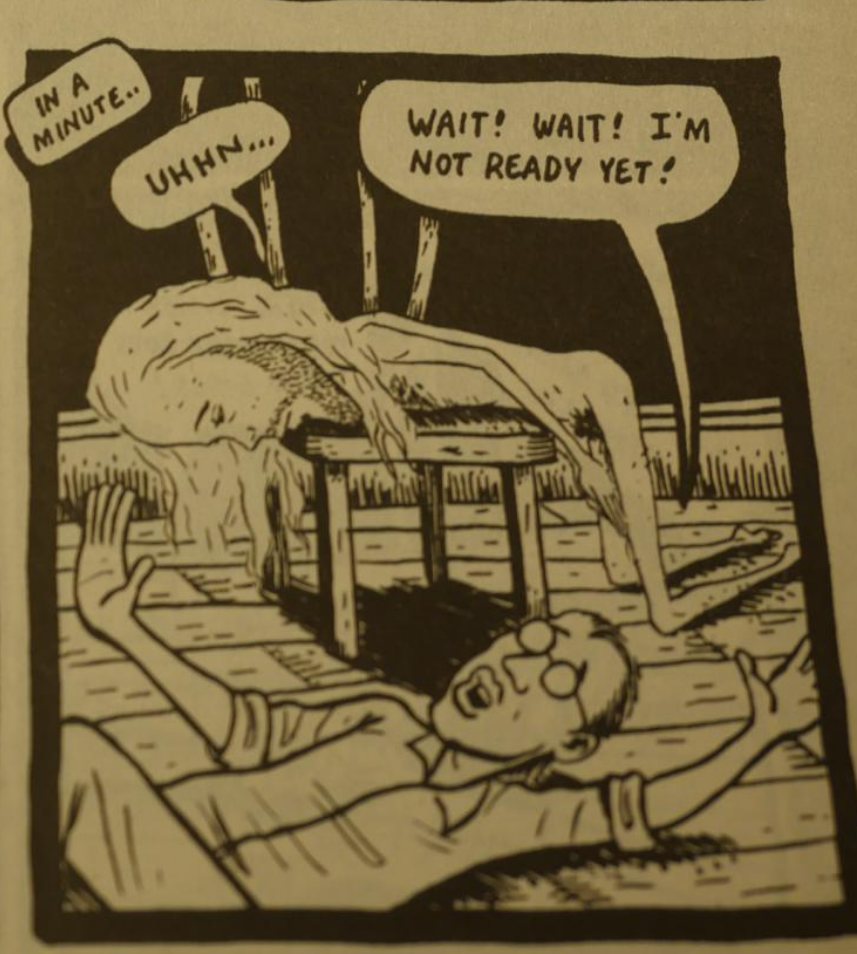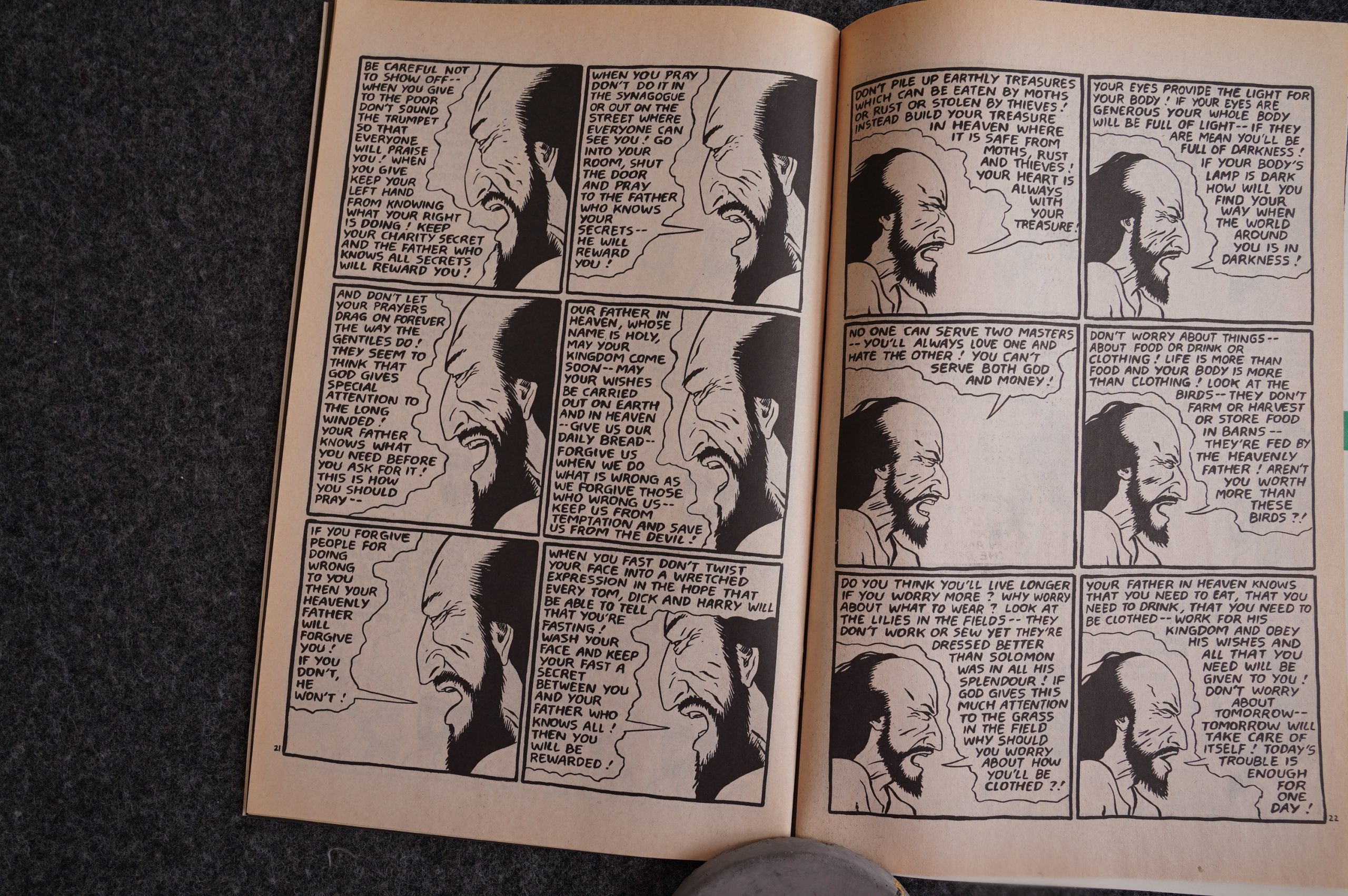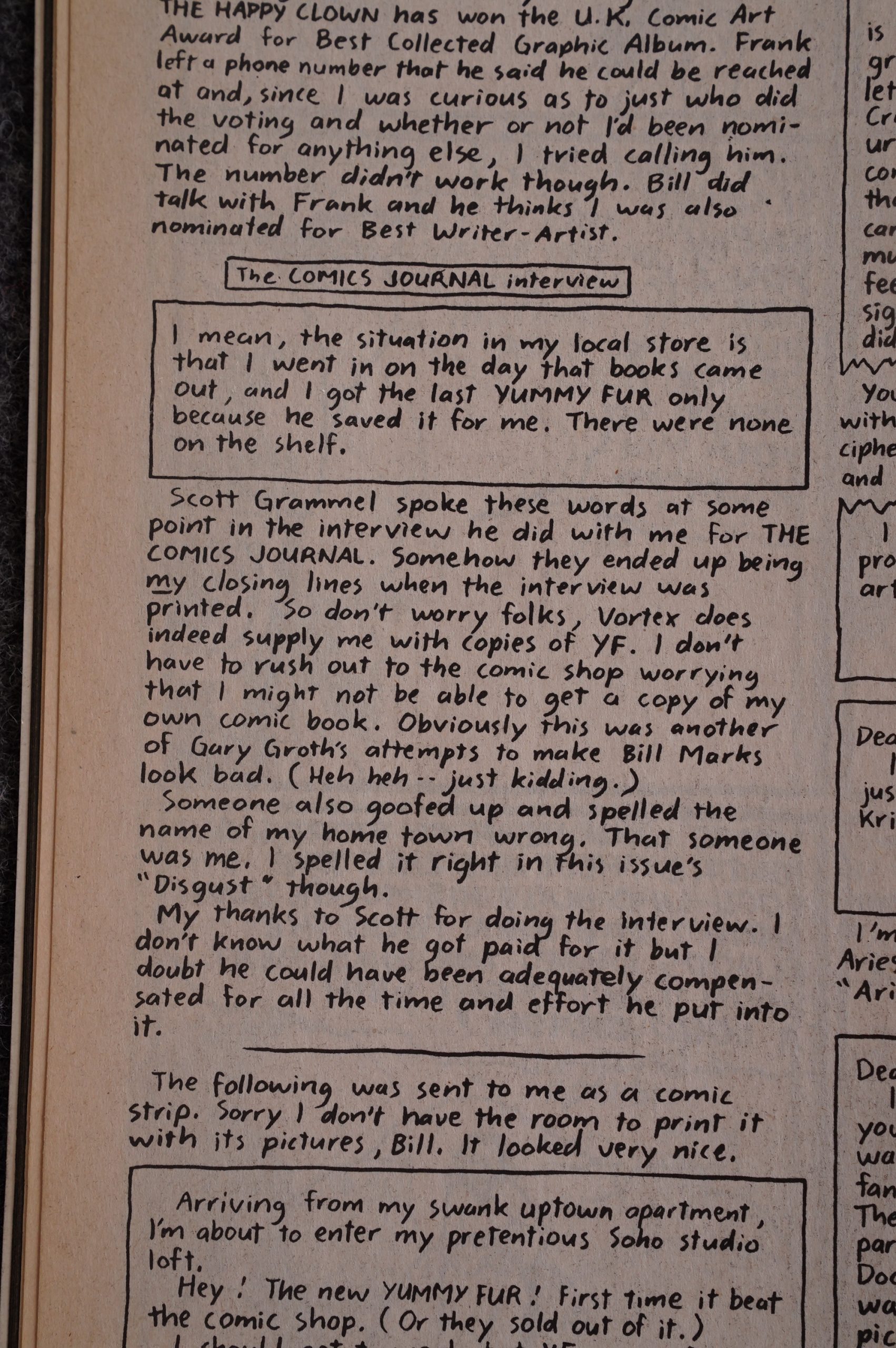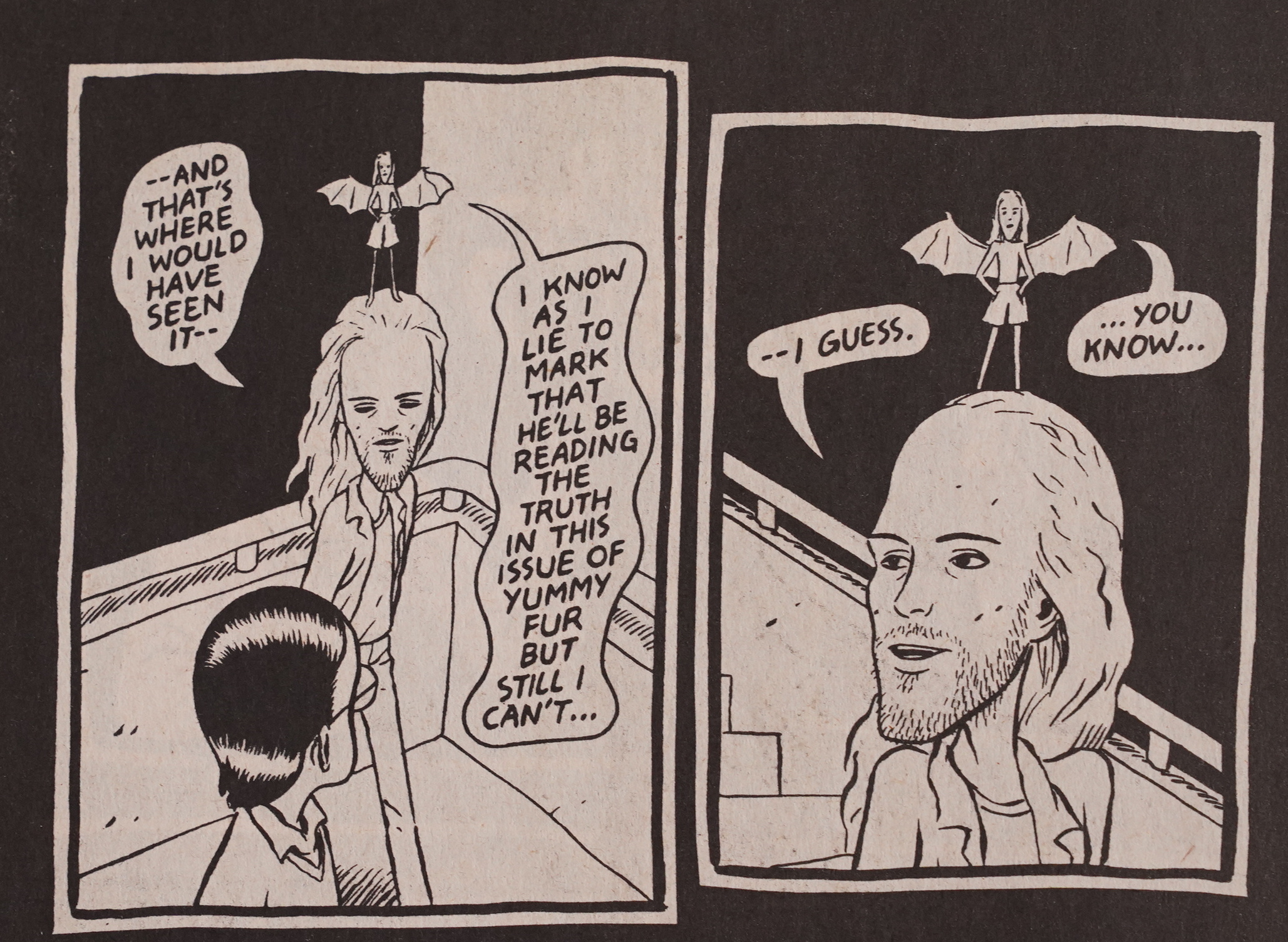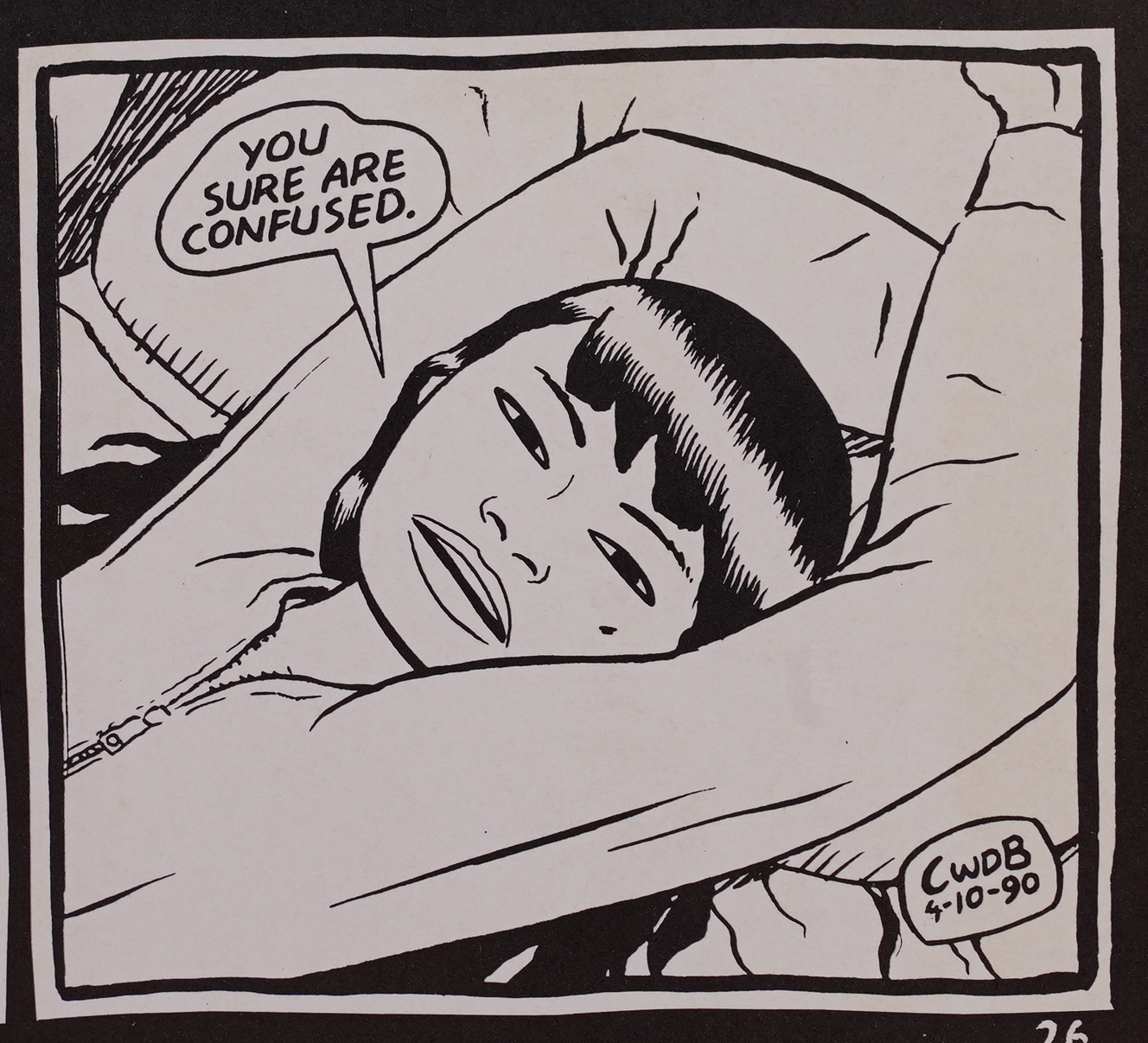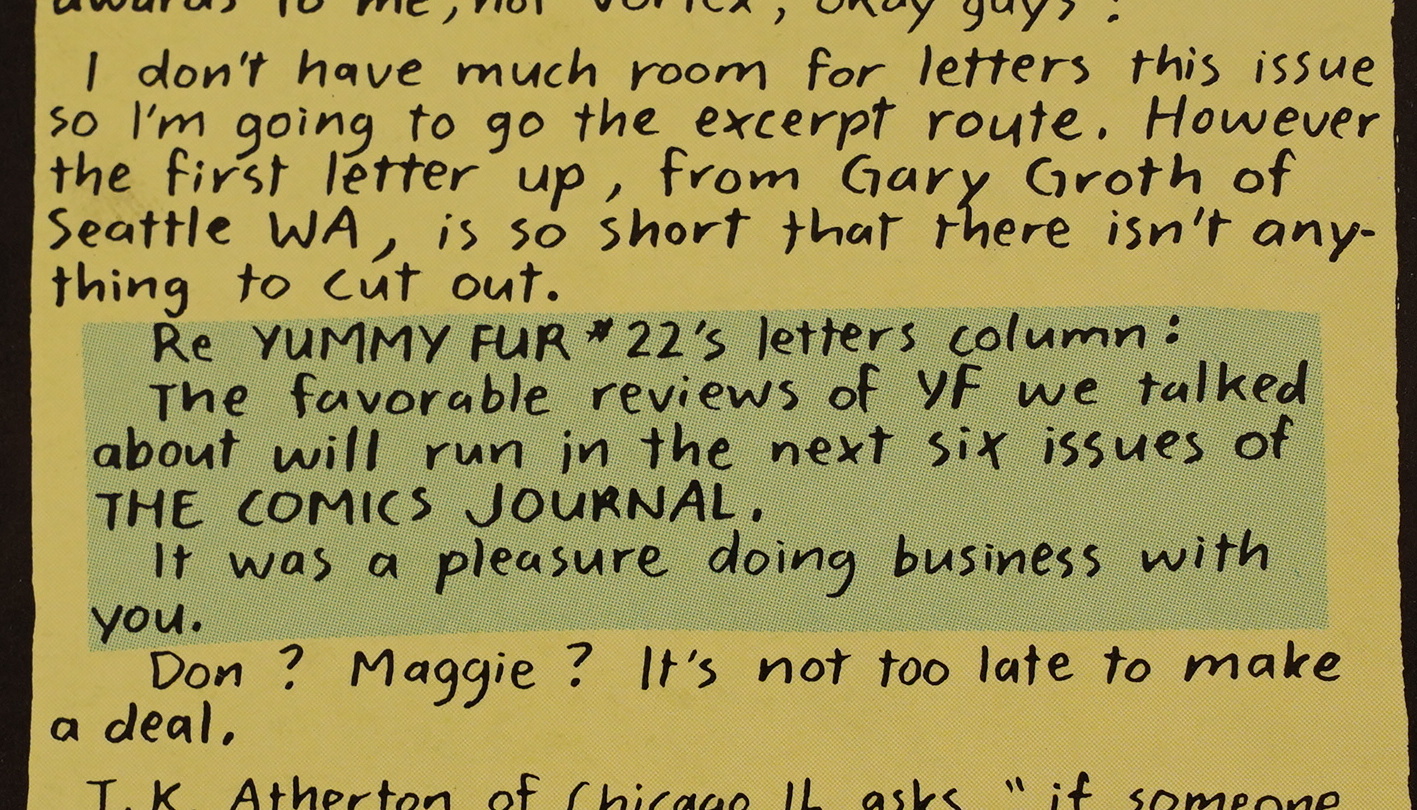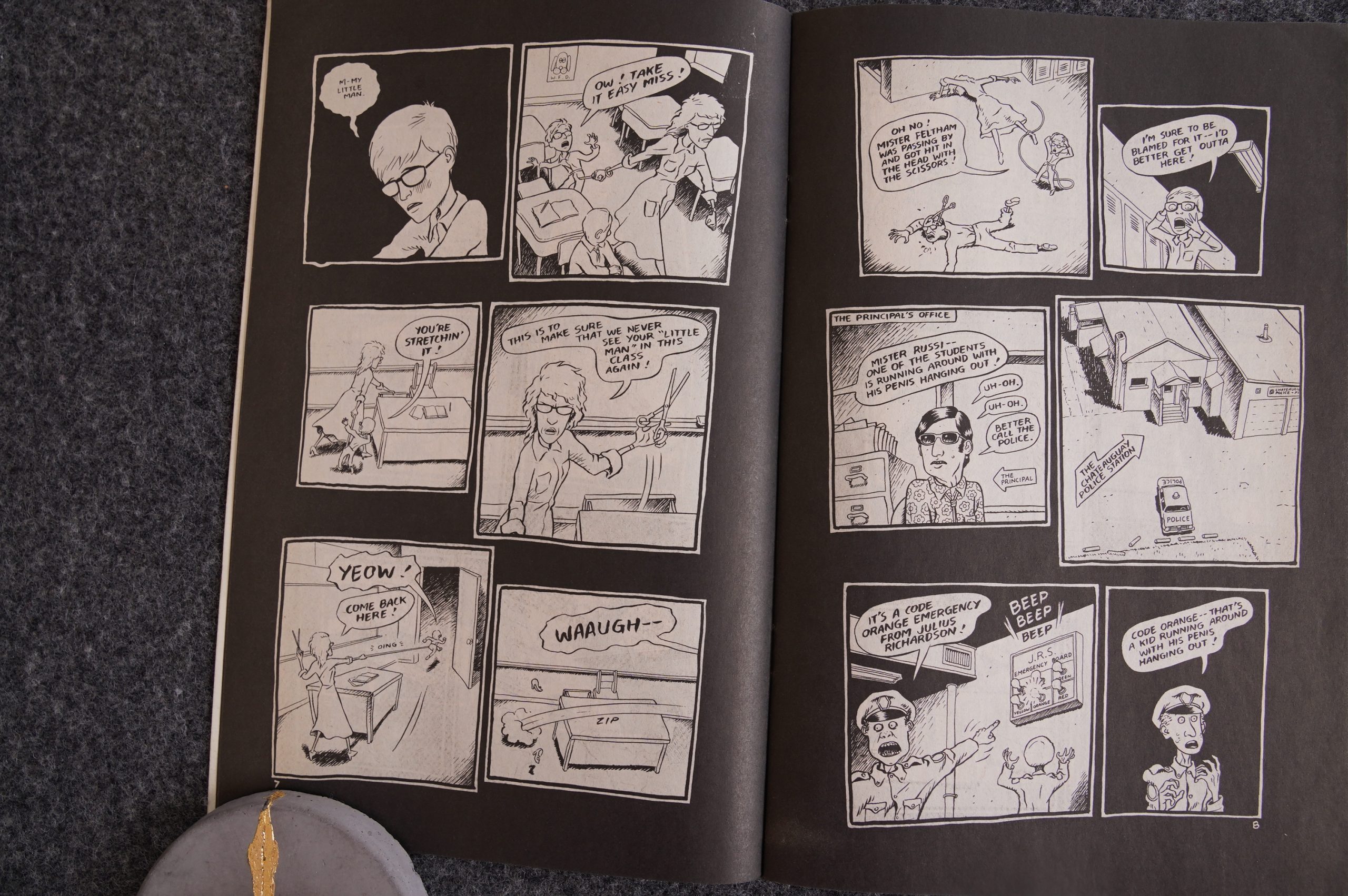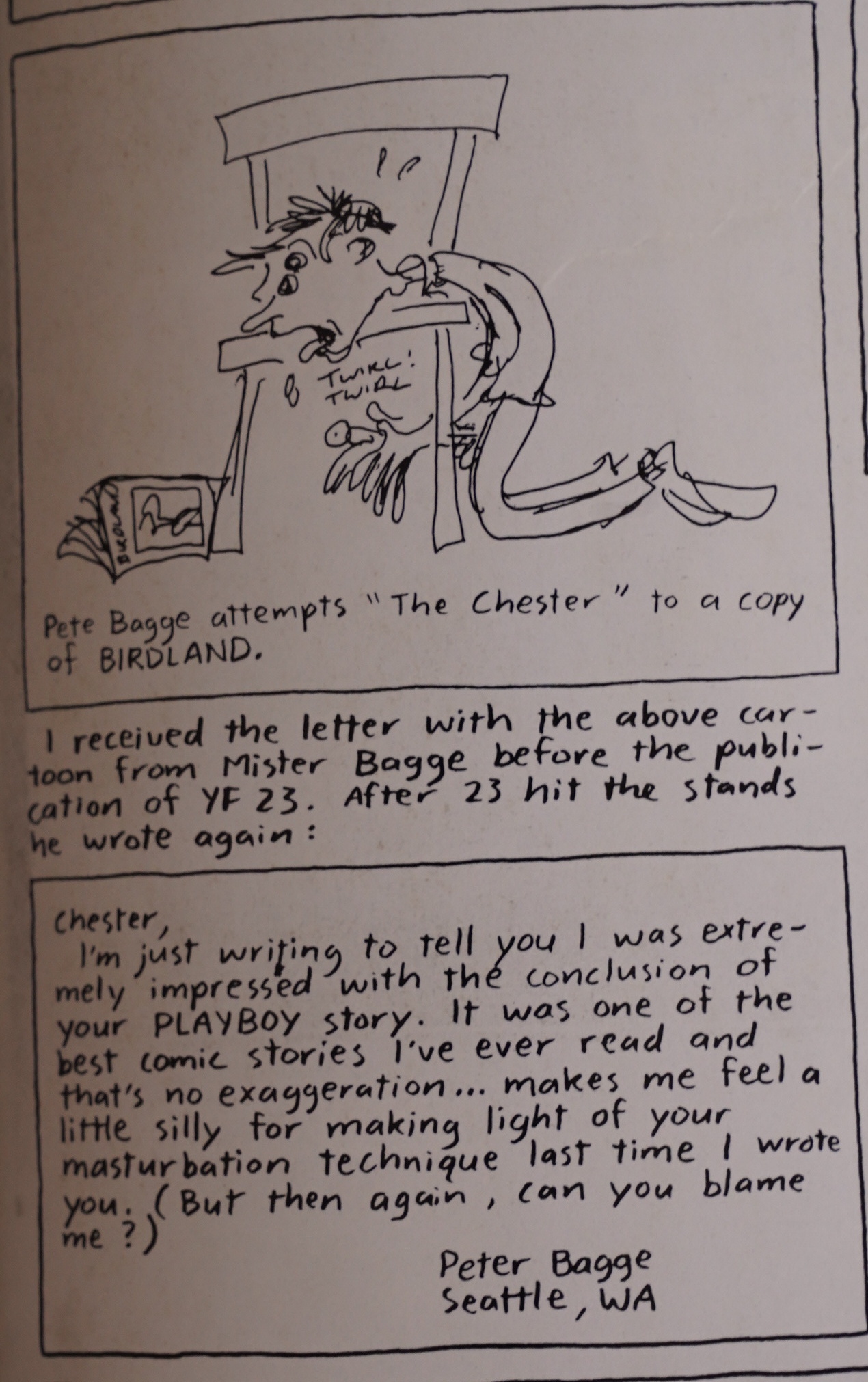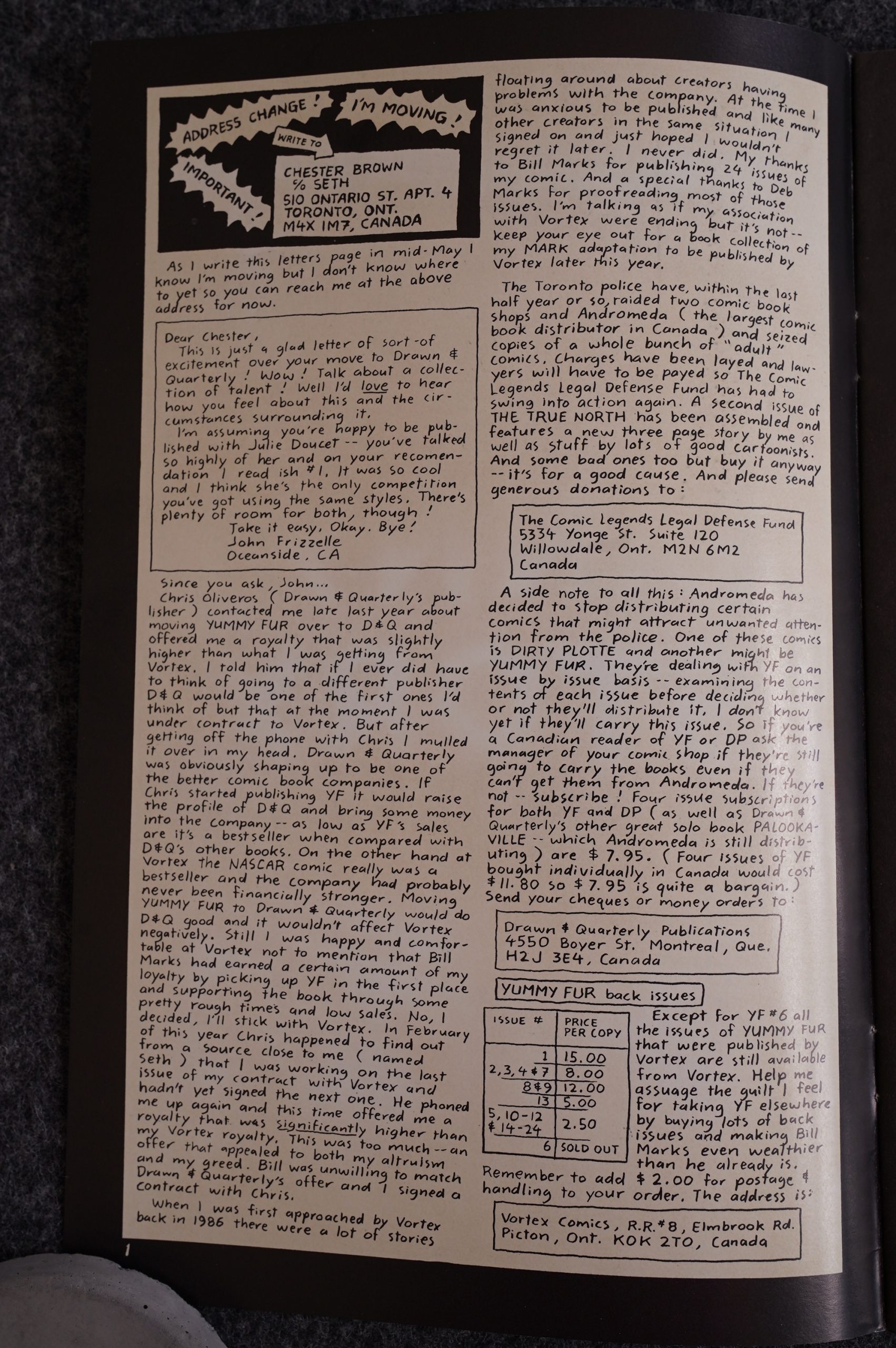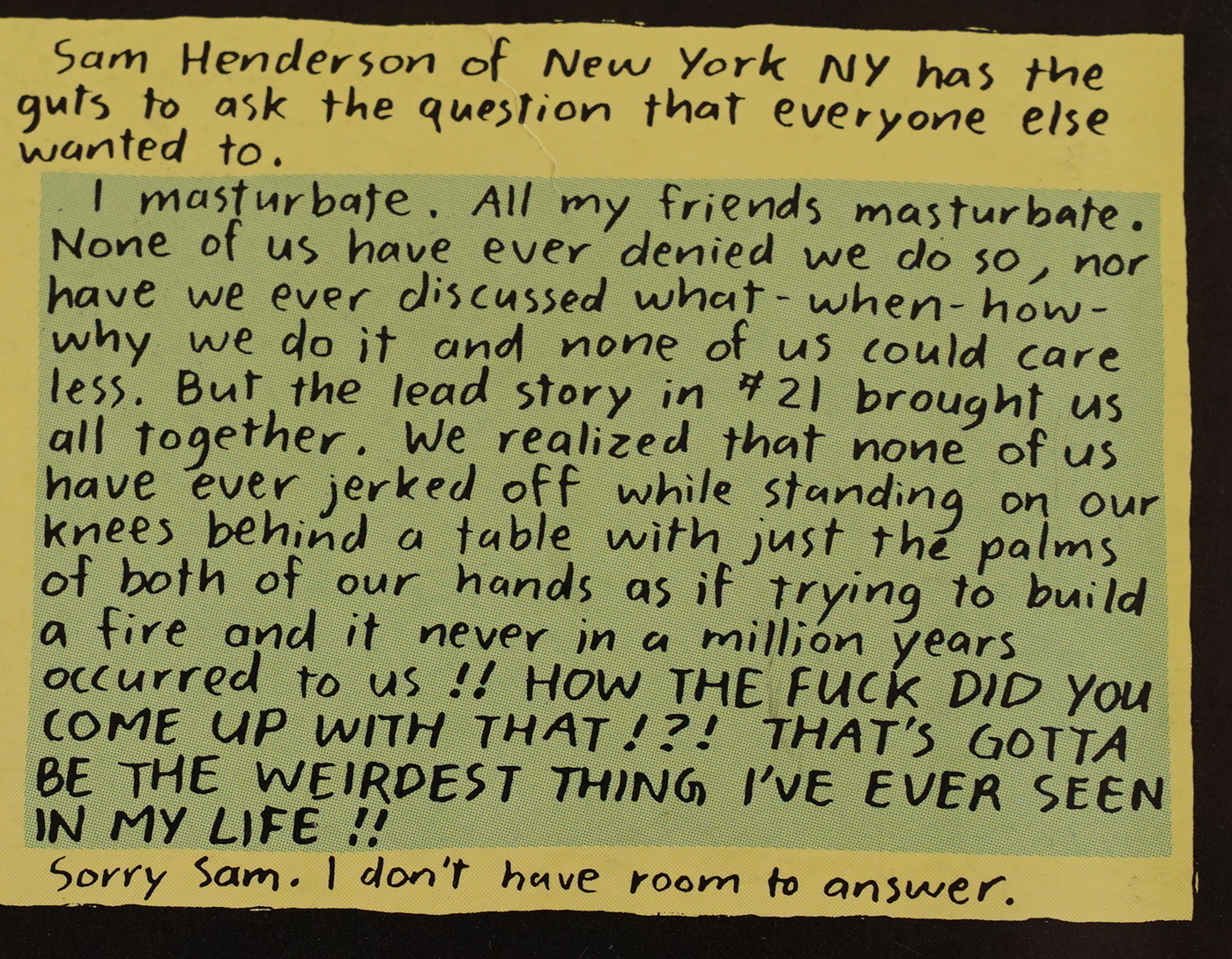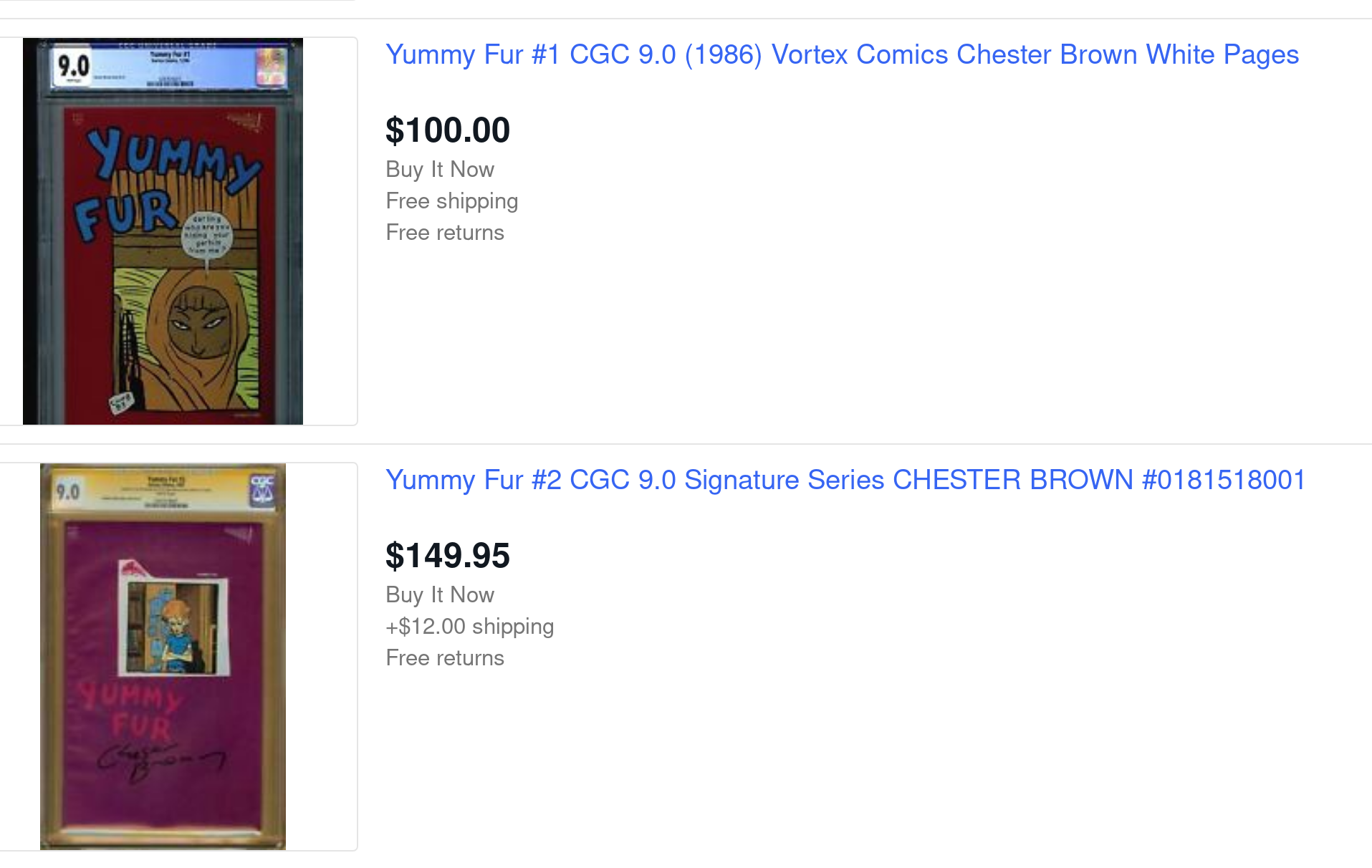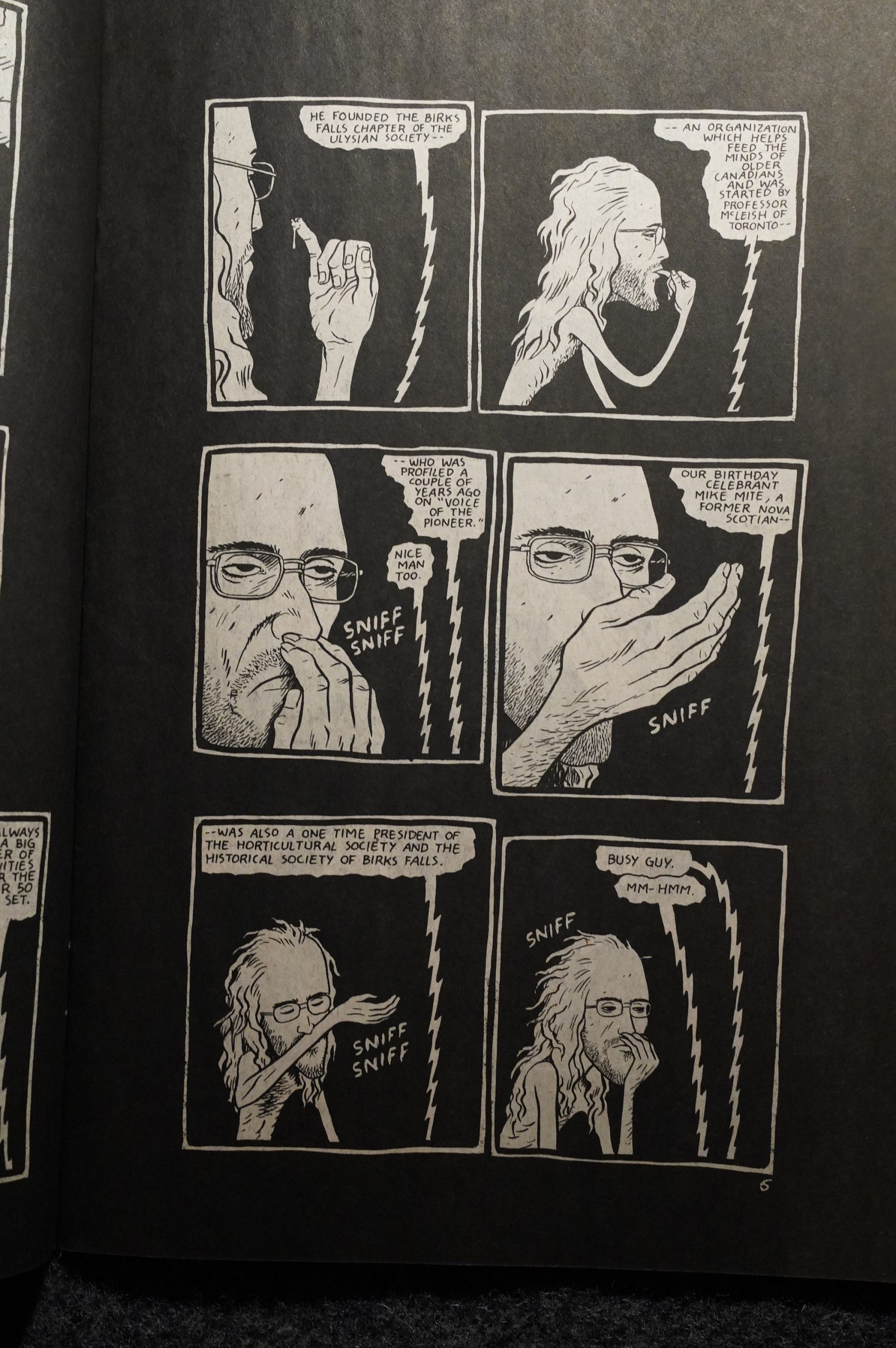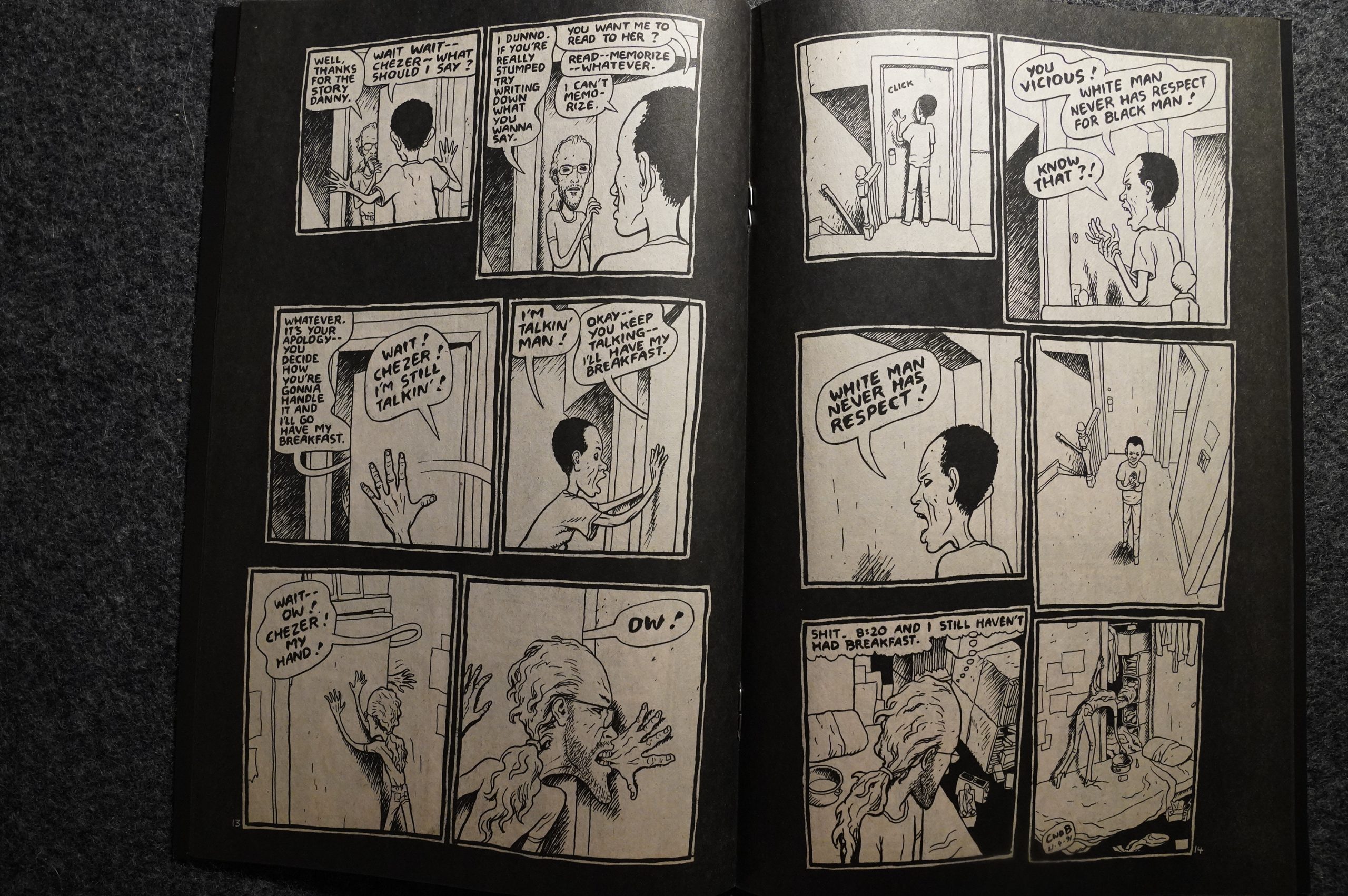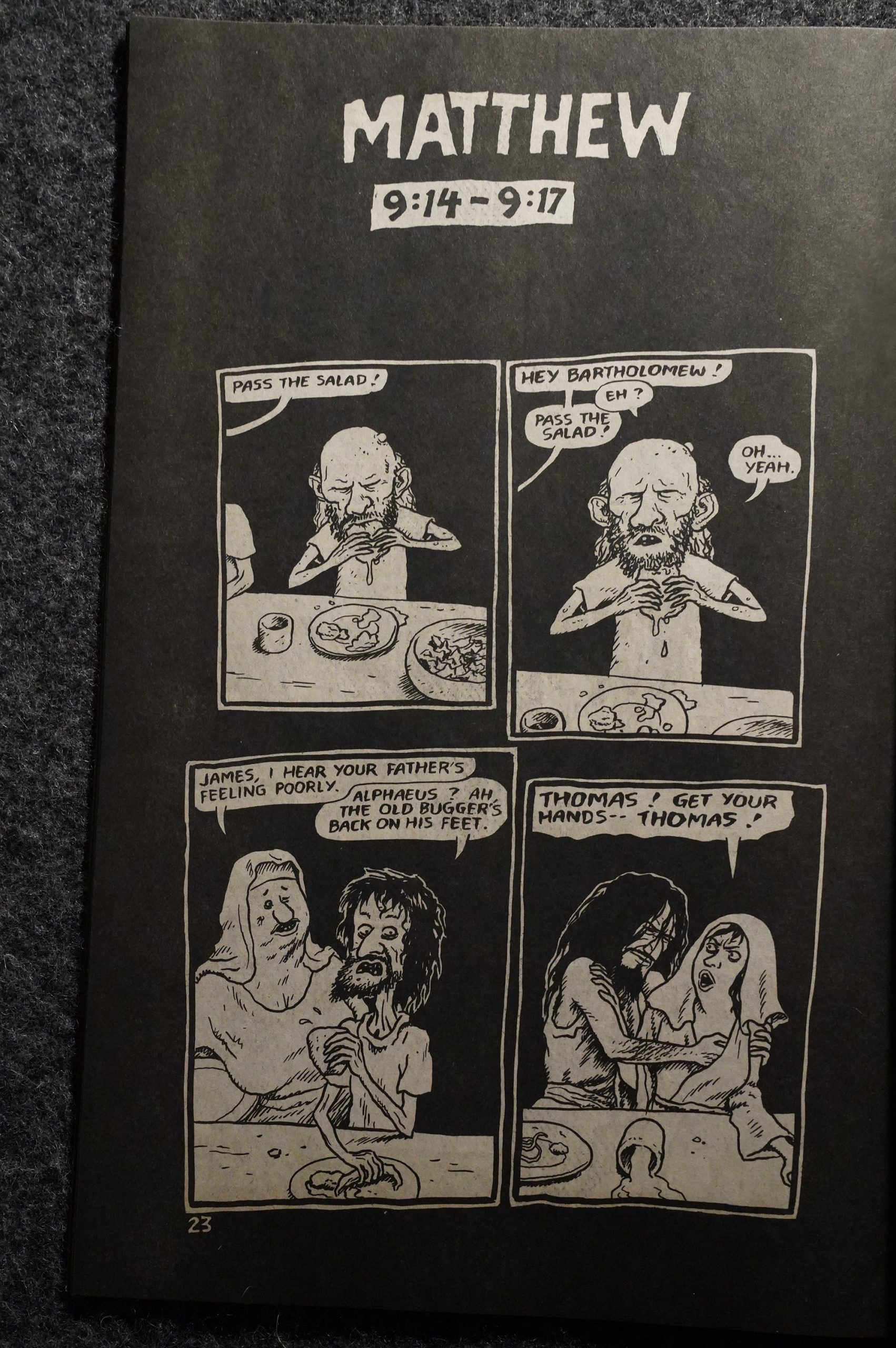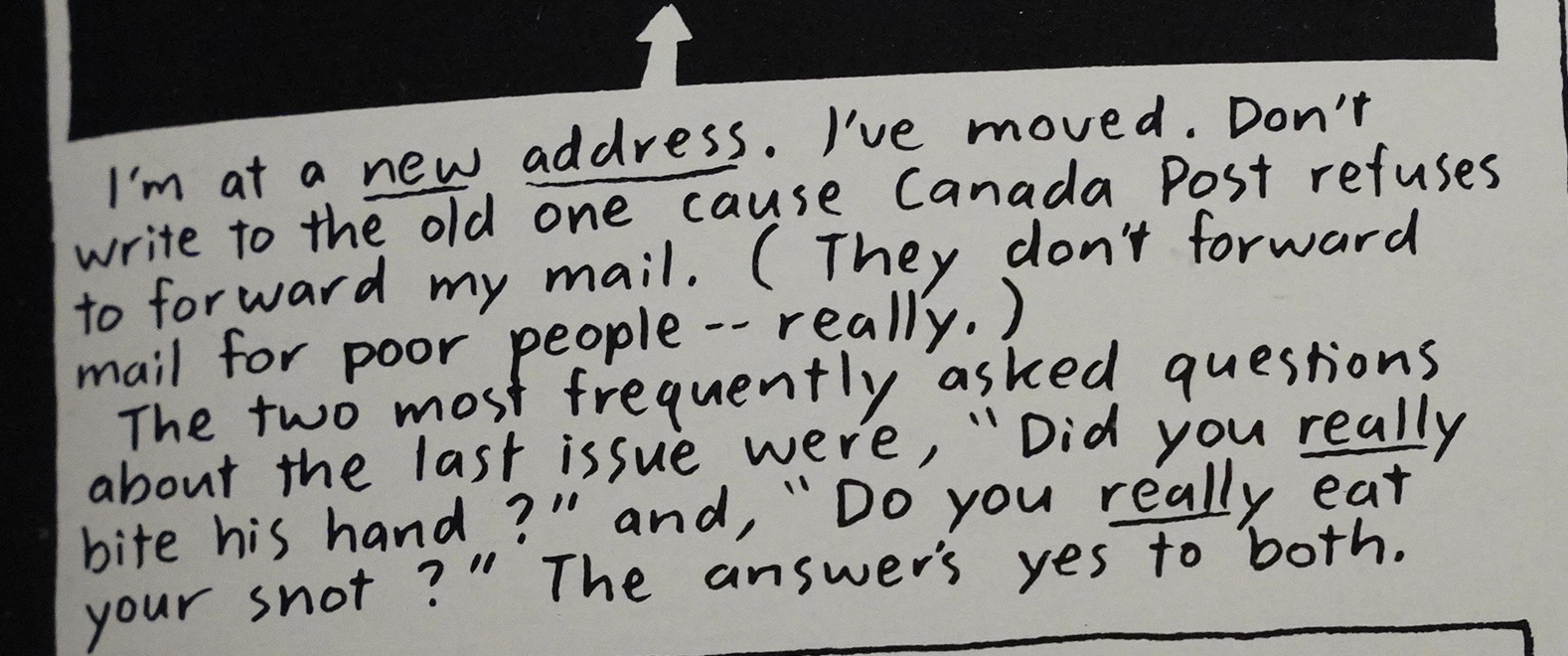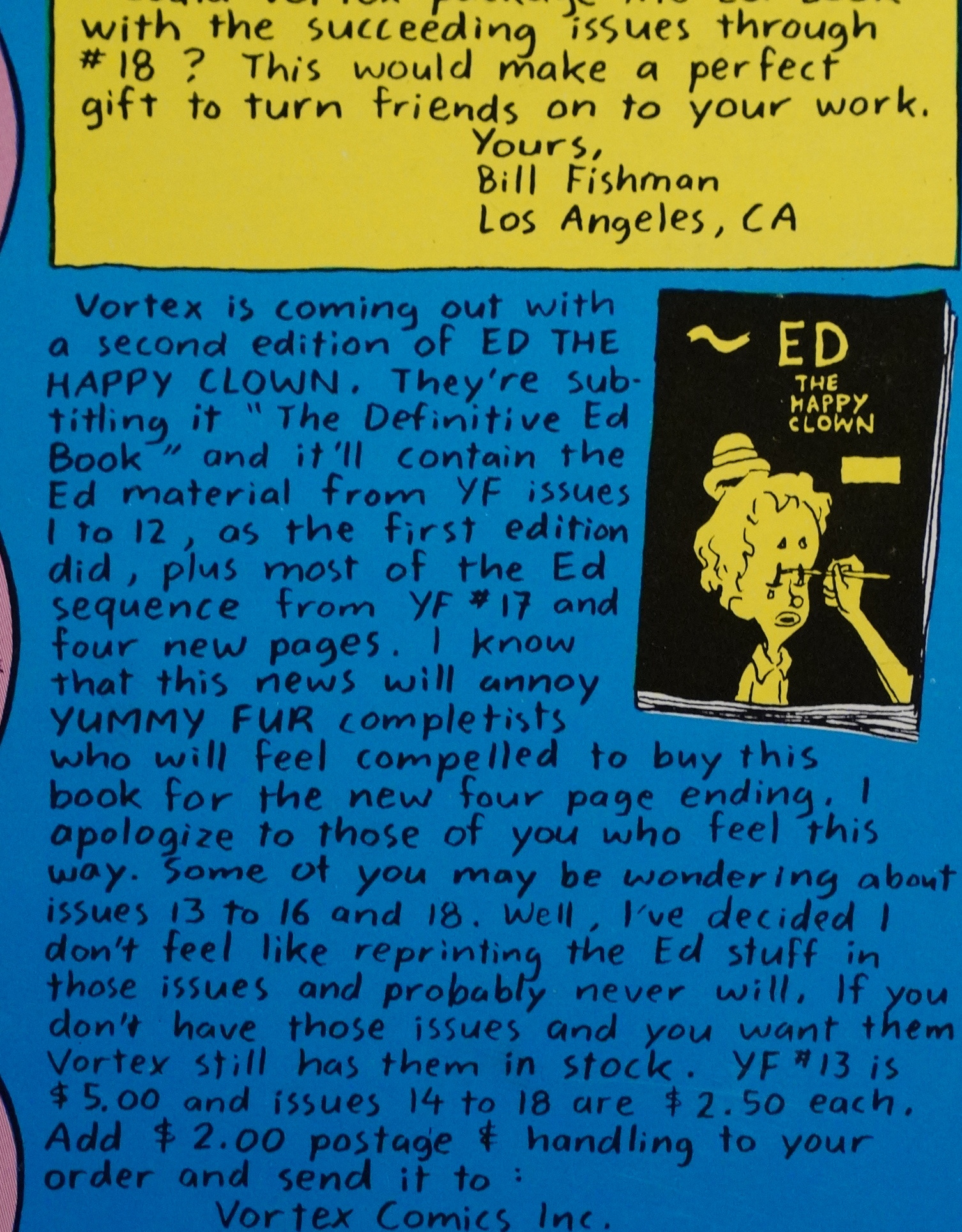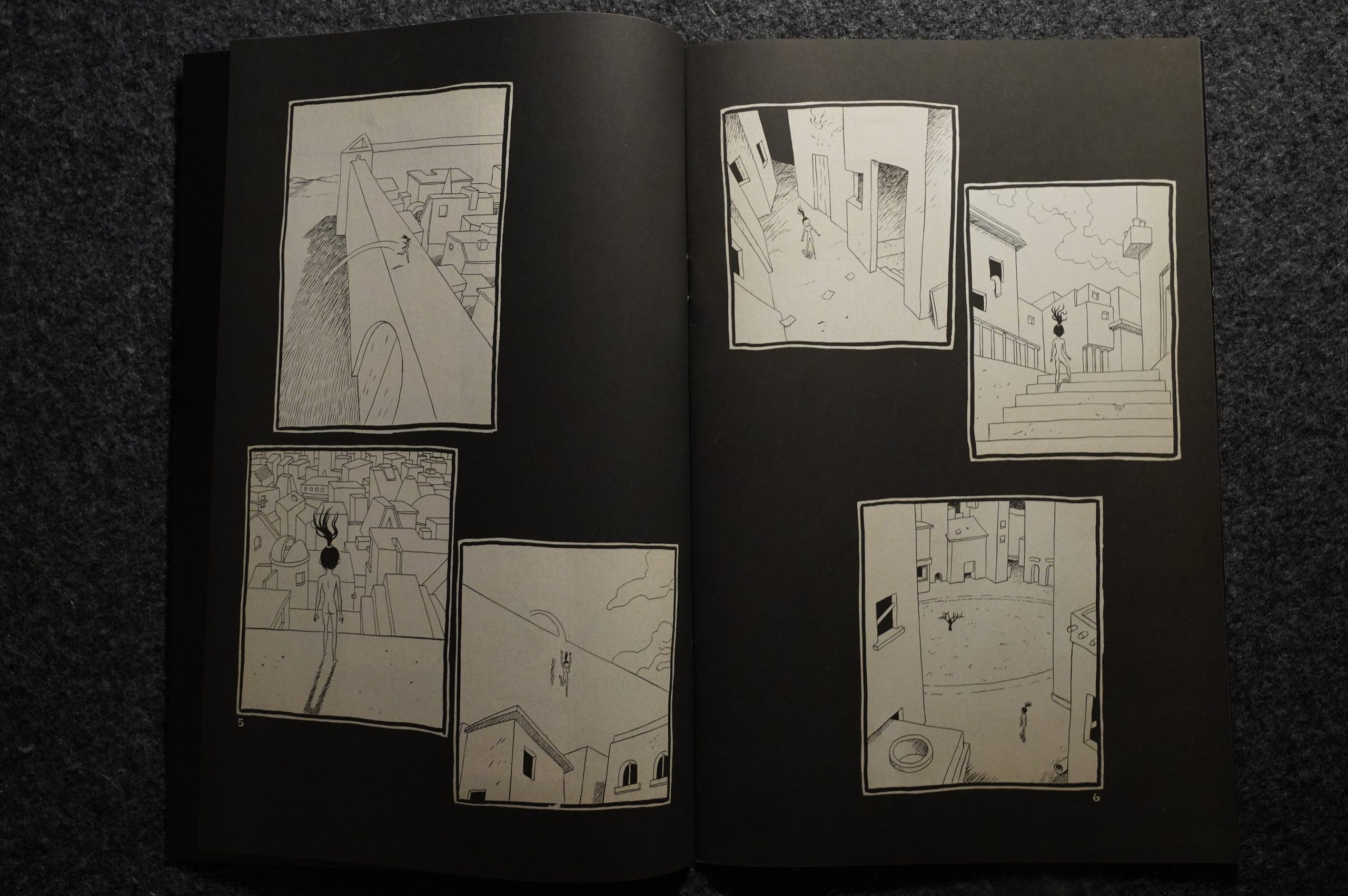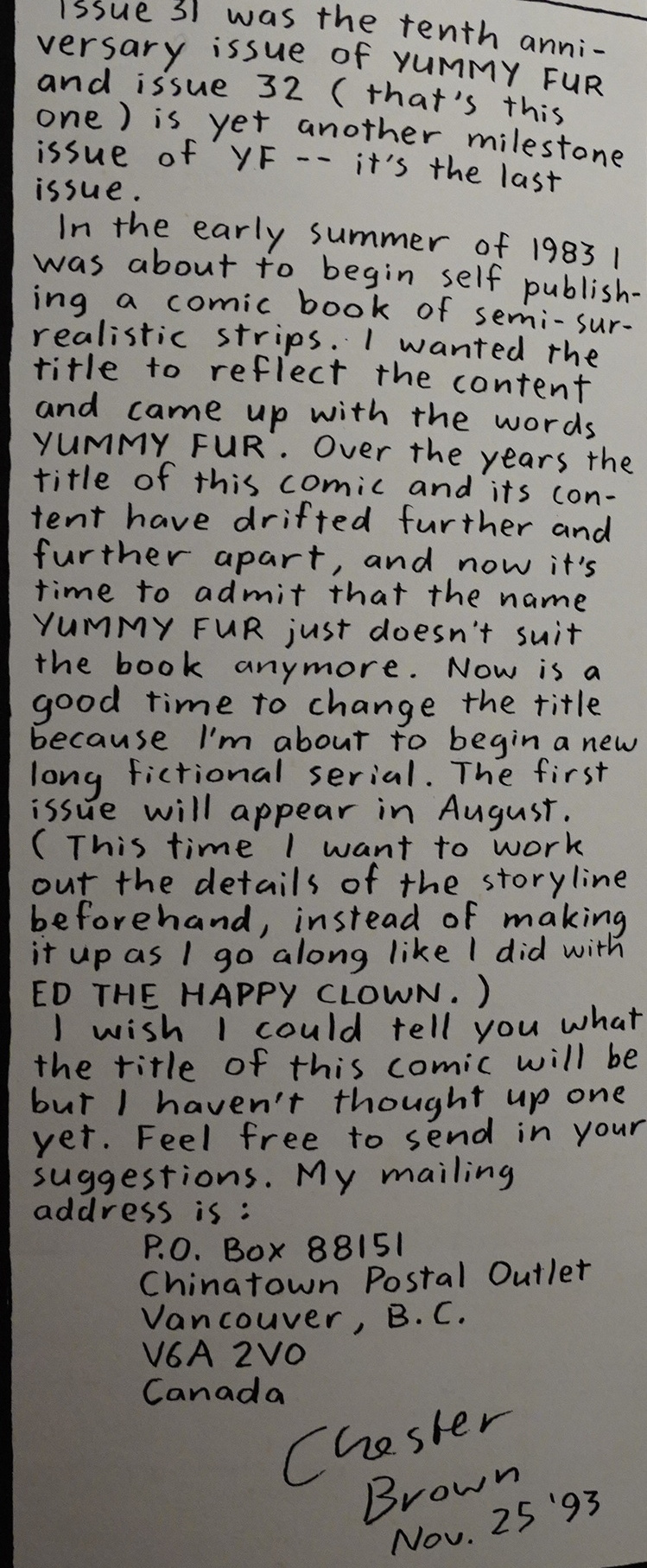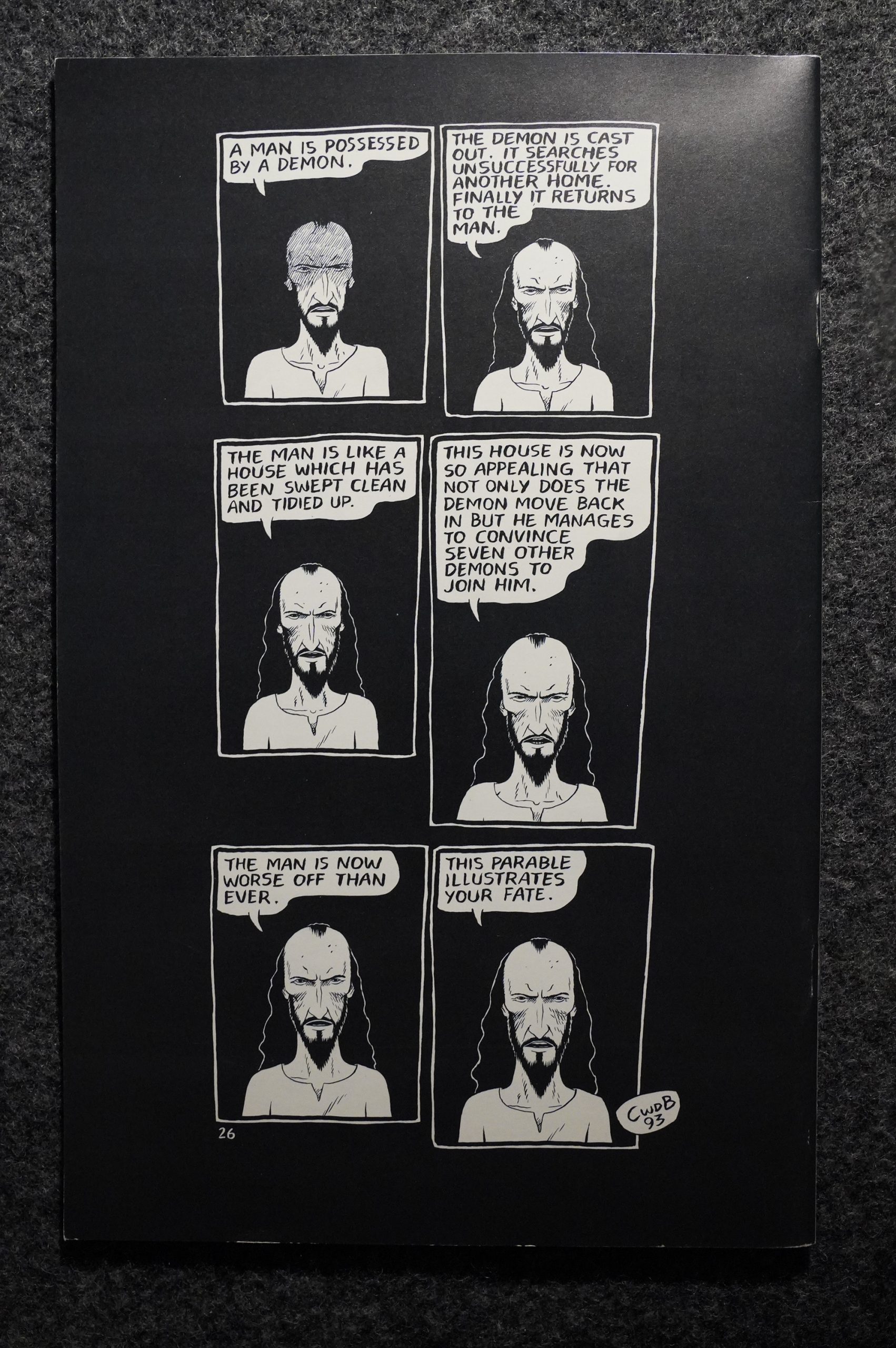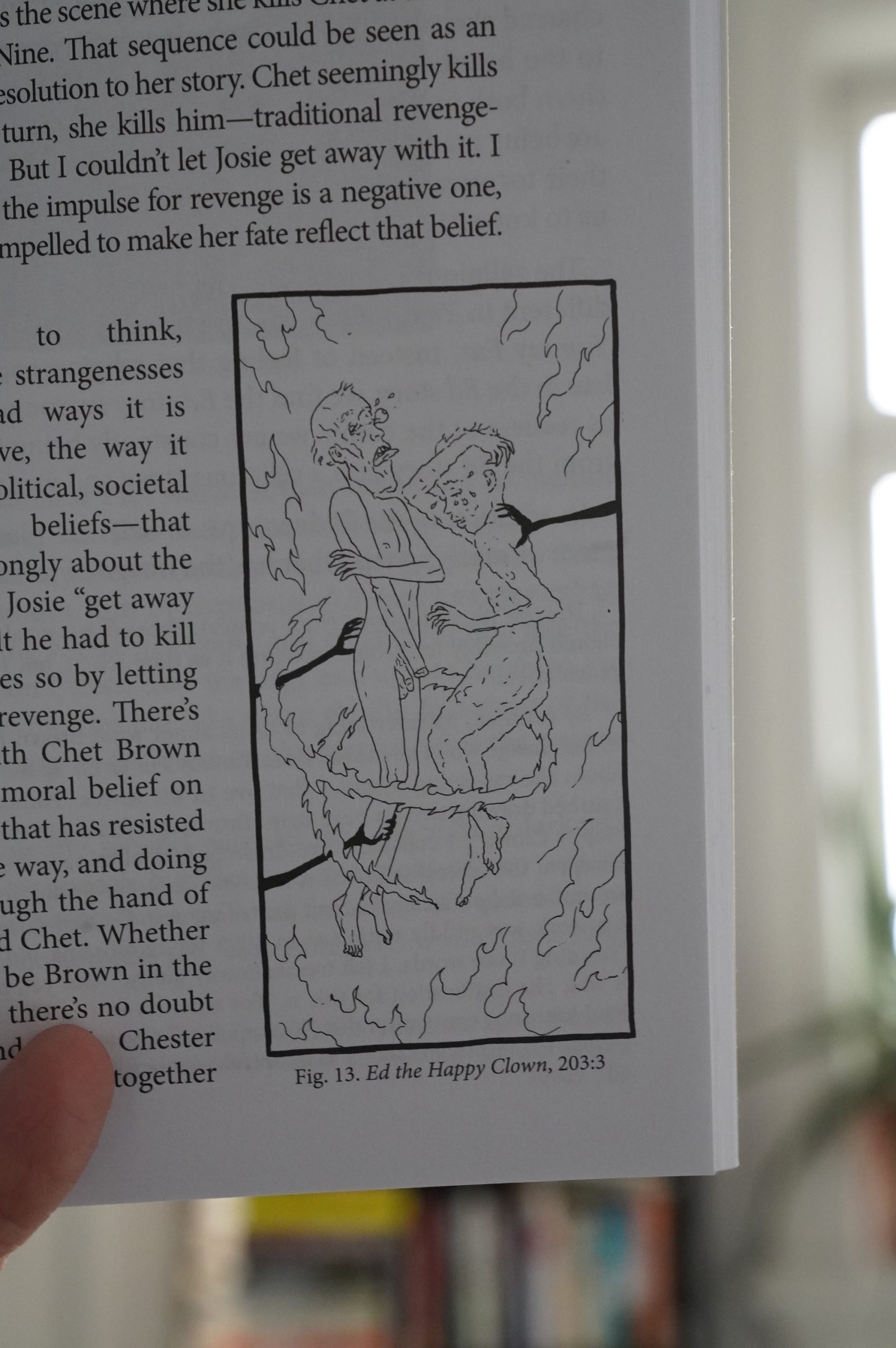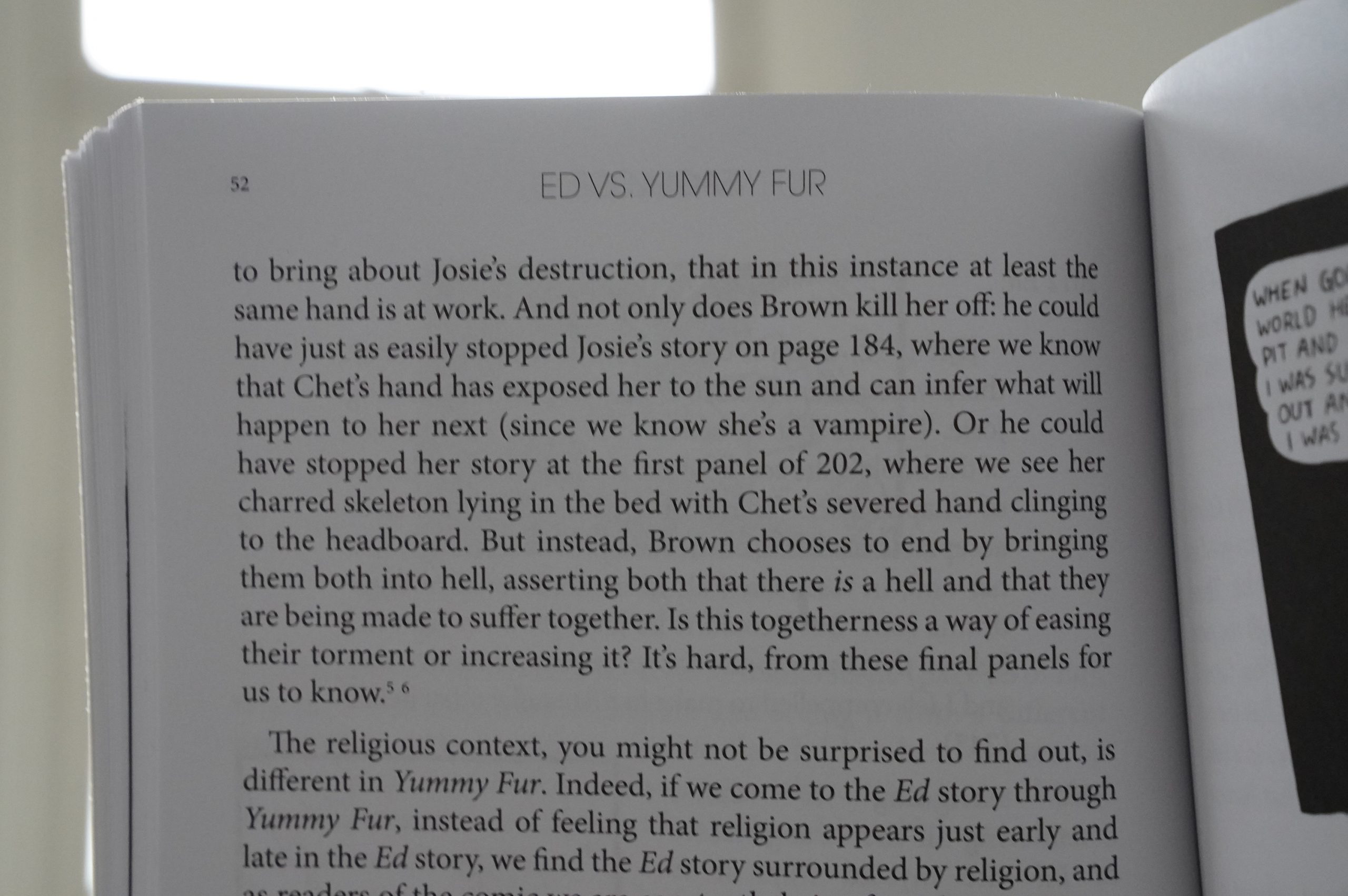Yummy Fur (1986) #1-24,
Ed the Happy Clown: The Definitive Ed Book (1992)
by Chester Brown
*gasp* In this blog series, today we’ve come to Vortex’ second claim to fame: Chester Brown’s Yummy Fur.
This was at the height of the black and white boom, and you could publish anything (as long as it was in black and white), and “collectors” would snap it up. That meant an avalanche of shit, of course, but it also meant that it was feasible to publish something as odd as Yummy Fur, too.
Brown is, of course, one of the most written-about comics artists in the world now, but did you know that his first series was at Vortex? You did? Why are you reading this, then!?
Some people!
Now, Yummy Fur was one of the things that made most of an impression on me while I was in high school (second-most: Throwing Muses), so I have an enthusiasm for the series that is perhaps not quite rational. But Yummy Fur is a series that has is, quite simply, gruesome; it’s drenched in violence (including sexual violence) and I’m including some of that imagery in this blog post (but not the most horrific stuff). So:
Unless you want to subject yourself to some pretty nauseating stuff. OK?
I actually read Yummy Fur before Vortex picked it up. Brown published seven issues of the series in mini-comic form. Well, not that mini, really — it’s not in twice-folded letter format, just once-folded. So it is, funnily enough, in just the same format that the collected Ed book would later be, and just about all of Brown’s books.
(Somehow I have two copies of the collection of the first six mini-comic issues. I could probably be a millionaire if I sold one, right?)
But that means we can do a comparative reading! The minis vs. the first three pages of the Vortex book. Here we have the first two pages in the first issue of the mini. It’s pretty rough stuff, but even we have those aliens here that would feature in the denouement of the Ed saga.
The Vortex series starts with a self-portrait of Brown (with his friend Kris) explaining that this is a reprint.
It looks pretty complete, as reprints go: We get the covers and everything.
Aaaand… Yes, it’s identical? I was wondering whether Brown had changed much between editions, because he’s a notorious tinkerer.
That’s the mini…
… and that’s Vortex. Here he has changed stuff up; not only has he added black margins, but also a inked in the title and the borders of that inset panel. Looks a lot more… solid.
The other changes are pretty minor, too. Like changing Calicak Creek to…
… Catick Creek. This seems like a rare instance of Brown doing reportage (it’s about how some city slickers tricked some farmers into paying for their sewage systems), and I wondered whether he changed the name to avoid, like, getting sued (or beaten up), but apparently neither name actually exists?
There is the occasional rejiggering of panels, like this one from the mini…
… and this one from Vortex.
Most comics artists (at least in the before-digital era) don’t shuffle panels around like this, but Brown draws each panel separately on a piece of paper, and then sticky-tapes them down on the final page. This means that he’s free to rearrange and replace panels at will, which he does. That also means that he doesn’t really design pages as a whole, often, which probably contributes to the unnerving pacing.
Mini…
Vortex with panels shifted one row.
Anyway! The main serial in Yummy Fur is about Ed the Happy Clown, and it’s a storyline that’s improvised. Things happen at random (like that janitor, Chet, losing his hand all of a sudden). But anything, no matter how much of a non-sequitur is later revisited and made, somehow, logical. The Ed series continues over the first 18 issues of Yummy Fur, so you’d think it’d cover a lot of territory, but it constantly folds back, giving more and more information about what’s previously happened, before lurching ahead a bit, and then looping back again. Everything seems random, but everything is connected.
I don’t know what methodology Brown is using, but I’m guessing he’s re-reading himself a lot and going “hm, that’s something that could be expanded upon”…
This page is really why I became a Yummy Fur fan boy. I couldn’t stop showing it around to, well, everybody I knew, because I found it to be the height of humour. I even defaced my high school by gluing a copy of it to the wall.
HAH! Statute of limitations! Can’t catch me now, copper!
It’s a classic piece of absurd humour, sure. Perfect in execution: “A loud, harsh, almost…. musical sound”. But it’s also somehow… unnerving? It seems to hint at something being awfully wrong somewhere.
This is funny, too, of course. And doesn’t it remind you of Crumb’s short history of America?
No? Oh well. Anyway, let’s look at how the Ed saga starts:
It’s so… it’s so… it’s ineffably horrifying. The panel of Ed breaking his leg is cartoon violence, but over the top, so we’re going “ha ha eww?”, and then a panel of real pain which makes us go “oof” and then “the rats!!” which is a horrifying escalation that draws us back into it being funny (but horrifying) again, and then a cut to somebody else.
It’s so… deranged. Masterfully deranged.
Brown was trying out a lot of different things at this time. It’s mostly the same kind of absurd humour, and it mostly works. (And that painting in the final panel ends up as the cover of the next issue, making another connection between things.)
Everything connects! Here the aliens from the first page of the first issue reappears, still looking for cows to mutilate.
That’s a pretty good summary of all the news stories about Jesus appearing on things.
And then the reprints are over.
Brown becomes more ambitious immediately: The artwork in the fourth issue is more confident and considered, and the storytelling becomes even better. The Ed story takes a detour into a story of the story of that saint who cut off his hand to not be tempted.
Although in Brown’s version, it was his wife that cut his hand off because he preferred masturbating to having sex with her.
And this is the only instance of Bill Marks censoring Yummy Fur (or anything else, I think?)
He put the panel back in the collected version of Yummy Fur.
Chet’s mom gives him some bad advice.
There’s a lot of body parts falling off and bodies breaking here, but more horrifying is the casual, normalised violence (like those two doctors beating that guy with some tubes). This could so easily have felt like all this is just for shock value; to make bros go “dude! bro!”, but instead if feels unsettling and unnerving. It’s in the little things, like the look the doctors give each other after one asks “shouldn’t that thing be in a splint?” (They don’t then do so, of course.)
Chet learned well: He cuts off that which offends him (i.e., he kills his lover while they’re having sex). Next page: Part one of the adaptation of the Gospel of Mark.
And it’s done seemingly totally straight, without any humour or criticism of religion in mind. (The bible adaptations continue to run for a couple dozen issues.) This juxtaposition, perhaps nowhere else as jarring as here, creates an additional depth to reading experience: You can’t help wonder whether Brown is trying to say something here?
Brown warns us that things are going to become really disgusting now.
Here’s the same page from the collected “definitive” edition: Makes sense to drop the warning here, I guess.
But what’s that whiter tab in the blackness? Yes! It’s where I put post-it tab! This is so badly printed that the post-it lifted some ink off the page! Now it’s not Near Mint any more! My pension! It’s worthless now! Noooo!
Anyway, it turns out that Ronald Reagan’s miniature head has become attached to Ed’s penis. (That’s what the warning was about.)
(No, he doesn’t look like our Ronald Reagan, but this takes place in a different universe, he said in Comic Book Guy’s voice.)
Brown recommends Donald Duck.
Heh heh.
I like the “maybe”.
Yummy Fur also gets a letters column. It’s got a lot of famous people saying nice things about Yummy Fur. This is a rare issue that has a typeset column; all the other ones are hand-lettered.
There’s also some odd-balls writing in.
What? Is that a different kind of mustard plant?
I thought they looked like this…
Hm, I googled, and (some) christians seem to interpret this a Jesus making a joke?
Well, whatever.
I think it does answer the question. Religious damage.
So what did the comics world think of all these penises, mutilations and Jesus? Well, the biggest comics distributor, Diamond Comics (now the monopolist in the US) refused to carry it.
CM (?) writes in The Comics Journal #121, page 9:
DIAMOND BACKS DOWN
Diamond Comics Distributors is now
willing to carry Puma Blues, and is
also willing to discuss distributing
Vortex Comics’ Yummv Fur, which it
had not carried since last August,
according to Diamond’s national
account representative Bill Schanes.[…]
Yummy Fur: [William] Schanes also told the
Joumal that Diamond is now willing
to discuss resuming distribution of
Yummy Fur. although publisher Bill
Marks told the Journal he had not been
notified Of that as Of early March.
Diamond stopped carrying Yummy
Fur last August and. according to
Marks, cited low sales as the reason.
However, Diamond continued to Carl)’
two other Vortex titles with even lower
sales leading Marks to believe that
Yummy Fur was singled out because
of the book’s adult content. Marks said
he would not have objected if the deci-
Sion was based on content, but he was
offended that Diamond wasn’t more
forthright in stating that reason.
Schanes said he did not remember
how Yummy Fur ‘s sales compared to
other Vortex titles at the time of the
books discontinuation. But he said
Yummy Fur sales were very low, ”
and “There was stronger material we
could put on the order form.” in Yum-
my Fur’s place.
Schanes said the books content did
enter into Diamond’s decision not to
carry the book. “l think it was a milwr
issue, yes. ”
Beginning with the next issue.
Marks said, he will be publishing
Yummy Fur under a new imprint, Fab
Comics, in order to divert distributors’
prejudice away from Vortex. Marks
will own Fab Comics wholly, distinct
from the partnership Vortex Comics
recently entered with the Canadian
retail store Silver Snail.
Three years ago, Marks said, he had
a similar problem with Diamond when
they would not distribute Matt
Howarth’s Those Annoying Post
Brothers. Diamond also recently
indicated to him that they might not
distribute Howard Chaykin’s upcom-
ing Black Kiss, after he described to
them the book’s erotic-horror
contents.
In order to restrict Black Kiss to
mature readers, Vortex is labeling and
pre-bagging it. Schanes told the
Journal, that Diamond would be
taking the comic book.
So Diamond claims that the contents had nothing to do with it; the sales were too low. Riiight.
Marks’ plans to create an imprint just for Yummy Fur didn’t happen, but it’s pretty amazing of Marks to keep the book on under these conditions.
An interview in The Comics Journal #135, page 90:
GRAMMEL: One thing I haven ‘t touched on is your om
particular experience with what some would call censor-
ship by Diamond Comics Distributors. I know it ‘s been
resolved, bur could you tell me how that affected you ?
BROWN: Hmm… well, on the one hand, 1 did feel he
was within his rights. If Yummy Fur was genuinely of-
book that he didn’t like? But it certainly was annoying
for me. I lost a lot of money.
GRAMMEL: He was carrying it and then he stopped,
so you saw sales drop from what they had been.
BROWN: Yeah, dropped quite dramatically. I mean, I
think he was like a third of our sales.
Brown starts his notorious tradition of doing notes to his pages. I think his most recent book had more pages of notes than of comics?
That is a good question.
Heh. Very Kirby panel.
She’s that woman that was killed way up there, and she’s explained how the world works.
Fuck, indeed.
Oh, that’s what that drawing was about: The thing about Yummy Fur possibly not being a Vortex comic any more was about that separate company that Marks was supposed to create. That’s less dramatic than I thought.
Bill Marks also weighs in. For a publisher (of his era), he doesn’t show up a lot in the comics he publishes.
And then we’re at issue 12: This is how the Ed story ends in the collected editions. In the comic book, it doesn’t end until issue 18, which I guess means that Brown felt that those issues were weak?
I thought the Mark adaptation was a fun read for the first few chapters — it zips along. As we get further and further in, Brown seems to want to keep more and more of the verbiage, and it becomes a bit tedious sometimes.
So these are The Forbidden Ed Stories: Pure domestic bliss. Or, er, not.
But I do kinda see why Brown wouldn’t want to include this in the collections: It’s something of an anticlimax after the sheer terror of the first dozen issues.
Practical! I should try that.
I think the Ed serial continues to be pretty funny, but you can see that Brown isn’t that into it. In one issue, we only get nine pages before Mark takes over.
And this is how Mark ends. OOPS SPOILERS Jesus dies and is resurrected… But Brown doesn’t show the latter, which either means 1) that’s the point, og 2) he was pretty fed up with his approach to adapting the bible, too.
Yeah, I don’t think you’re supposed to imitate all parts of Jesus’ life.
We can only hope!
Their hopes are dashed! No cows!
But more importantly, after Mark is over, Brown starts adapting Matthew. Has a certain logic to it, I guess?
The style is completely different: More of a loose interpretation with scenes like this that aren’t, strictly speaking, in the bible. Everybody get bigger noses, too.
So I can see why Brown rushed through the Mark ending (if he did): This is much more fun to read, and (I imagine) fun to make.
After a couple of… “softer”… issues, Brown throws down the gauntlet in the 16th issue. Here’s Nancy Reagan and her husband in bed, performing sex acts that I don’t think will take off in popularity. (It gets more disgusting later in the book, when she meets the little Reagan.)
Likewise, the Matthew adaptation becomes super-icky, so I wonder what Brown was going through at the time. (I’m not showing you the wish being carried out.)
Then, in issue 18, we get an all-Ed issue, and Brown brings the serial to an end. He’d meant for Ed to go on for quite a while, so Vortex published a collection of 1-12 recently, but then, while Brown was doing issue 17, he decided to end it. I mean, end Ed. The serial. You know what I mean.
Which was kinda odd, because you can’t really publish a collection of something as brief as the Ed from #13-18 in a collection. I guess thems are just the breaks when you’re improvising…
Heh, heh. Cute.
This was all… solved… by Brown refusing to have the issues in question reprinted at all. Instead Vortex published a “definitive” edition a couple years later, which reprints the Ed stories from the first twelve issues with little editing, but added a different ending than the one we got in issue 18. But they have a lot in common.
In the collected edition, Josie (the woman who was murdered while having sex) goes to hell, joining her killer there, while crying.
In #18, the ending takes a bit of a different turn: It seems that both Josie and Ed are ending up in a good place (after some further mishaps)…
But then Josie dies anyway, and this is the final page. Not very ambiguous, but slightly less sad, perhaps.
“Je pense”, the creator poses.
Some readers were a bit dense, but took offence to issue #16, as they should.
Charles Burns was really impressed, though.
I do wonder whether the reaction to #16 had any influence in Brown’s decision to never reprint those issues, though.
So… Ed’s over: What next? Autobio, of course. It was all the rage at the time, and Brown’s first foray into the genre isn’t quite successful.
I don’t think I’ve read these issues since that time (I read the first dozen issues dozens of times, I think), but I remember really liking them. I’m not so impressed this time over: The Helder story seems pretty anaemic and tentative.
The next issue has the infamous Showing Helder story, which is about Brown drawing the Helder story, and showing it to people to get their reactions to it. I remember this story being held up as the prime example of why autobio comics was a crime against humanity: “Could you be any more self-centred and dull?”
I absolutely loved the story at the time: It felt like a real peek behind the scenes. Here we have Brown showing the story to Kris and Seth. Thrilling!
But again, this time over, I thought the story felt a bit weak… perhaps the critics back then were correct?
I think it’s the borderless panels that bothers me.
Here’s a look at Brown’s unique technique.
Huh. Is that how Bill Marks looks? I imagined him more… er… rakish.
We then get a three-part autobio story from Brown’s teenage years: The Playboy Stories. It’s about Brown buying and throwing away and re-buying Playboy magazines.
And it includes this scene, which illustrates Brown’s masturbation technique. It was parodied a lot, like in this Jeff Wong/Scott Russo strip:
So, yeah, Brown takes autobio to new heights, or depths. I mean, you can’t say that it’s not memorable… but again, I find that reading these stories now, they feel slight and not particularly well-structured.
Matthew also has its ups and downs: Brown mostly keeps things moving along, but for that speech on that mount, he keeps a lot of text.
Brown was interviewed in the Comics Journal at the time…
… where he said some derogatory things about Comics Buyers Guide (and their readers). Here he clarifies.
Oh, the pains of doing autobio comics.
Who could disagree with Kris?
Gary Groth writes in to comment on Brown’s comment about CBG and the Comics Journal.
This is pretty much the general feeling on the letters pages: People don’t really like the new autobio direction Yummy Fur is taking.
Perhaps in response, Brown does autobio… but about a shaggy dog story he told to a friend when he was like twelve. It’s funny.
Those masturbation scenes sure made an impact!
And then it’s over: Yummy Fur moved to Drawn and Quarterly, so here’s where I stop my coverage of the series. In the first D&Q issue he explains why he moved: They promised more money, and he thought he’d be doing D&Q a favour (since Yummy Fur would be the biggest-selling thing there instead of the lowest-selling thing at Vortex).
He also expresses gratitude towards Marks for sticking by Yummy Fur all these years.
There would be just eight issues of Yummy Fur at D&Q before Brown ditched the name and went on to publish Underwater and Louis Riel and other things, before becoming a best seller later with books like Paying For It.
The Matthew adaptation continued to run in the book, but didn’t finish. With his style of adaptation, it would have taken many hundreds of pages, I think…
So: One last remark about masturbation, and we’re through.
But! Hang on! I forgot to check what the critics had to say about Yummy Fur at the time.
Dale Luciano (I think) writes in The Comics Journal #96, page 60:
During the summer of 1983, Chester
Brown of Toronto began publishing Yum-
my Fur, an eight-page digest-size comiö, at
the insistence of his poet-girlfriend.
Brown’s comix are a funny admixture of
genre parody and social satire, with each of
the six issues of Yummy Fur spinning off in
Ed the Happy Clown, from Yummy Fur #2, by
some new and frequently absurdist direc-
tion. In the now out-of-print Yummy Fur
Brown’s explanation Of mysterious
cattle mutilations, “Walrus Blubber Sand-
wich,” has CIA operatives piloting a flying
saucer and mistaking walruses for cows.
‘ ‘The Toilet paper in the same issue
patodies schlocky science fiction by offer-
ing the spectacle of rolls of toilet paper con-
quering the world. “Bob Crosby and His
Electric in Yummy Fur is astUte
satire, presenting the surreal situation of a
TV set which controls and manipulates the
behavior of its weak-willed owner. (The
TV sends Bob Out on various right-wing
seal-hunt project is a lot of
nonsense,” the TV commands, ‘Go to the
zoo and club a few when Bob
destroys the set in a rage, he’s utterly lost
and immediately seeks another, identical
model.) In few other stories, Brown
satirizes such contemporary phenomena as
imagined religious visions (“Adventures In
Science,” YF ‘6) and urban paranoia
(“City Swine,” YF #4).[…]
The only disap-
pointing issue of Yummy Fur has been ‘4
(Brown has let it remain out-of-print),
which features a disjointed and ultimately
incoherent nightmare-story about a man
asked by a government agency to pose as a
notorious criminal. (There’* also a bizarre
comics Story about a professor studying a
giant squid’s masturbation techniques that
scores points for sheer oddness of concept.)
In sum, Brown’s is an unpredictable dada
world in which absurdism the grotesque
frequently commingle, to simultaneously
amusing and disturbing effect. Brown pro-
duces Yummy Fur under the publishing
banner “Tortured Canoe,” which in itself
says something. “l was totally unaware of
the ‘newave movement,’ and my only
models were the Toronto small press
poetry publishers,” comments Brown.
“Then I saw Peter Dako’s Casual Casual
Comics and Kat Cruickshank’s NO Name
Comix and quickly found out all about the
folks all over the continent who were doing
more or less the same thing.”
Steve Monaco writes in The Comics Journal #107, page 56:
[…]
Brown’s dark car-
tooning style coupled with his fine, fresh
humorous approach to horror and paranoia
makes the book one of the most accomp-
lished titles in the burgeoning small-press
movement.
Like most self-published affairs, Yummy
Fur’s history is an erratic one, with small
print runs for the early issues and a schedul-
ing that hints at both the joys and difficul-
ties Of this wonderful format. At the begin-
ning, Brown’s output was prolific (as it often
is with.artists publishing their own work for
their own satisfaction): issue ‘s I and 2 were
both published in July 1983, with issue
appearing the following month and issue
the month after that. Issue 5 and 6 both
followed fairly soon after January and
March 1984, respectively), but then there
was nothing more until issue finally
appeared in September of last year. The
nearly year-and-a-half gap in Browp’s out.
put of new material indicates how hard it
can be for today’s comix artists to find the
time to continue to do their own personal
work (a near-universal problem), but in
Brown’s case, judging from his most recent
published work, this silent period has
brought forth work even better than his
previous collections.[…]
Brown himself seems to be one of the
smartest minds in comix today. (On the
back page of this reissue collection, he lists
among his main creative influences both
Carl Barks and Nikolai Gogol; he’s one of
the few comix artists who can make a state-
ment like that and have me believe he really
means it.) The blend of his writing and art-
work is nicely complementary, with his
sometimes murky drawings lending an
added sinister quality to his deliberately
light and silly dialogue. To his credit, Brown
does not weight his satire with the kind Of
injoke fan humor that mars too many of the
funny small-press titles, and when he does
lean toward pop-media mockery, he focuses
his parody on the more universal bad influ-
ences that permeate everybody’s lives, not
just the insular comics community.
An interview in The Comics Journal #135, page 82:
GRAMMEL: How many copies of Yummy Fur were
selling by the end Of its life as a mini-comic?
BROWN: I’d print a couple hundred at a time, but I’d
reprint as often as necessary. So I guess for some issues
it got up over 1,000.
GRANM_EL: Tell me about how you made the junp from
your mini-comics Status to haying your own comic book,
Was that a big thrill for you?
BROWN: Oh, yeah. It was a big thrill. I was doing Yum-
my Fur, but it was getting to the point where I was
wonderine, “Am I going to be doing Yummy Fur as a
mini-comuc for the rest of my life?” I wasn’t sure. At
a couple points I’d said, “No, I’m giving up doing mini-
comics. ” Because at this point I was also starting to get
people like Fantagraphics and Kitchen Sink asking me
for submissions to their anthology magazines like Honk!
and Prime Cuts and Snarf, whatever. So I was kind of
wondering, you know, “This is great, but I’m not going
to make money off of this. ” So one day early in ’86 Bill
Marks phoned me up out of the blue. I was out late do-
ing something, and right when I get home the telephone’s
ringing. So I answer it, and it’s Bill Marks apologizing
for calling so late and hoping he hadn’t woken me up,
but would I like to do Yummy Fur as a comic book for
Vortex. And so I said, “Well, it sounds good. Let’s get
together and talk. so we did. He convinced me to go
with him. It wasn’t all that hard to convince me, actual-
ly. Well, I did have some reservations — hearing about
the Hernandez brothers and other rumors and stuff about
Bill that I’d heard. I’d met him a couple of times before,
and he always seemed like a nice guy. I always got along
fine with him. So I was taking what I was reading in The
Comics Journal with a grain Of salt, not being sure how
much… You know, thinking, there’s always two sides
to ev story.
GR”fEL: Did he naturally assume that you ‘d have
ownership of the comic book?
BROWN: Oh, yeah. That was never a question.
GRAMMEL: IA me ask you this. Do you work with
a contract?
BROWN: Yes, 1 do. [laughter]
GRAMMEL: I’m guessing that your Contract is for a
limited time. Have you received any Offers to transfer
Yummy Fur to another company?
BROWN: Oh, I’ve definitely gotten offers.
GRAMMEL: Do you feel loyalty to Bill Marks because
he was the one who made the effort when no one was
knocking on your door?
BROWN: Precisely. I do feel some measure of loyalty
to Bill, and I’m not going to leave Vortex just for no
reason, and I get on with him fine. I have no problems
with him. He lets me do whatever I want.
GRAMMEL: You don’t want to be in color, so that’s
not a problem.
BROWN: No, I am happy with black-and-white. So I
don’t foresee changing companies in the near future. I
don’t foresee changing companies at all unless I have to
for some reason. And also it’s just easy working with
Bill. I was going to say he’s here in town, actually he’s
just about to move out. Vortex is moving to Picton. Pic-
ton, Ontario.
Robert Levin writes in The Comics Journal #162, page 49:
That the series is on-going enriches the experience.
The continuity, the development, the regularity of the
issues appearing Over time, under a single title, product of
a solitary consciousness, makes it like scheduled visits
from a strange but evolving friend. Yummy Fur becomes
one unified, wondrous work, familiar and cohesive, not
some fragmented series, distanced, strange. Reading it
continually enriches and surprises.
Robert Rodi writes in The Comics Journal #123, page 45:
Yummy Fur brilliantly achieves
everything that Blood so vainly gmpes
for. It has the disturbing imagery; it
has the Oddly repellent beauty; it has
the passion and the poetry and the
perversity. And best of all, it’s the
work of an honest-to-God cartoonist:
Chester Brown, the most exciting new
talent this medium has afforded us
since Los Bros Hernandez. His work
is of that caliber; it’s fresh, confident,
fully-realized, and ambitious.
Brown initally published Yummy
Fur himself, as a 25 cent mini-comic.
Vortex Comics reprinted those
remarkable early issues (covers and
all) in the first three numbers of this
new run, and subsequently they have
allowed Bro,vn to really cut loose. The
result is a comic of surpassing critical
acclaim and almost no popular
reputation—a true succes d ‘estime.
Perhaps even more so than Inve &
Rockers—which at this juncture is a
known quality, however excellent—
Yummy Fur is the most adventurous
and important continuously published
series now in the shops. Yet the public
remains either ignorant or unmoved.
(At a recent convention I found Yum-
my Fur back issues stuffed away in a
“10 cents each” box, along with
doomed-at-birth copies of Aircel and
Solson comics; an appalling state of
affairs.)[…]
It’s an audacious move, however; as
upsetting as “Lost in the Sewers”
must be to some readers, I have a feel-
ing “Mark” might upset others even
more, for several reasons—first,
bcause of its proximity to something
as powerfully irreverent as the lead
feature; second, by its lack of senti-
ment, either mocking or worshipful.
Brown, being an artist, has no concept
of packaging; the two features in
Yummy Fur are representative of the
hilly terrain that makes up his own
fertile mindscape; they’re the two
sides Of his ideological battle, and
each, in its own way, is winning. And
if that’s not enough to draw readers,
well—then it’s not. I can’t imagine him
changing the book to make it more
marketable, or even more accessible.
For which we may be thankful. As
it is, this is such a rich experience.
all means, do read Yummy Fur.
R. Fiore writes in The Comics Journal #118, page 47:
The first all-new issues Of Chester
Brown’s no-longer-mini comic are the
best exploration of Christian mythology
since Justin Green’s Binky Brown. They
combine a disturbing, phantasmagori-
cal comedy Of excessive Christian guilt
with a quiet, moving, almost childlike
retelling Of the Book Of Mark. Together
they form a bemused commentary on
how ideas become distorted. It’s as if to
say that “the beginning of the gcxxl rwws
of Jesus Christ” was quickly followed
by the beginning of the bad news of
human beings. Brown’s humor is simul-
taneously cool, sardonic, and deeply
sympathetic. Yummy Fur is another
example of how a larger format can
stimulate artistic growth. The main Story
begins in Yummy Fur #3, but if you don’t
have them, you want the whole set.
Chris McGubbin writes in Amazing Heroes #181, page 85:
In Yummy Fur #s 19 and 2(), Brown
has abandoned the hellishly famili-
ar alternate world of Ed the Happy
Clown and turned his artistic eye on
himself. He seems to be coming toe
grips with the fact that Yummy Fur has
carried him to a pinnacle of artistic
acclaim (if not financial success) that
must have seemed the remotest of pipe
dreams when he began.
This issue, in an audacious act of
self-reflexivity, is an autobiographical
piece about the making of last issue,
another autobiographical story.
There seems to be a trend among
really great cartoonists to begin their
careers doing fantasy and eventually
gravitate toward realism. This can be
seen in the work of superior artists as
disparate as Will Eisner, R. Crumb,
and Jaime Hernandez. Usually this
change is marked by a period of
uncertainty, follmved by an even high-
er plateau of the artist’s genius.
Nonetheless, I hope that’s not what
Brown’s doing here. His dark and
intensely personal fantasy world is not
like the generic trappings Eisner and
Hernandez put aside, or even the
drug-induced in-jokes of Crumb’s
early uork. Brown’s worldview is rich
and complex—it can best be compared
to the novels of William Burroughs—
and deserves years more development.
I’m encouraged that while Brown’s
lead stories in YFhave lightened, his
back-up features have darkened almost
to the soul-shakingly stygian level of
the Ed stories. This tells me that the
fire still burns.
This issue is also an artistic depar-
ture for Brown. The art is minimal—
mostly figures with few or no back-
grounds, done in a free-floating,
borderless layout reminiscent of some
of the more evocative work of Eisner
and William Messner-Loebs. It’s
talking heads, truth to tell, but that’s
O.K. when the ‘heads are. saying
something.
This issue is not the height of
Brown’s genius. U’s a respite, for both
artist and reader. I do believe the
savage brilliance will return when
Brown and his demons are ready. In
the meantime, this is a necessary step
in Brown’s ongoing artistic develop-
ment, and fascinating reading for that
reason and more.
GRADE: ! ! ! ! 1/2
You get the idea. Yummy Fur was written about… a lot. Which isn’t surprising.
Oh, yeah, there was a book written about it recentlyish:
It does not intend to catalog every change between Yummy Fur’s Ed and the 2012 Ed edition, but it will examine different types of changes that occur, consider what these changes mean as Ed moves from mini-comic through comic-book series to graphic-novel, and ultimately try to give a sense of how the graphic novel differs from the Yummy Fur material that gave birth to it.
I’ve even got that book, but I was waiting to read it until I’ve re-read Yummy Fur, which I now how, so… I guess I should?
Huh. People want a lot of money for the Yummy Fur issues there days? Well, I guess that makes sense, since there’s bits of it that has never been reprinted.
Anyway. There you go. And I guess the warning at the top there was superfluous, since I didn’t include any of the really horrifying violence in this blog post anyway.
You’re welcome.
Edit:
OH, OK! I wasn’t going to write anything about the Drawn & Quarterly issues, but they were *right here*, so I ended up reading them now anyway. So:
You’d think Brown couldn’t get any more personal in the autobio stuff… you were wrong.
Now that’s a way to resolve a conflict.
The Matthew adaptation continues, and it’s pretty funny in places.
I guess some people wondered: I didn’t.
A reader asks whether the missing Ed chapters will be collected, and Brown says n, but not why he doesn’t want to have them reprinted.
Brown’s now reached his “mature” style: A random number of panels floating around the page, which he uses to this day. A reader complained that this style leaves a lot of blank space, but Brown says that cramming a lot of stuff onto the pages just looks wrong to him now.
And this is part of the four-issue “Fuck” serial, which is from Brown’s teenage years, and… ouch. It’s downright painful to read. In a good way, of course.
I wonder whether there’s any symbolism in this penultimate issue, where a woman scales a forbidding wall and enters the city. In presumbaly totally unrelated news: Brown’s met Sook-Yin Lee.
Brown announces that he’s ending the series, because the contents and the name doesn’t suit each other any more.
And the final issue is all Matthew, and it’s not… all that interesting.
The adaptation continued in his next series, though, which was called Underwater. He said up there that he wanted to have it plotted out before he started, but apparently that didn’t help much: He made 11 issues and then abandoned the project.
Edit some weeks later:
I finally read Brian Evenson’s little book “Ed vs. Yummy Fur”, published by Uncivilized. It mainly examines the differences between the comic book series and the final Drawn & Quarterly version of Ed. It’s somewhat interesting, and it’s perhaps inadvertently funny in the way that Evenson speculates about what the various differences mean, while Brown consistently says stuff like along the lines of “I left out the bits that sucks” and “I just had to create comics faster for the bi-monthly book, so that’s why it’s so sloppy” (I’m paraphrasing).
And I know I shouldn’t find stuff like this irritating; let all the different readings bloom, but I just found some of Evenson’s takes so … bone-headed. And much of it perhaps stems from him being religious? I’m just guessing. Like:
Here we see Chet (without his hand, because the hand is still alive, most likely with Baby Jesus in heaven) and Josie, the woman he deliberately killed while having sex so that she’d be doomed to eternal agony in Hell (and who then became a vampire and Chet’s hand then extra-killed her so that she’s finally in Hell), being pushed together by demonic arms, in eternal agony. So not only does Josie have to suffer for eternity, but is pushed together with the man that gave her that fate. And here’s Evenson’s take:
“Is this togetherness a way of easing their torment or increasing it? It’s hard, from these final panels for us to know.”
NO IT FUCKING ISN”T. Get a grip: Josie’s being super-extra tortured, because the Ed world is a sucky place with horrible, horrible moronic and arbitrary rules; basically world where a satire of Catholic dogma is how the universe actually works.
Oh, and that’s another thing: Evenson calls Ed’s world “our world” and the other dimension is… not? While they’re both obviously not our world, so that’s just another bizarre reading. And this book is full of them; Evenson sees ambiguity so many places, and then gives a take that’s just… “wat”.
This is where you’re supposed to say “great art is open for interpretations, and we all bring our own selves to the table when reading and blah blah blah”, but sometimes a reading is just wrong. There. I said it.
Oh, yeah, and the discussion of the differences between an album and a graphic novel? Really?
ANYWAY.
This blog post is part of the Into the Vortex series.
